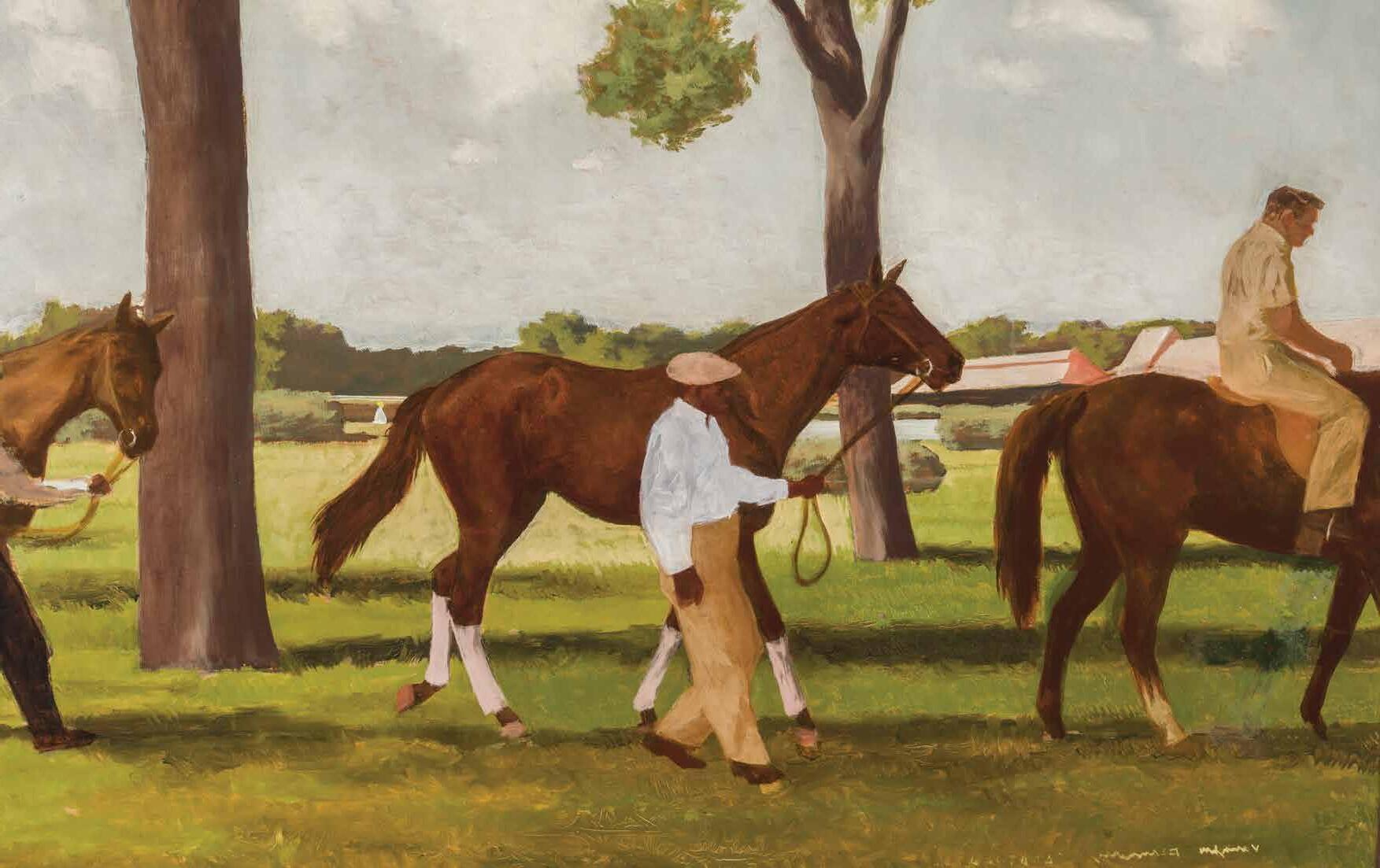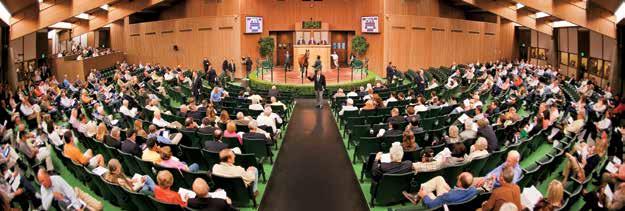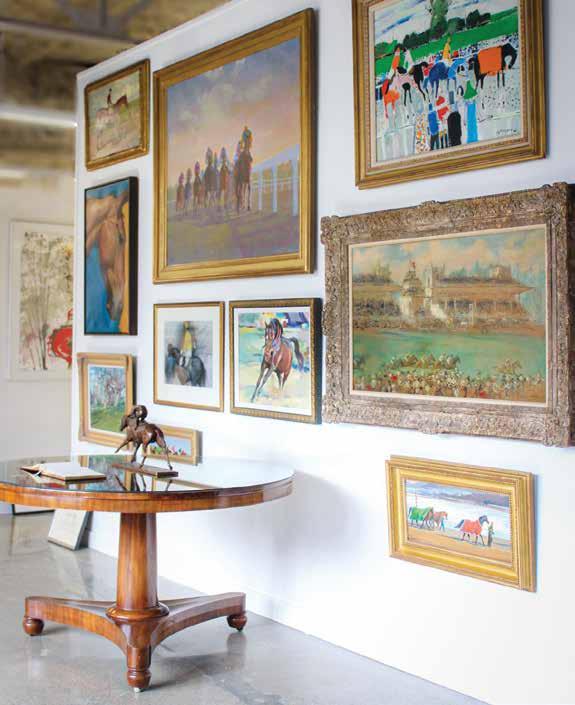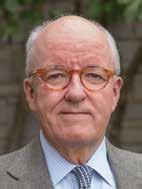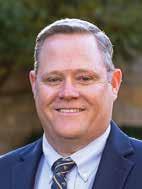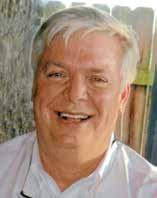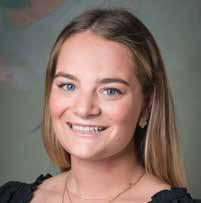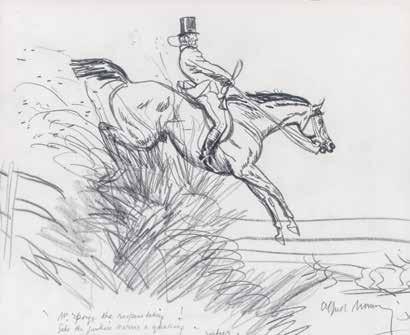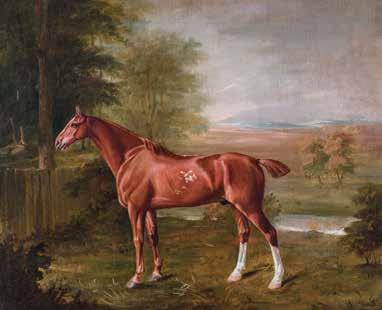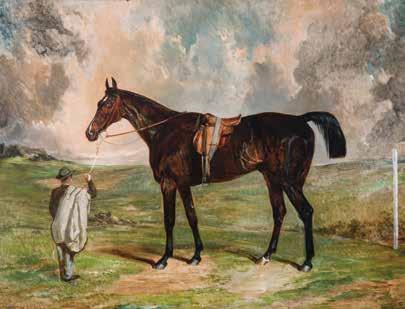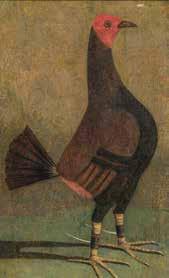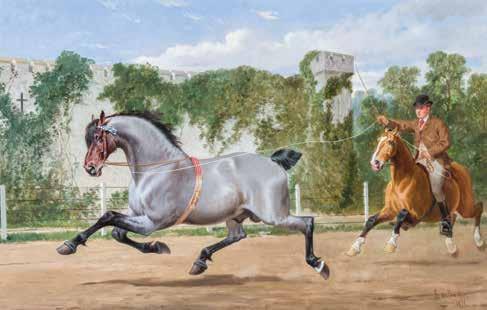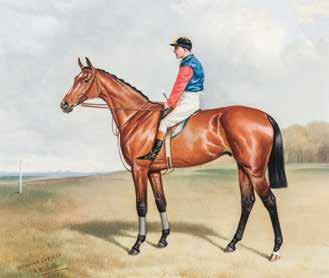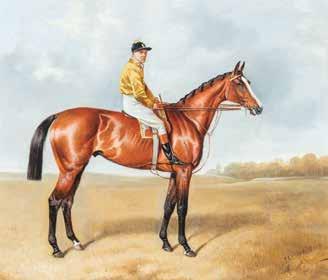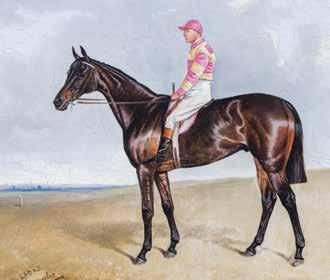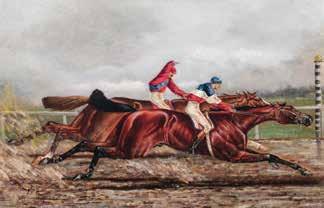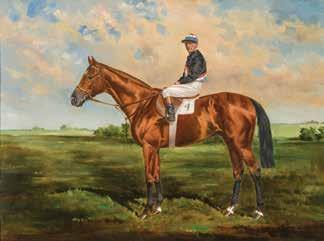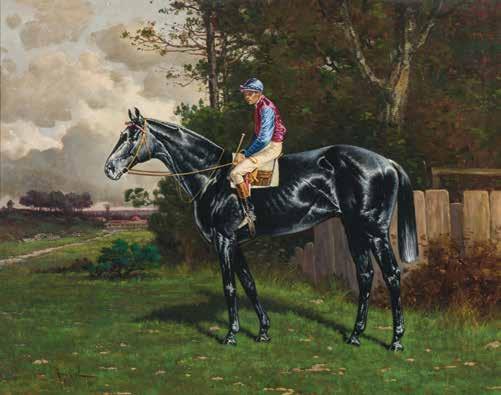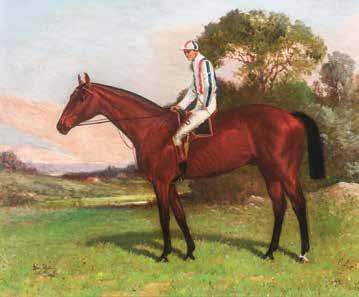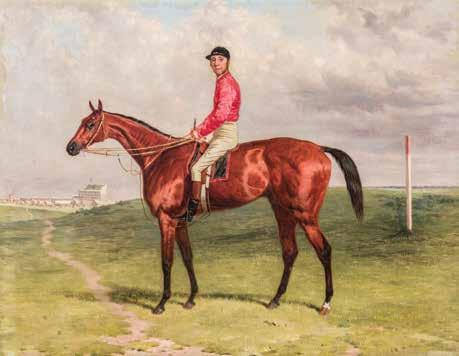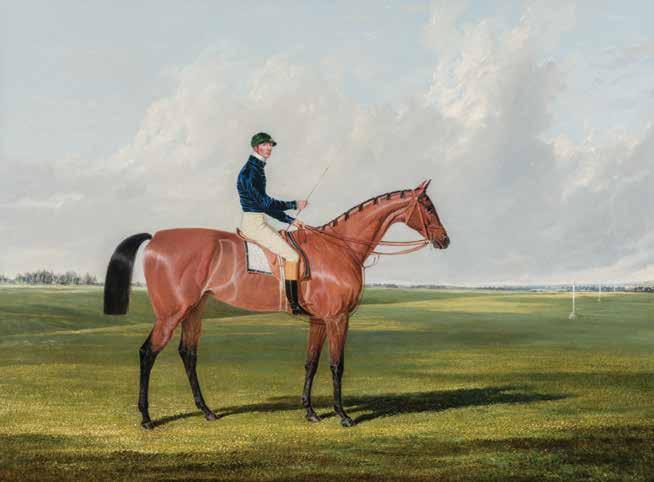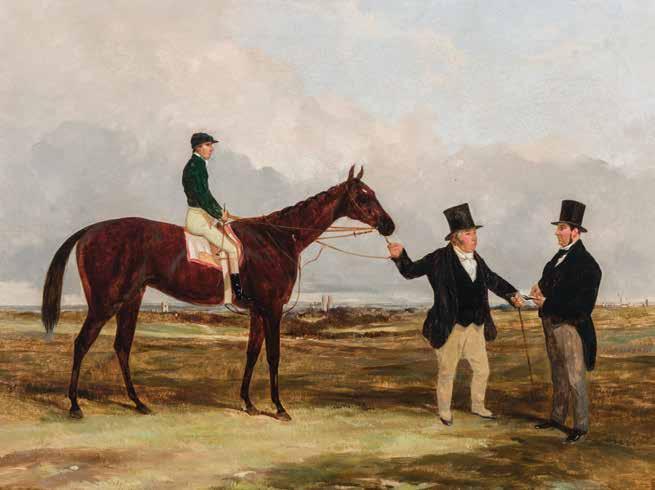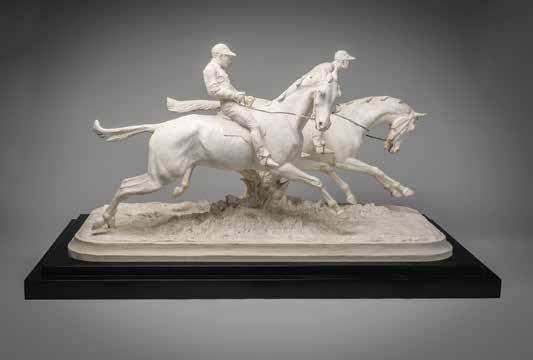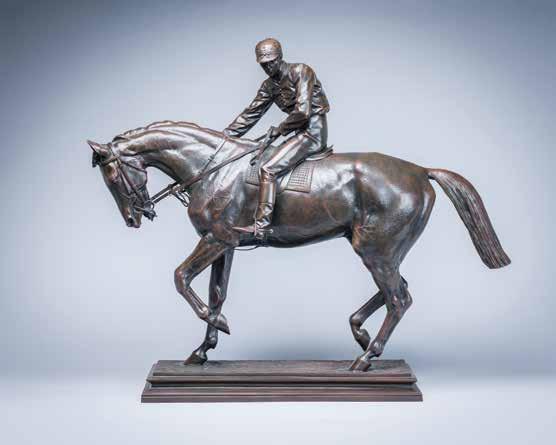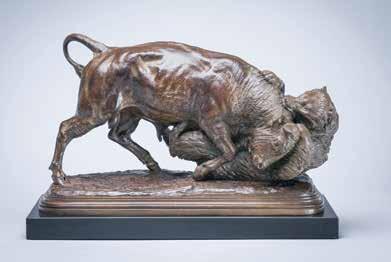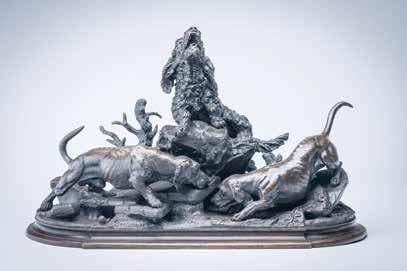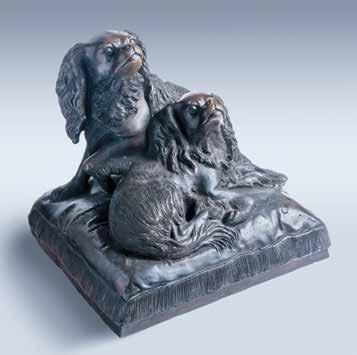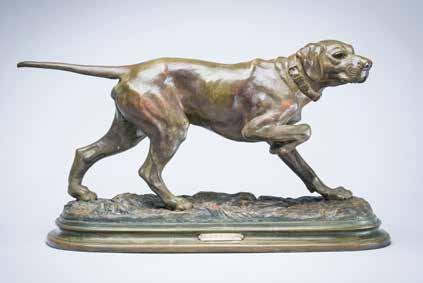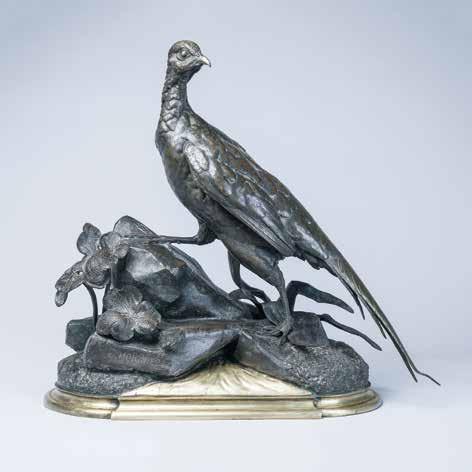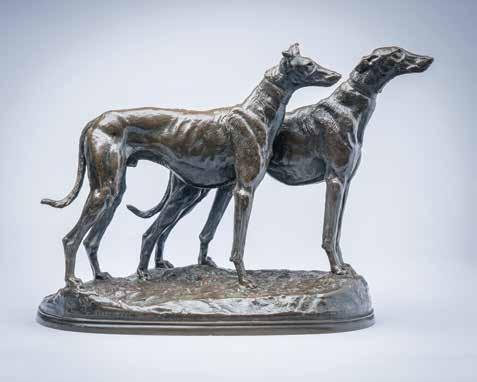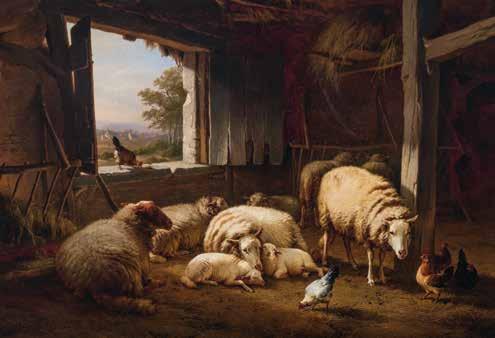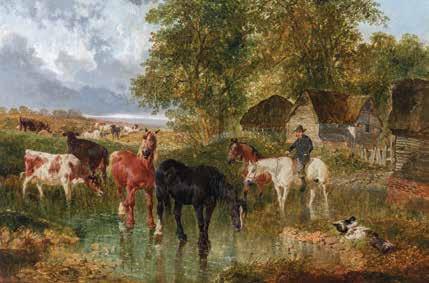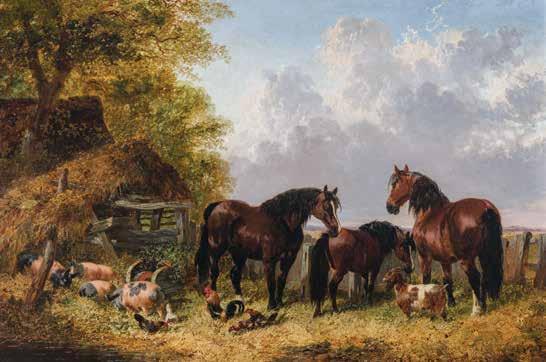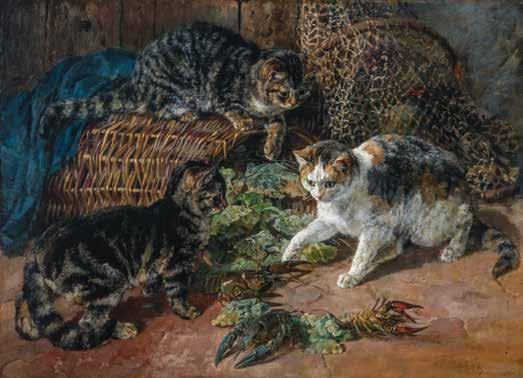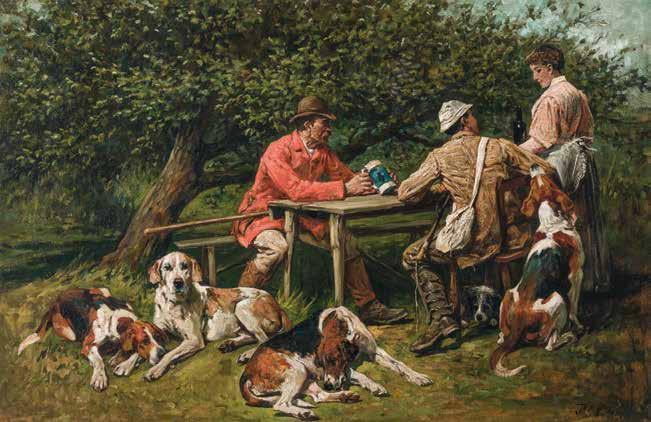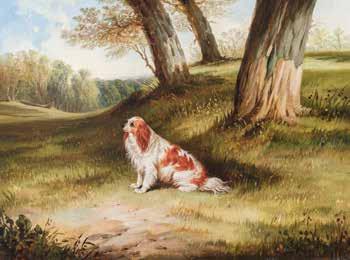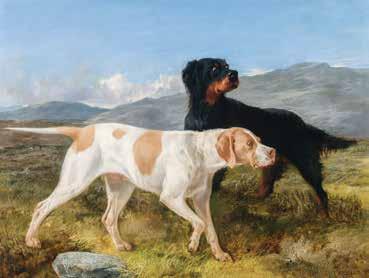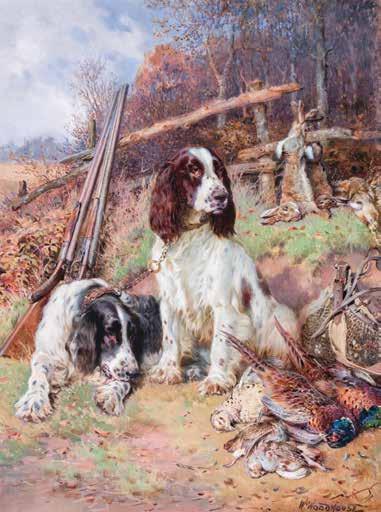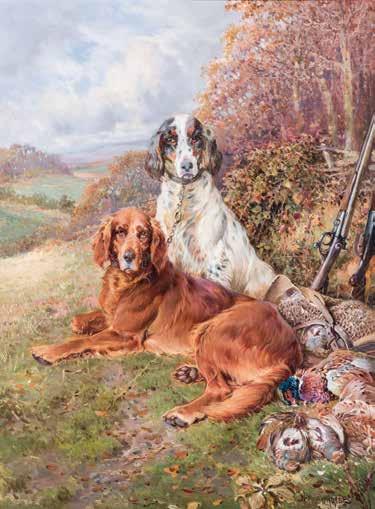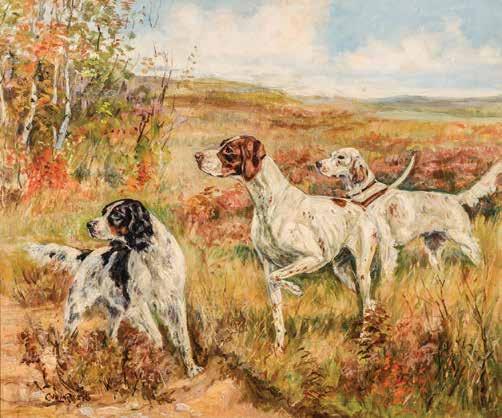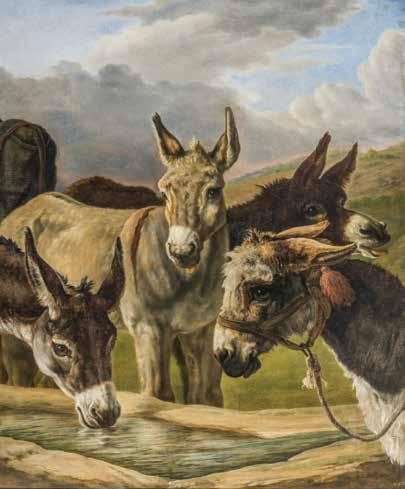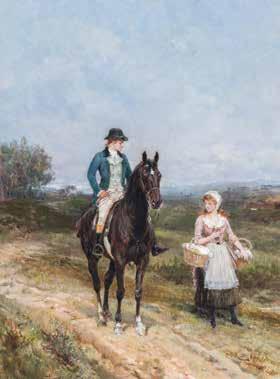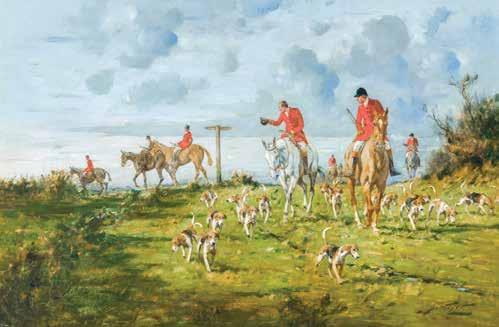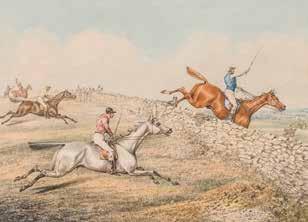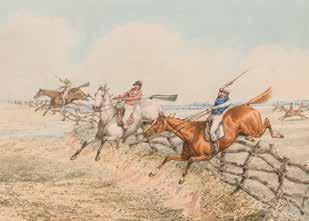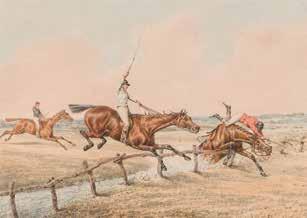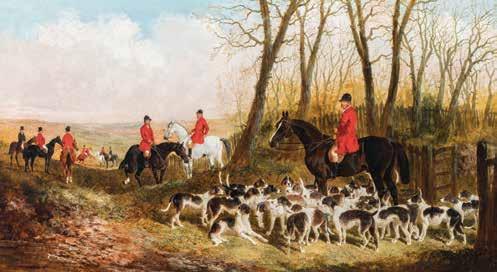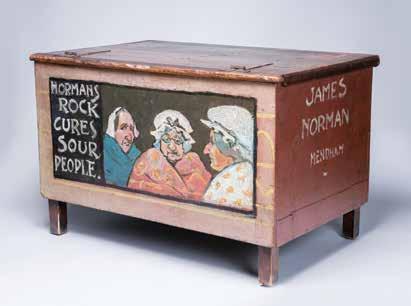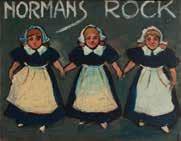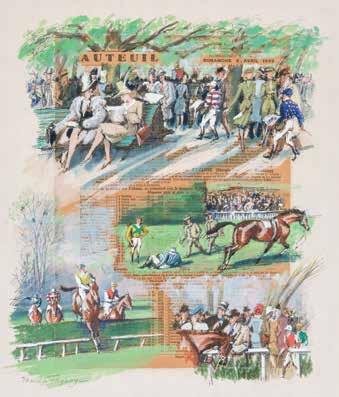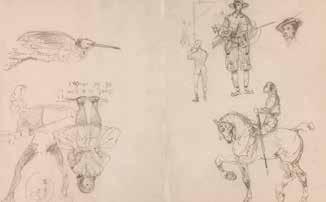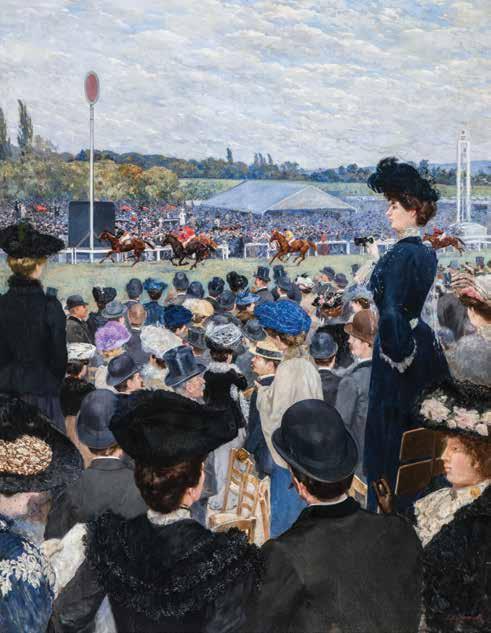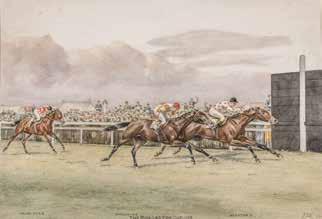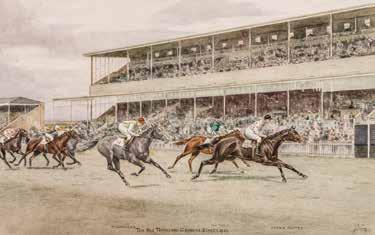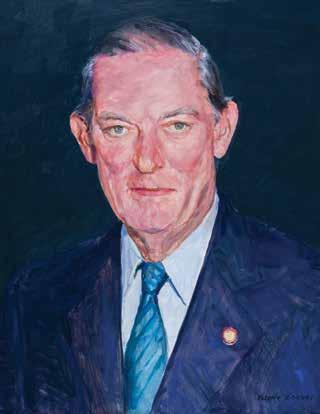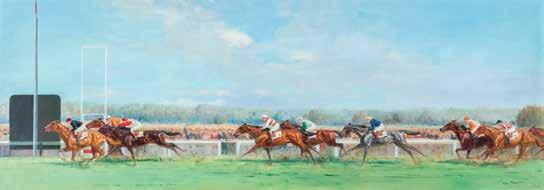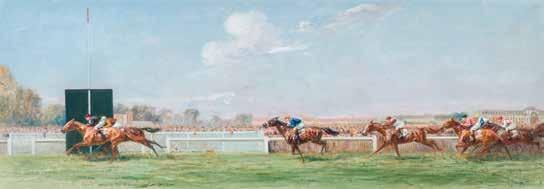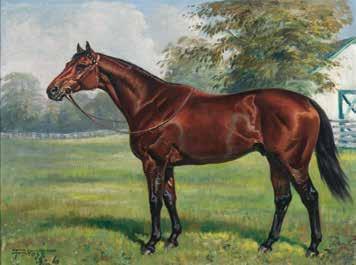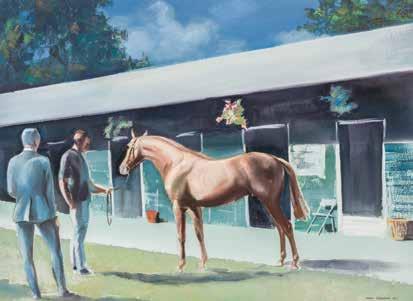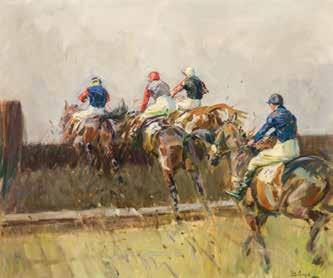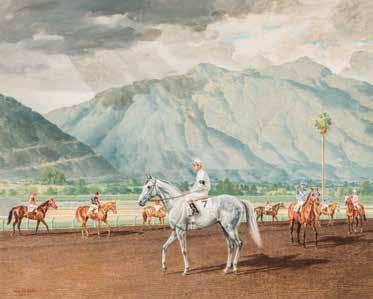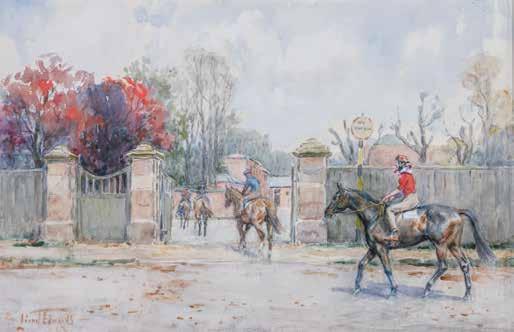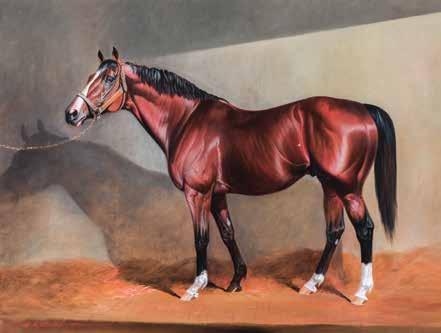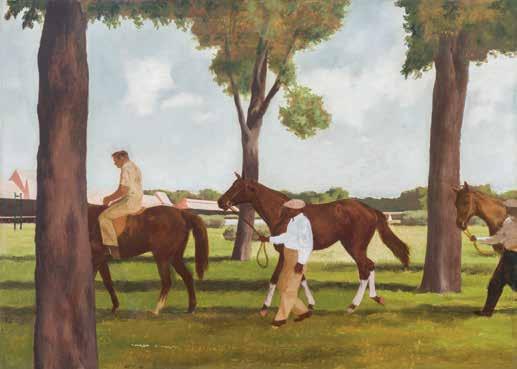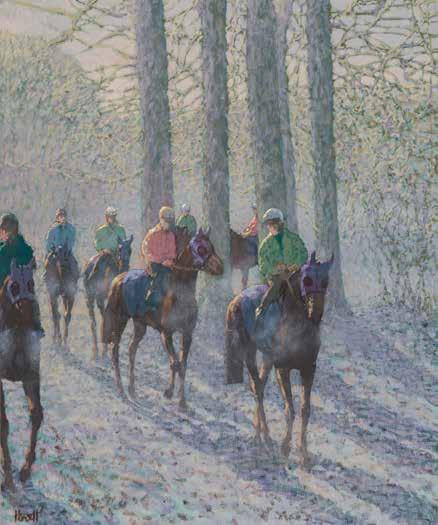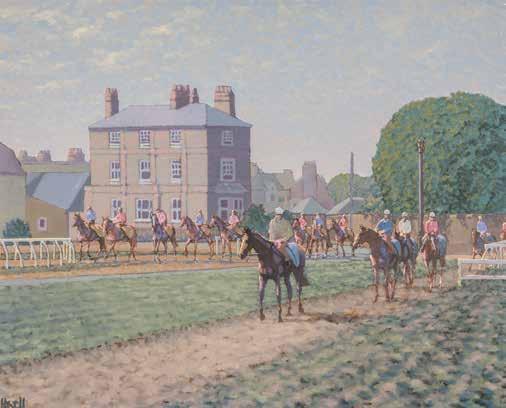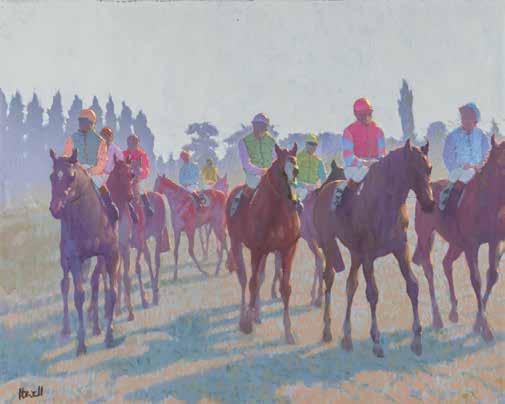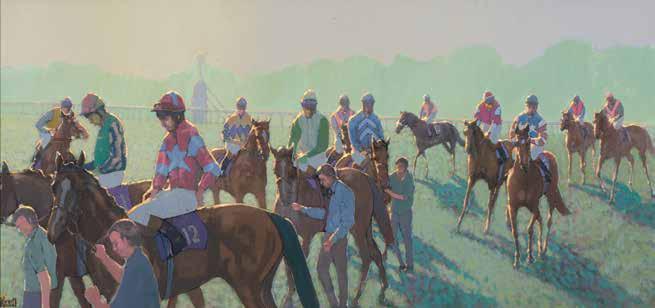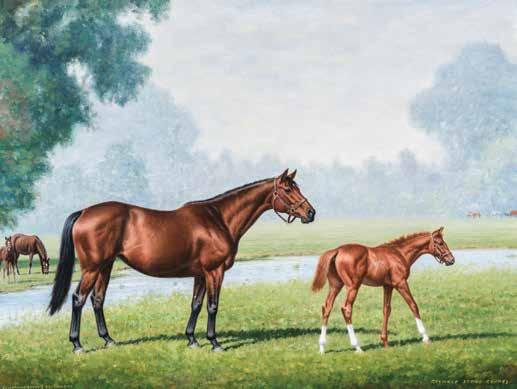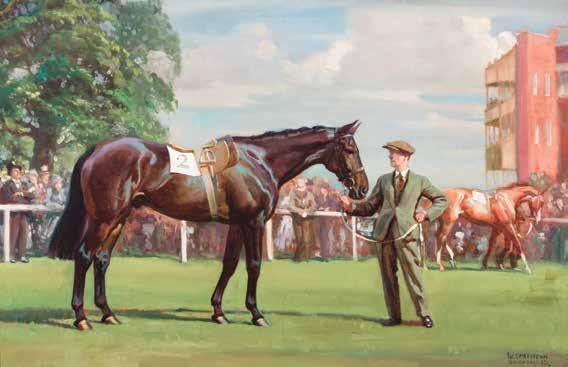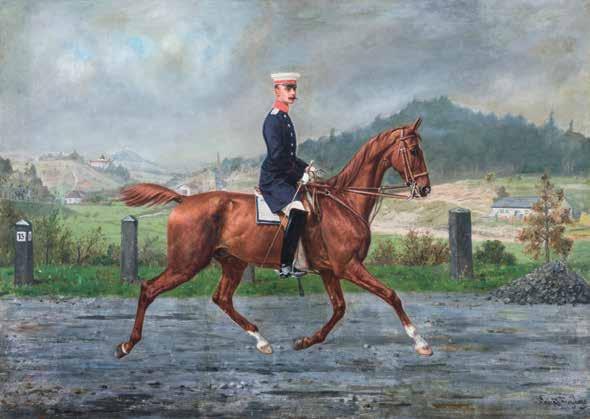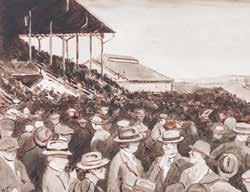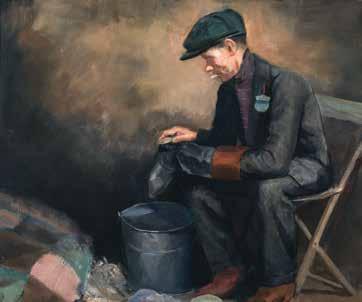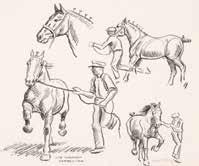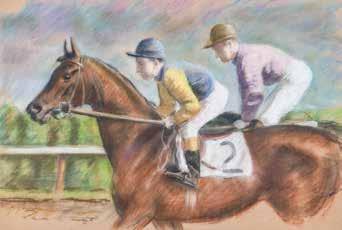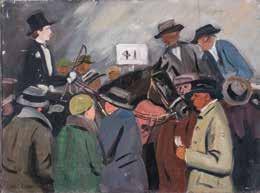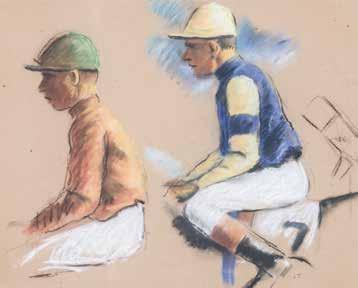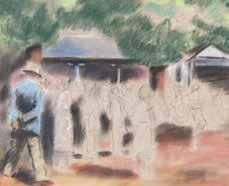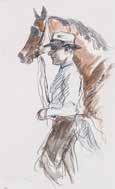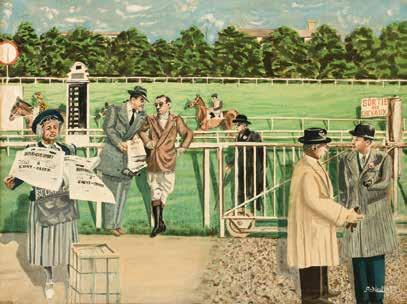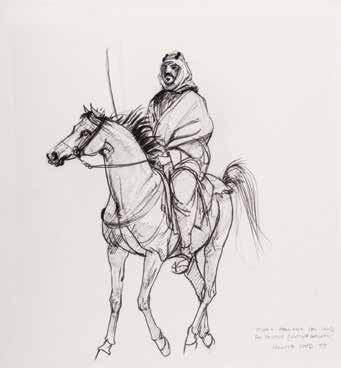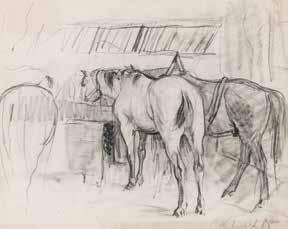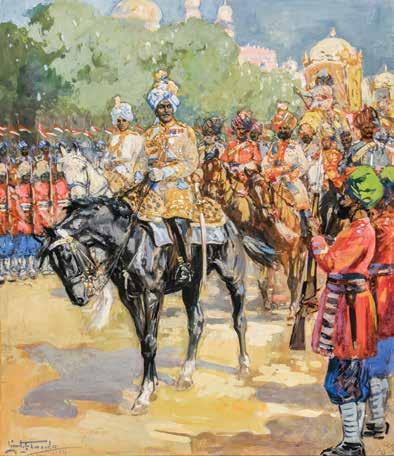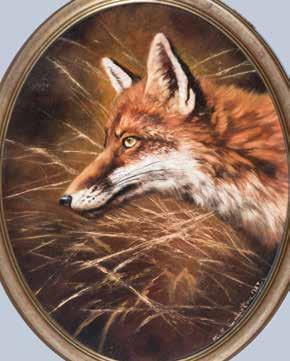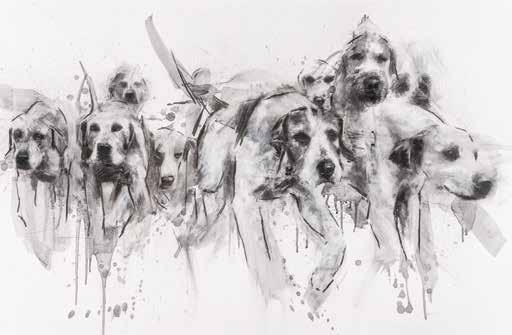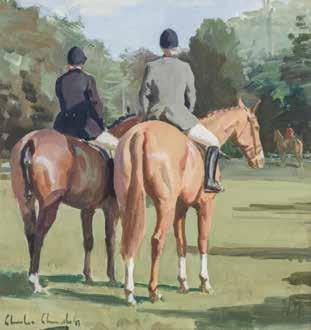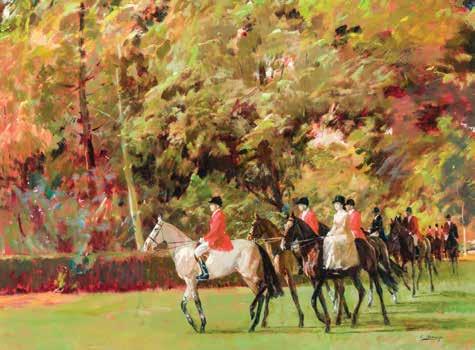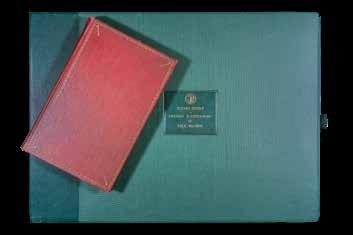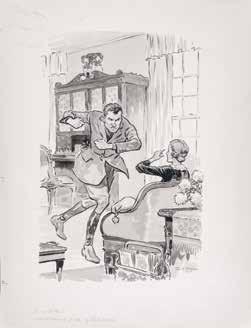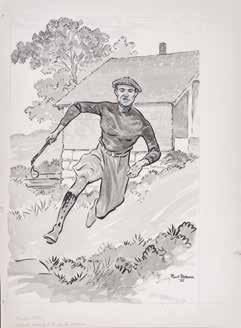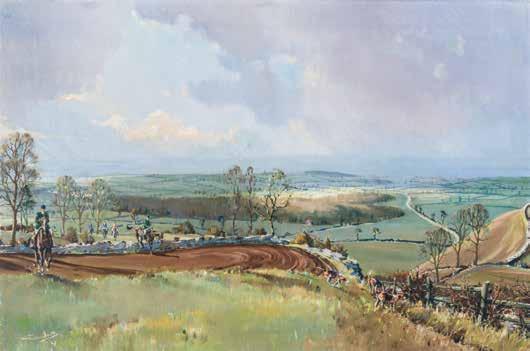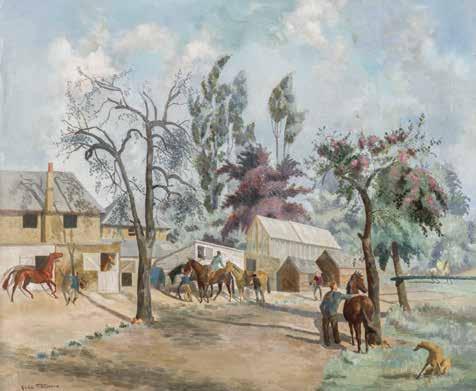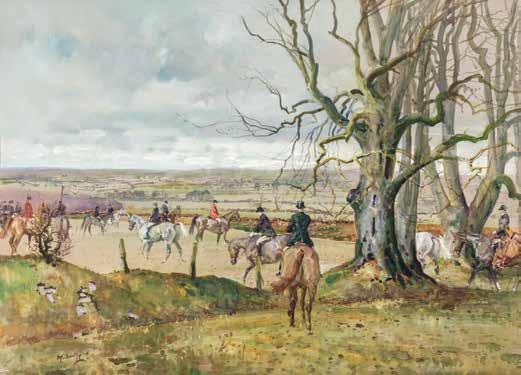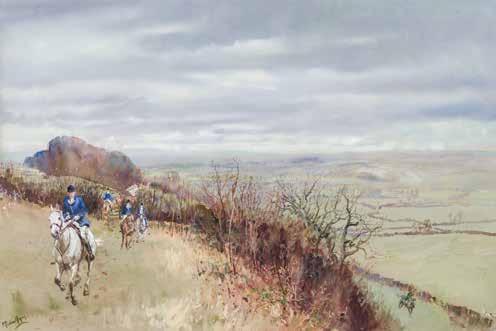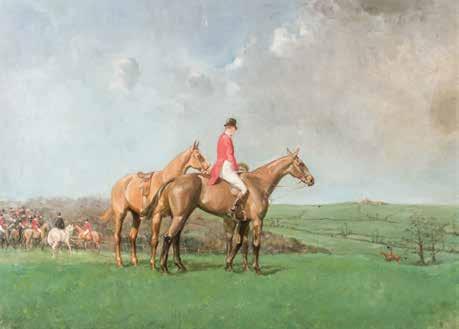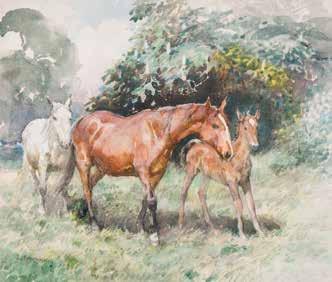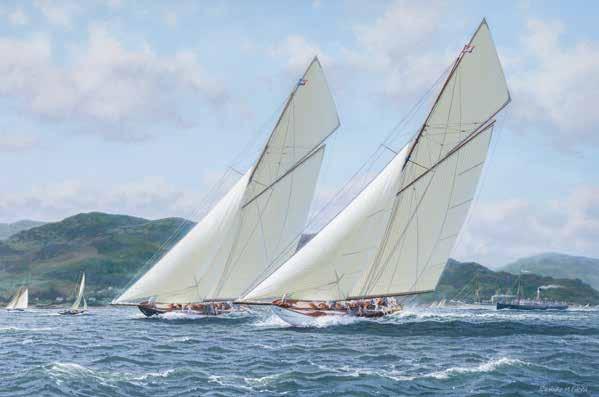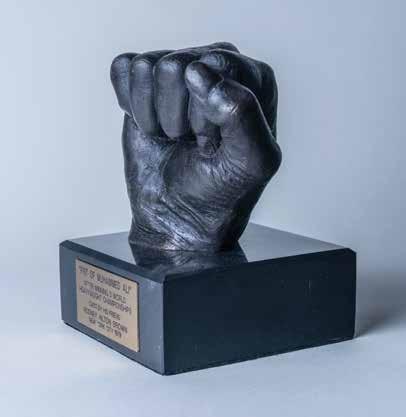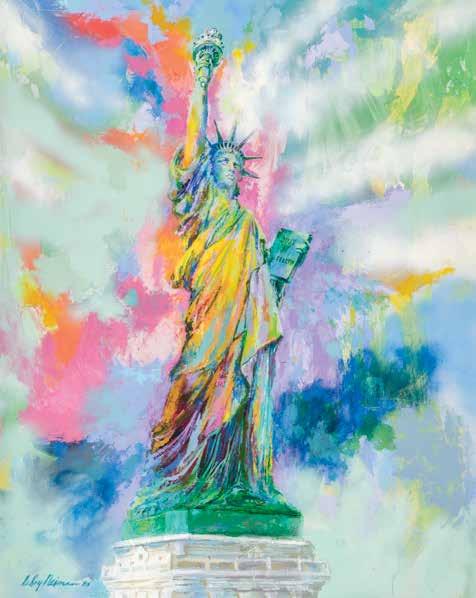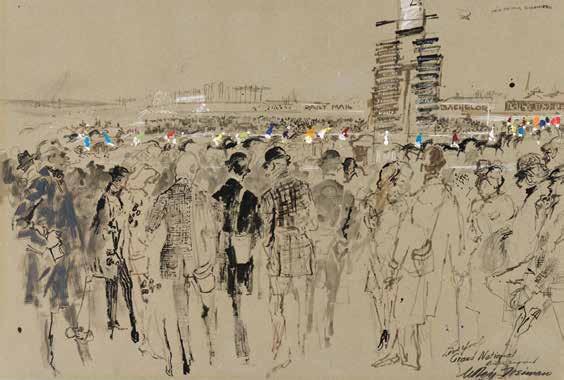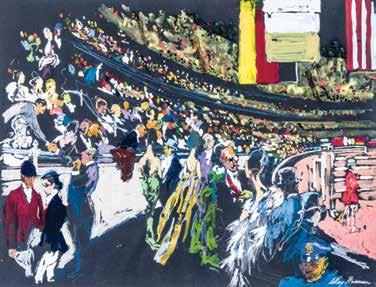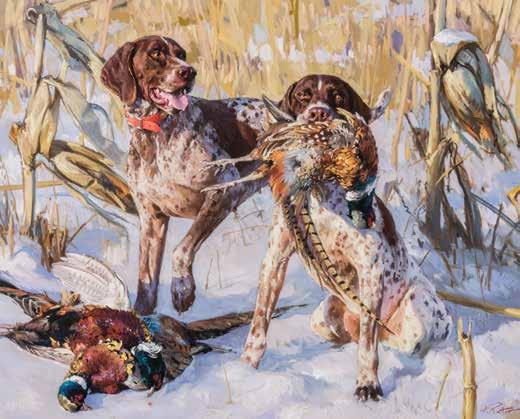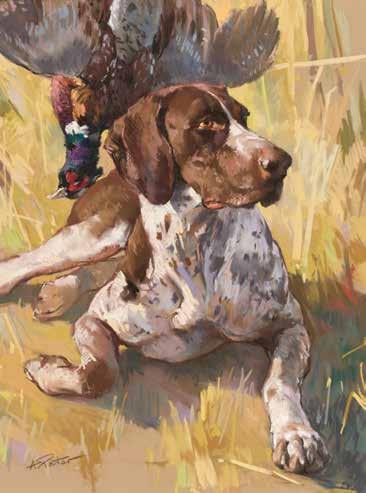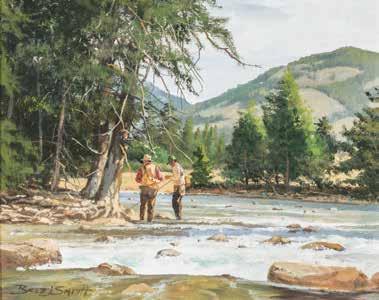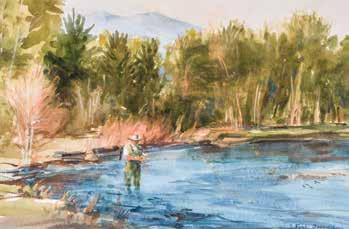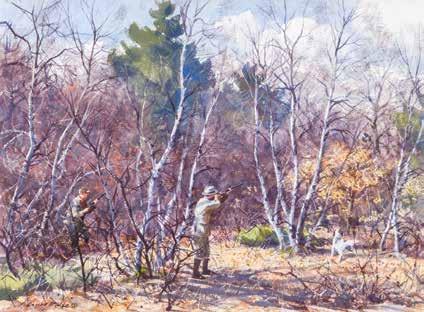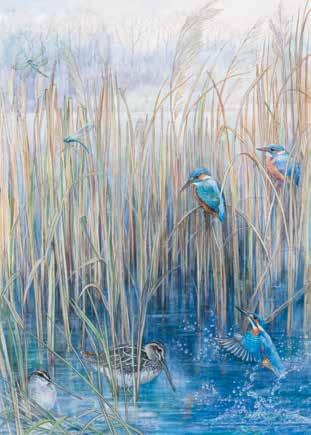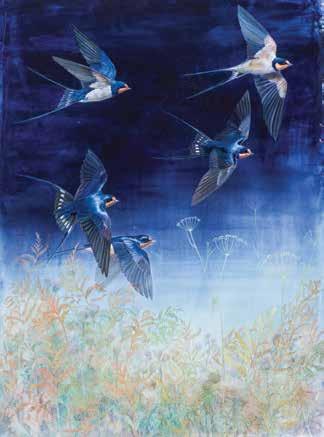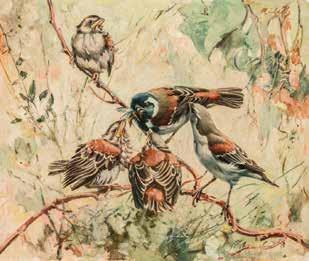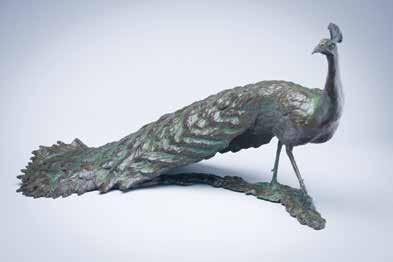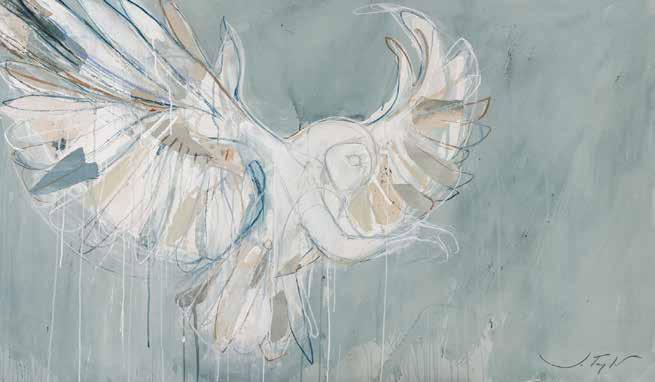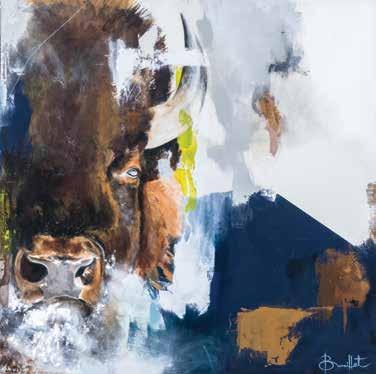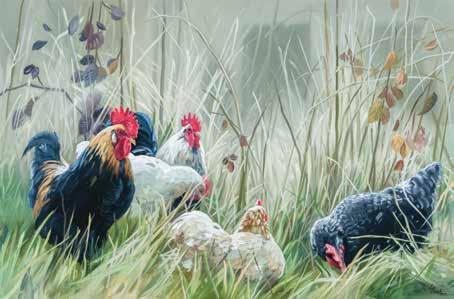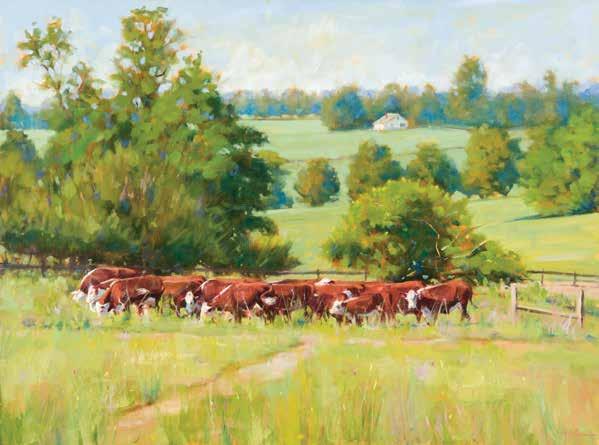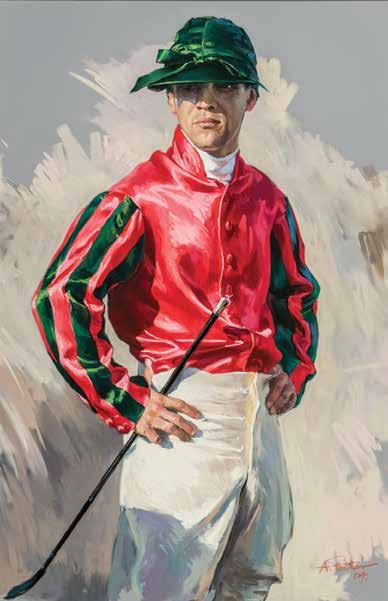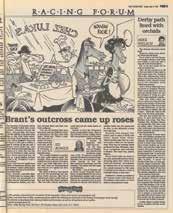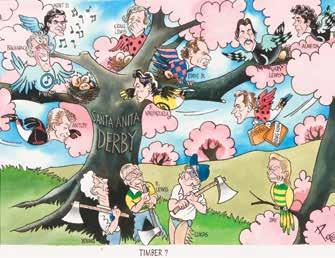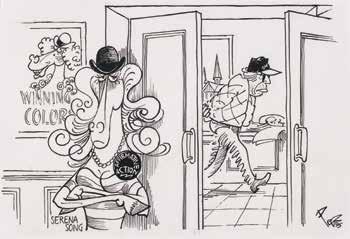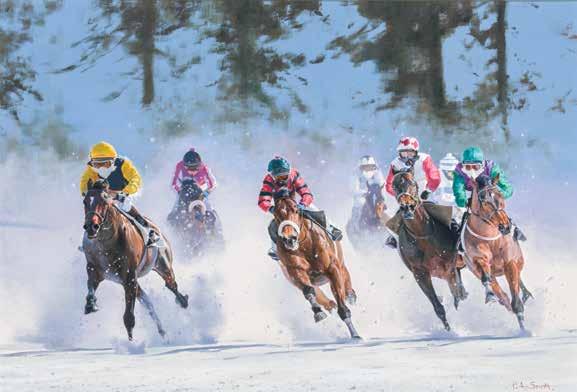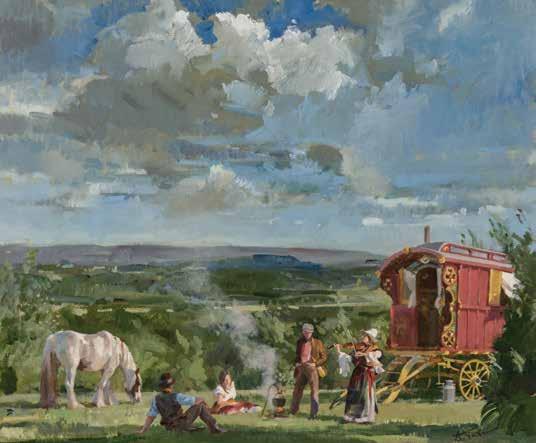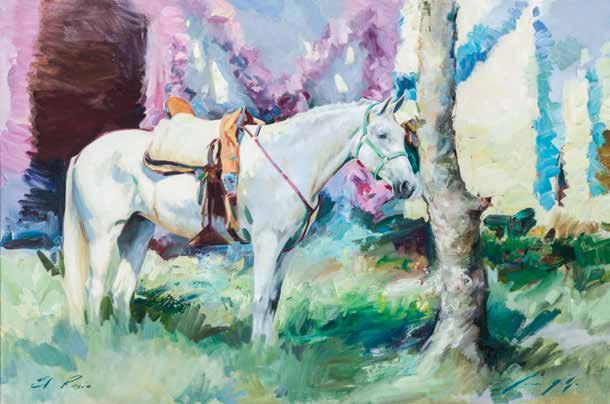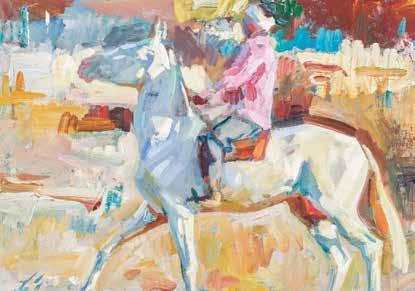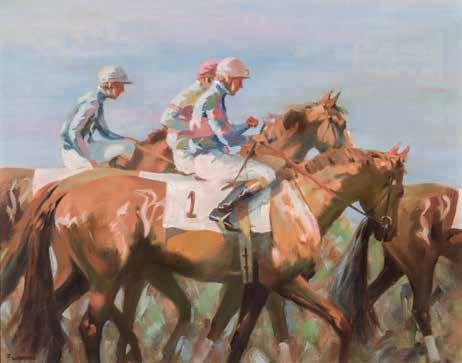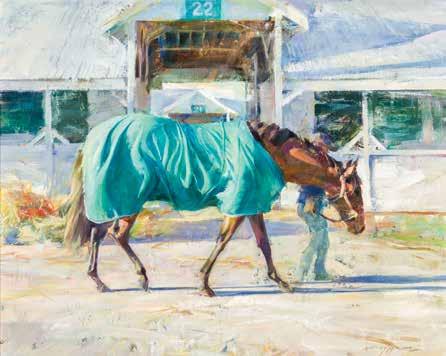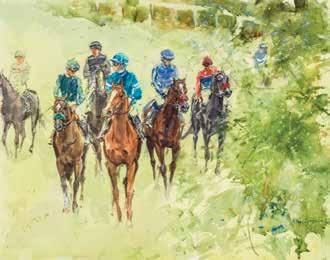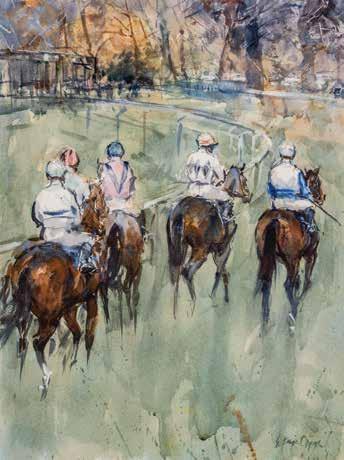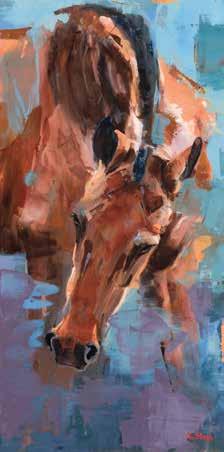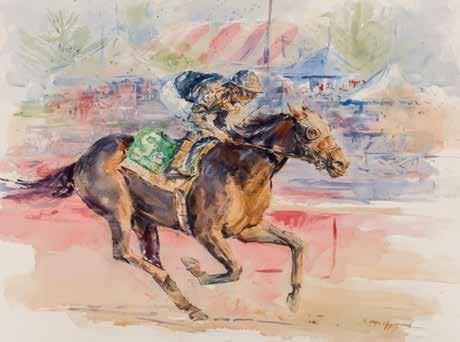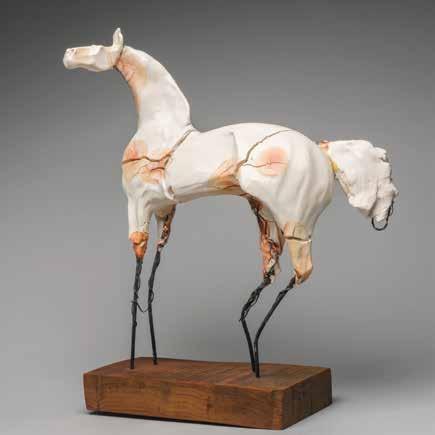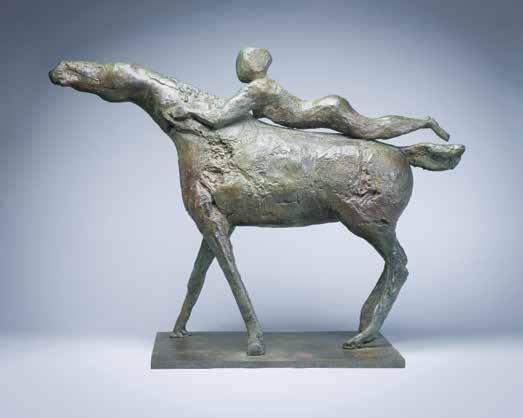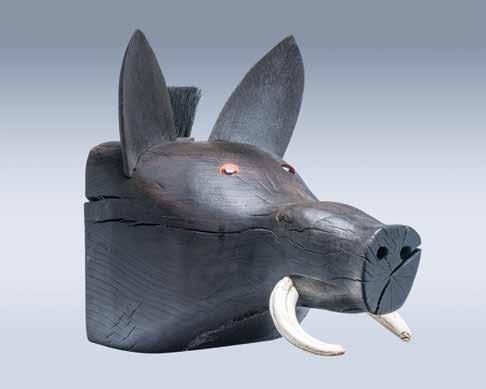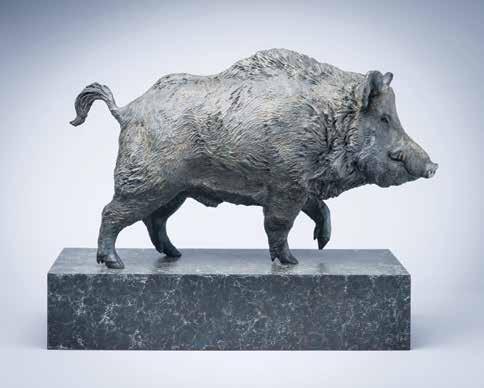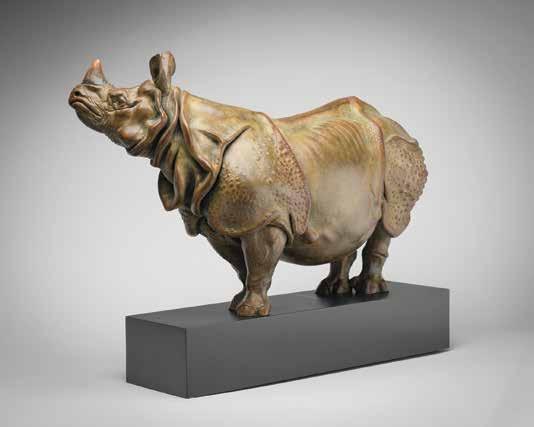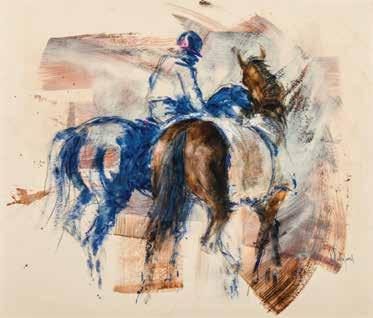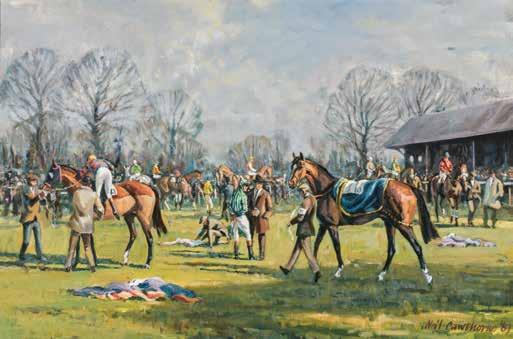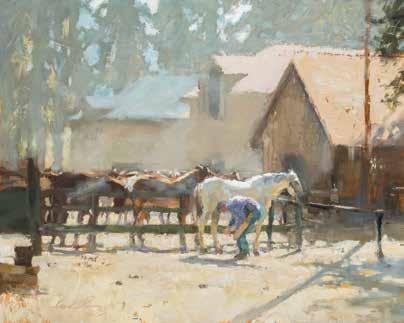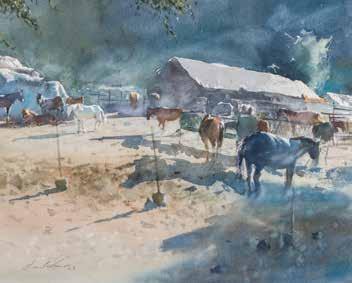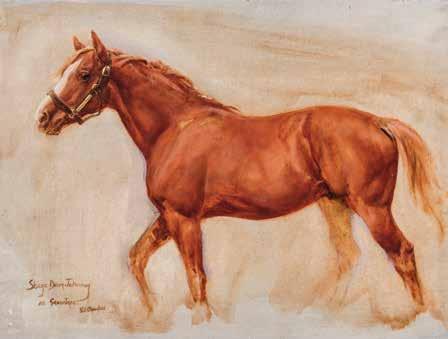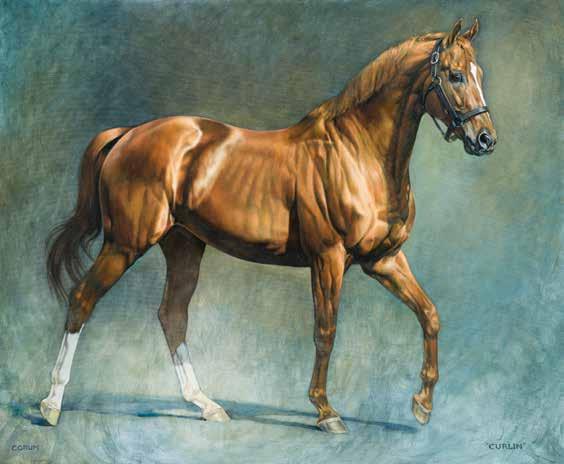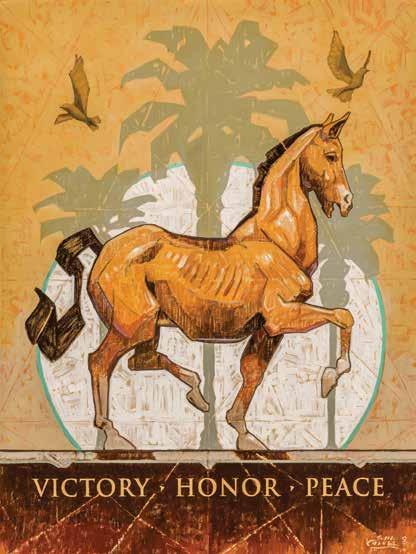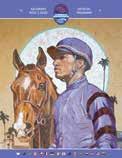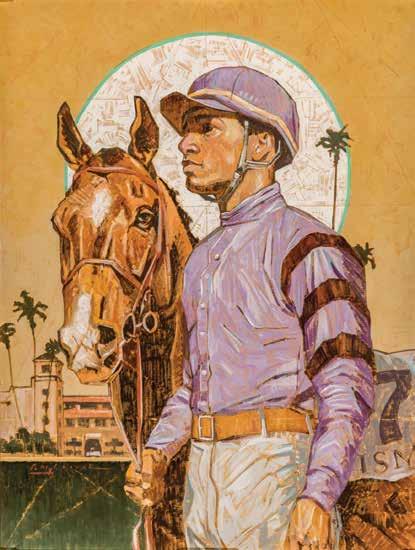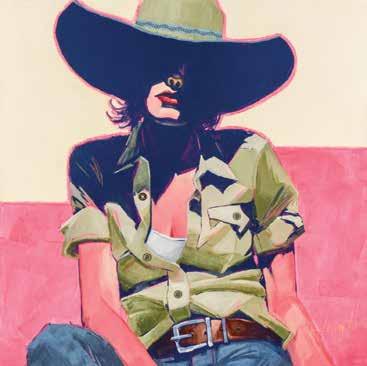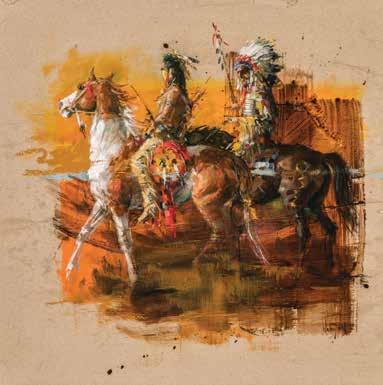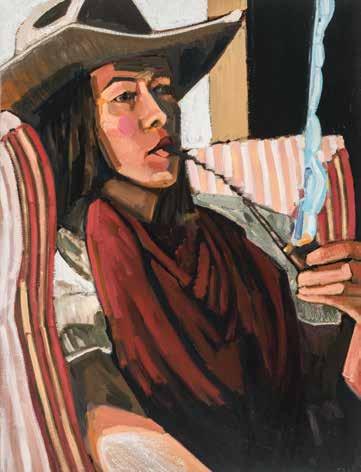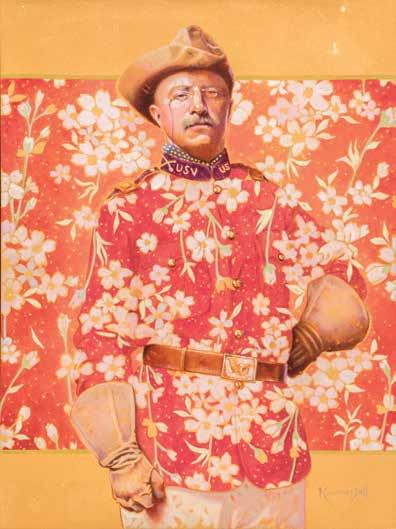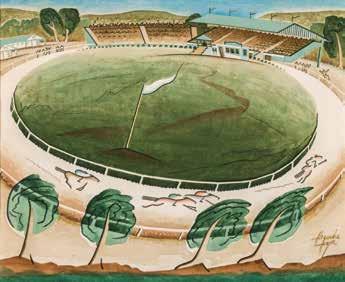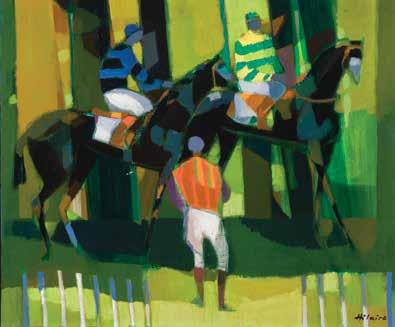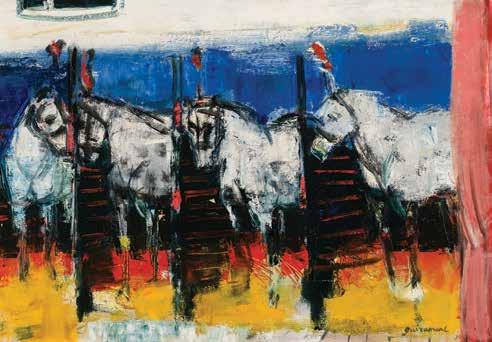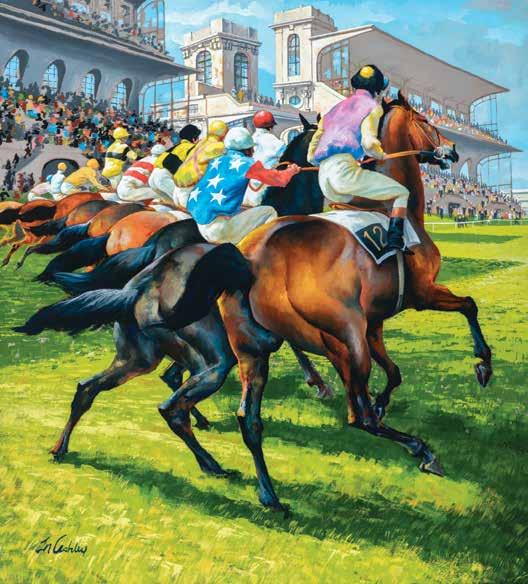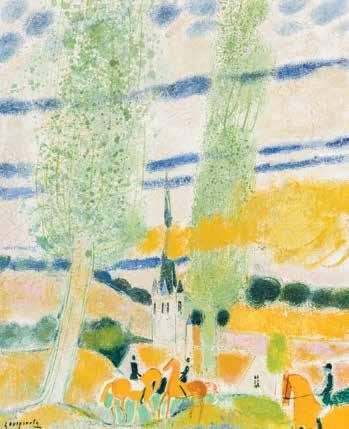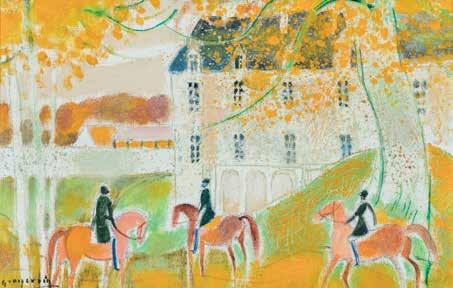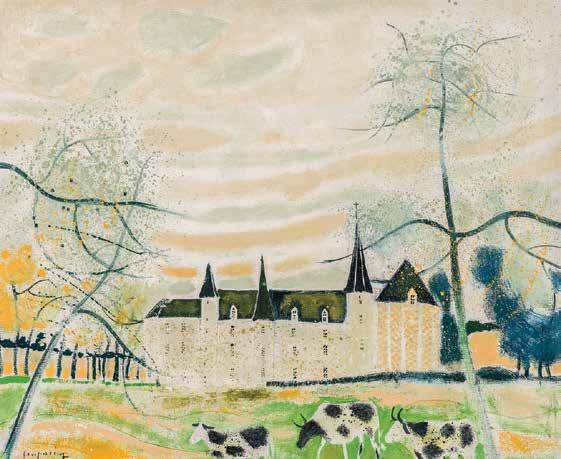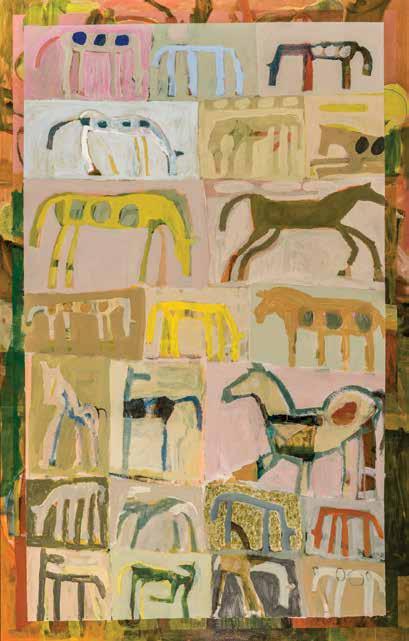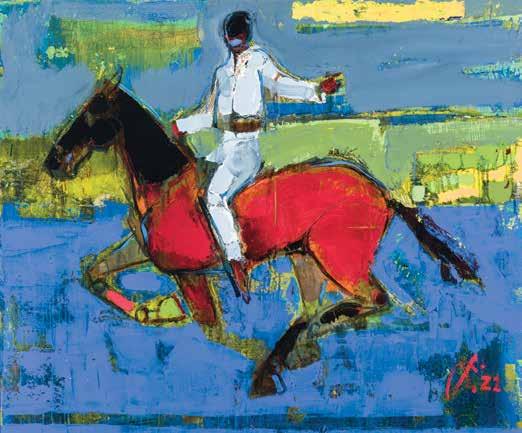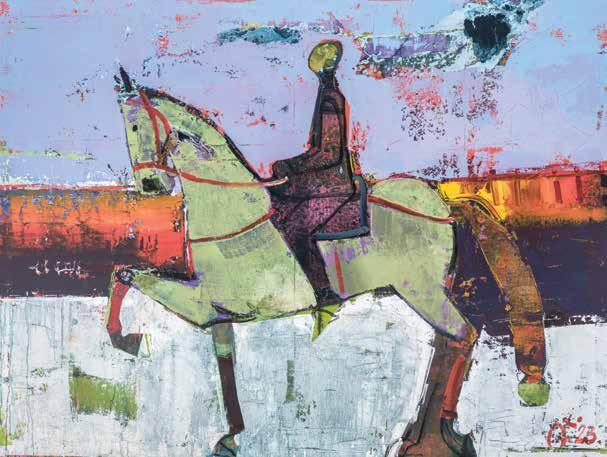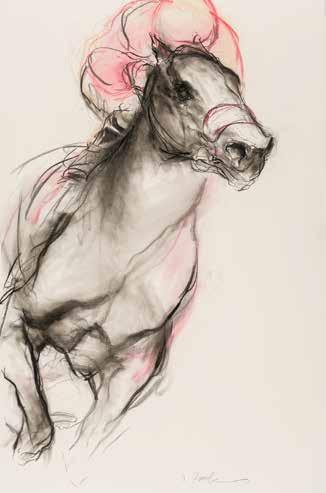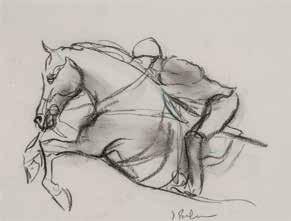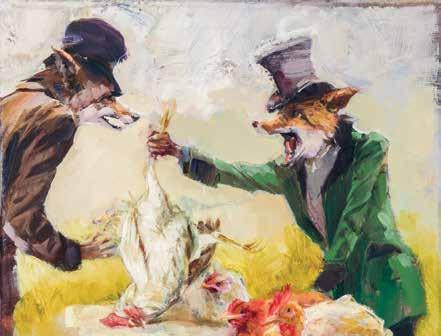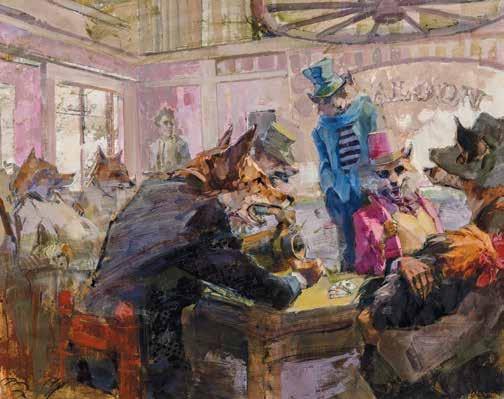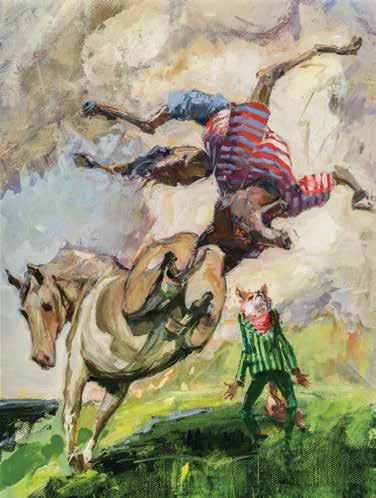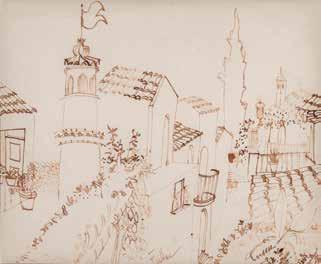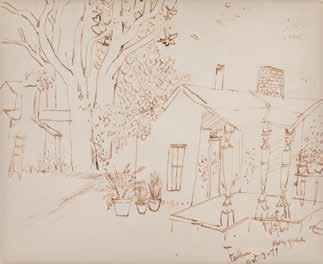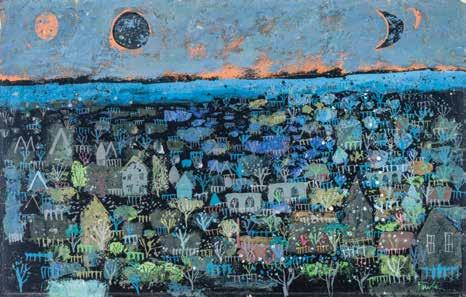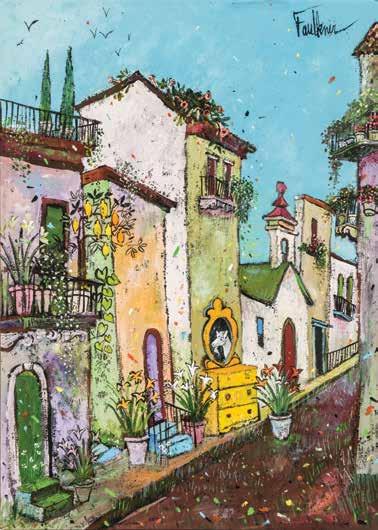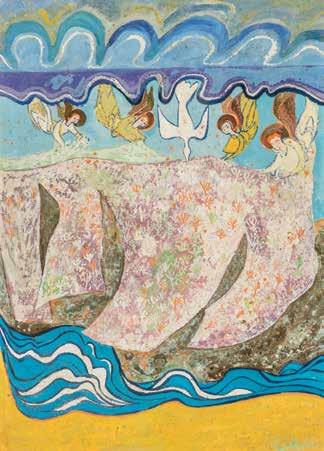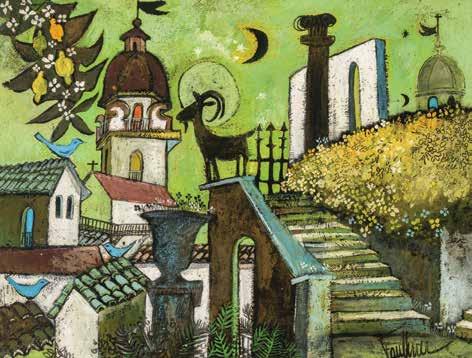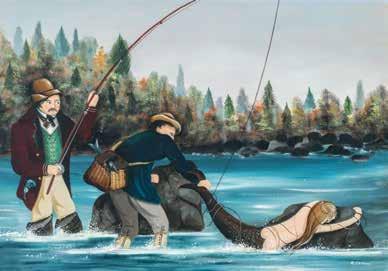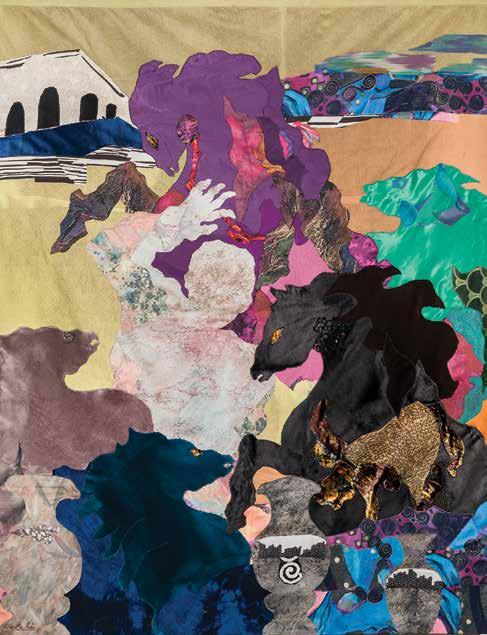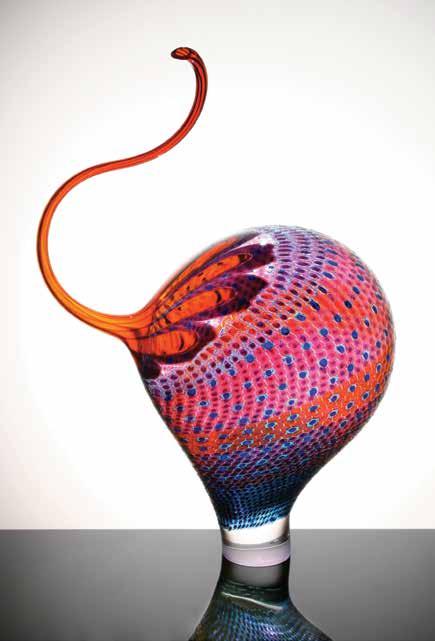ABOUT CROSS GATE GALLERY
Founded in 1974, Cross Gate Gallery is a leading source of the world’s finest sporting art. The Lexington-based gallery specializes in equinerelated art, and its impressive inventory ranges from 19th- and early 20th-century classic works to contemporary paintings and sculpture. Cross Gate’s central Kentucky location makes its focus on sporting and equestrian art a natural one.
Greg Ladd, the gallery’s founder, parlayed an early interest in fine art and his love of Thoroughbred racing into what would become one of world’s premier sporting art galleries. Early on, Ladd recognized that Lexington’s stature as the Horse Capital of the World made it an ideal locale to sell sporting art. His timing could not have been better as the 1970s and early ’80s saw tremendous growth in Kentucky’s horse industry. Buyers from around the world flocked to Kentucky to pay robust prices for Thoroughbred yearlings and many developed showplace farms with houses filled with sporting art. In this environment, Ladd found a loyal following of serious collectors from around the world. He is recognized for his expertise in the genre and gracious approach to selling art. In addition to top
Thoroughbred owners and breeders from around the world, Cross Gate’s clients include (but are certainly not limited to) Keeneland Race Course, Fasig-Tipton Company, Breeders’ Cup Ltd., and a wealth of other prominent equine organizations.
Ladd is known for his eye for quality and artistic talent. Over the years he has nurtured and represented some of the world’s top contemporary sporting artists. Cross Gate regularly exhibits their work in Lexington and at top equine venues such as Saratoga Springs, New York; Aiken, South Carolina; and Wellington, Florida. Cross Gate is also well known for featuring the works of earlier luminaries such as Edward Troye, Sir Alfred Munnings, and Henry Stull. “Our focus is on quality artwork,” says Ladd. “We are confident that we’re offering the finest sporting art available anywhere in the world today. There is a limited supply of really good artwork out there, and the best part of our job is finding that quality work and offering it to our clients.”
From the gallery’s humble beginnings, Ladd has elevated Cross Gate to a place of international prominence in the global sporting art landscape.
R| Auctioneer
yan Mahan considered following his stepfather, Dr. Robert Copelan, into veterinary medicine. Instead, he finds himself in the auction stand at the leading Thoroughbred sales company in the world.
Mahan initially had his own auction company but in 1977 he joined Keeneland as a bid spotter and later chief announcer. Promoted to auctioneer in the mid-1980s, he succeeded the late Tom Caldwell in 2001 as senior auctioneer. He has been involved with the Sporting Art Auction since its inception. |
Auctioneer
Justin Holmberg, who splits his time between Yorba Linda, California, and Era, Texas, joined Keeneland’s auction team in 1998 to add the world’s largest Thoroughbred auction house to his resume.
While growing up near Bakersfield, California, Justin became interested in a career as an auctioneer just like his father and remembers being 16 or 17 when he first sold horses, tack, and livestock. After attending the Missouri Auction School, he met noted auctioneer Tom Caldwell, who was Keeneland’s longtime Director of Auctioneers. Through Caldwell, Justin began selling Thoroughbred yearlings at Del Mar and was invited to try out for a position at Keeneland, which would become extremely important in his career. He calls Keeneland Director of Auctioneers Ryan Mahan his mentor.
Justin travels extensively from late July through December and during that time will sell American Quarter Horses (both racing- and performance-bred) at auctions in Louisiana, New Mexico, Oklahoma, and Texas; Thoroughbreds at Keeneland and in Florida; Standardbreds in Kentucky; and automobiles in California, Florida, and Las Vegas. He now adds sporting art to his portfolio.
Justin met his wife, Sophie, at a Keeneland sale in 2008, and they married two years later. Their son, Harrison, was born in 2014.
L| Owner, Cross Gate Gallery
exington, Kentucky, native Greg Ladd founded Cross Gate Gallery in 1974 and has developed it into one of the world’s premier sources of sporting art.
While studying at the University of Kentucky, Ladd laid the foundation for what was to become Cross Gate, and he is now regarded as an expert in the genre of sporting art.
Ladd has been on the advisory board of the Art Museum at the University of Kentucky, the Living Arts & Science Center, and the Kentucky Horse Park Museum. He has served as an Elder at the Second Presbyterian Church. He and his wife, Laura, have four children, two of whom — Catherine and Field — participate in the operation of Cross Gate Gallery.
Meet Cross Gate Gallery Staff
Grayson Bickett
Field Ladd
Catherine Ladd Kenneally
Linda Helton
Jacqueline LeMastus
Bill Evans Meng
Rogelio Bautista
Drew Preston
The following are examples of the terminology used in this catalogue. Please note that all statements in this catalogue as to authorship, period, culture, source, or origin are qualified statements and are made subject to the provision of the Conditions of Sale printed in this catalogue. (The artist’s name, “Peter Biegel” is used here as an example, and the following expressions will apply to the artist’s name and the Lot number with which it is associated.)
“Peter Biegel”
In our opinion, a work by the artist. While this is the highest category of authenticity, no unqualified statement as to authorship is made or intended.
“Attributed to Peter Biegel” In our opinion, probably a work by the artist, but less certainty as to authorship is expressed than in the preceding category.
“After Peter Biegel” In our opinion, a copy of a known work of the artist.
The term signed and/or dated and/or inscribed means that, in our opinion, a signature and/or date and/or inscription are from the hand of the artist.
The abbreviations fl. and op. mean that the artist worked, “flourished,” and/or “operated” during this time span.
The abbreviation A/C means Artist’s Copy.
Unless otherwise stated in the description, all pictures are framed and all measurements are given with the height preceding the width. All sizes for sculpture are given with the height preceding the width.
■ ESTIMATES
The estimated selling price of each Lot is printed beneath the Lot description and does not include the Buyer’s Premium. This sale will be conducted in U.S. dollars. Bidders should bear in mind that estimates are prepared well in advance of the sale, are not definitive, and are subject to revision.
■ IMPORTANT NOTICE
No reference to any imperfection is made in individual catalogue descriptions of property offered for sale. Notwithstanding any condition report or catalogue descriptions provided, all Lots are offered and sold “AS IS” in accordance with the Conditions of Sale.
Please refer to the Conditions of Sale at the back of the catalogue for full official details.
■ CATALOGUE DESCRIPTIONS
Statements made by us in the catalogue or any condition report, or made orally or in writing elsewhere, regarding the authorship, origin, date, age, size, medium, attribution, provenance, condition or estimated selling price of any Lot are merely statements of opinion, and are not to be relied on as statements of definitive fact. Catalogue illustrations are for guidance only, and should not be relied on either to determine the tone or color of any item or to reveal imperfections. Many items are of an age or nature that precludes their being in perfect condition. Estimates of the selling price should not be relied on as a statement that this price is either the price at which the Lot will sell or its value for any other purpose.
■ EXAMINATION OF GOODS
Prospective Buyers are urged to examine personally any Lots in which they are interested BEFORE BIDDING, as they accept any property purchased AS IS, with all faults.
■ REGISTRATION BEFORE BIDDING
Prior to sale, all bidders must register and receive a bidding number. PLEASE NOTE: AT THE TIME OF REGISTRATION, DEALERS MUST COMPLETE A RE-SALE TAX EXEMPTION CERTIFICATE; OUT-OFSTATE DEALERS MUST PRESENT AN EXEMPTION FORM FROM THEIR STATE. A bidding number is required of the successful bidder at the fall of the auctioneer’s hammer for each Lot. For your convenience bidder registration can be completed at any pre-sale inspection and prior to sale.
■
CONDUCT OF SALE
All Lots will be sold subject to the Reserve, which will not exceed the low presale estimate printed in this catalogue, or as may be amended by the Announcements. Successful purchasers are responsible for all applicable sales taxes.
■ WRITTEN / ABSENTEE BIDS
If you cannot attend the auction in person, KCG Enterprises, LLC (“KCG”) can bid for you according to your instructions. There is no extra charge for this service, which is known as commission bidding. If successful, the price you pay will be the final bid price plus the Buyer’s Premium, as set forth in the Conditions of Sale. Bids must always be made or confirmed in writing, using the form printed in this catalogue. Bank references may be requested and should be supplied with enough lead time to confirm before the auction. For further information, please call (859) 233-3856 before November 12, 2025, or email info@thesportingartauction.com.
■ TELEPHONE BIDS
Bidders who cannot attend the auction and who wish to bid by telephone should make arrangements for this service at least two (2) days in advance of the sale as the number of telephone lines is limited. For further information, please call (859) 233-3856 before November 12, 2025, or email info@thesportingartauction.com
■ AUCTIONEER’S DISCRETION
The auctioneer has absolute and sole discretion with respect to bidding, to refuse any bid, to advance the bidding in such a manner as he may decide, to withdraw or divide any Lot, to combine any two or more Lots, and, in the case of error or dispute, whether during or after the sale, to determine the successful bidder, to continue or re-open the bidding, to cancel the sale or to re-offer and re-sell the item in dispute. If any dispute arises after the sale, KCG’s sale record is conclusive.
■ SHIPPING / REMOVAL OF PROPERTY
If you are an absentee bidder, we can arrange for the shipment of your purchases as per your written instructions. Estimates for the shipping of any property can be obtained from our staff at KCG. If you are attending the sale and desire us to arrange shipping, this must be done immediately after the sale.ALL PURCHASES MUST BE REMOVED FROM THE BUILDING NO LATER THAN WEDNESDAY, NOVEMBER 19, 2025 at 2:00 p.m. unless prior arrangements have been made with KCG to store property at a warehouse. TO COLLECT ITEMS IN PERSON YOU MUST PRESENT A PAID RECEIPT TO KCG STAFF.
■ INSURANCE
Purchasers are requested to arrange clearance for Property as early as possible and in any event, no later than fourteen (14) days following the day of the sale, at which time KCG’s liability for loss or damage to sold property shall cease. Purchasers must arrange to insure the purchased property as of the time of sale, as they deem appropriate, and regarding which KCG shall have no obligation or liability whatsoever. Transit Insurance can be arranged by the shipper to cover your property from collection at the sales premises to arrival at your destination, if requested. You must notify us if you wish to arrange for this service or if you will be supplying it yourself.
■ STORAGE AND STORAGE CHARGES
For a period after the auction, uncollected purchases and unsold Lots may be held at Keeneland. Thereafter they will be removed for storage and charges will be incurred. All uncollected and unsold property not collected from Keeneland by 12:00 noon on Thursday, November 13, 2025, will be removed by KCG and stored at Cross Gate Gallery. The Seller and/or Buyer will not be entitled to collect the stored property until all outstanding charges are paid in full. Seller and Buyer grant KCG a security interest in all goods in our possession for payment of storage and other related charges due. PLEASE NOTE: KCG SHALL HAVE NO LIABILITY OR RESPONSIBILITY WHATSOEVER FOR DAMAGE OR LOSS DUE TO NEGLIGENCE OR OTHERWISE AS A RESULT OF THIS REMOVAL AND STORAGE.
■ PHOTOGRAPHS AND ILLUSTRATIONS / PRIVACY NOTICE
KCG may record any or all portions of the Sale by video, audio or other means, which may be used by KCG in its sole discretion. All participants consent to the use, reproduction and distribution of such recordings, biographical and other information or descriptions, and images that may be provided, for inclusion in the catalogue or other marketing of the Sale or for any other advertising or promotional purpose as deemed appropriate by KCG.
To the extent any provision in the foregoing (Glossary for Paintings and Sculpture or Tips for Buying and Selling at the Auction) conflicts with the Conditions of Sale, the Conditions of Sale shall govern.
Fine Sporting Art, American Paintings, and Sculpture
Thursday • November 13, 2025 • 4:00 p.m. EST
Keeneland Sales Pavilion Lexington, Kentucky
1 | Sir Alfred James Munnings (British, 1878–1959)
MR. SPONGE, THE RASPERS TAKING!
Pencil, 8 ½” x 10”
Signed, inscribed $6,000. – 9,000.
Provenance: The Sporting Gallery
Inscribed: “Mr. Sponge the raspers taking, sets the junkers’ nerves a quaking!”
Incident from “Mr. Sponge’s Sporting Tour” by Surtees:
“Sponge, with increased confidence, rose in his stirrups, easing the redoubtable Hercules; and patting him on the shoulder, at the same time that he gave him the gentlest possible touch of the spur, exclaimed, ‘By the powers, we’ll show these old Flat Hats the trick!’ He then commenced humming:
Mister Sponge, the raspers taking, Sets the junkers’ nerves a shaking;
and riding cheerfully on, he at length found himself on the confines of a wild rough-looking moor, with an undulating range of hills in the distance.”
—R. S. Surtees
In his autobiography An Artist’s Life, The Finish (page 314), Munnings speaks about his fondness for Surtees character Mr. Sponge:
“I greet Surtees to-day in all my rooms. Editions of ‘Sponge’ are in my Chelsea home and here. I can call him up at any moment without picking up his Sporting Tour. He is here now...in his tall hat, with his all-around beard and shaved mouth and chin; a horsey, unscrupulous fellow who took life as it came...wearing a strong, short-tailed, doubleseamed scarlet coat, white ribbed cords and dark mahogany tops to his boots. Lord Scamperdale’s pet aversion... ‘That brown-booted abomination!!...That rattlesnake!’ ”
2 | Attr. to Willem Theodorus Eilerts
(Dutch/American, 1847–c. 1908)
DARKHORSE IN A LANDSCAPE
Oil on canvas, 22” x 27”
Signed E. Troye
$1,000. – 2,000.
Provenance: The estate of Alex Campbell
We believe this painting to be what was once an unsigned work by Eilerts that had the signature of Edward Troye added at a later date. Whether a long ago owner of the work confused the two artists or was acting unscrupulously we cannot say. Both artists worked in central Kentucky in the 19th century, Troye during the years before and after the Civil War, while Eilerts operated in the last quarter of the century. The two artists both painted the prized stock of local owners, and both were known to have lived with David Lehman and his family in Midway, Kentucky, where the family store is still in operation today. The incorporation of
a dead tree of some kind is usually found in their works, though this one features the more stump-like version often used by Eilerts. On October 15, 1936, the Lexington Herald ran a 56-page edition covering the opening of Keeneland, and it was an Eilerts painting of Ten Broeck that graced page 49.
3 | John Ferneley Sr. (British, 1782–1860)
CHESTNUT IN A LANDSCAPE
Oil on canvas, 25” x 30”
$6,000. – 9,000.
Provenance: Sotheby’s, New York, May 27, 2004, Lot 253.
4 | James Ward (British, 1769–1859)
A BAY STALLION IN AN EXTENSIVE LANDSCAPE Oil on canvas, 34” x 44”
Signed $20,000. – 30,000.
Provenance: Richard Green Gallery, London
5 | William Henderson (British, 1844–1904)
34 HANDS
Oil on canvas, 34” x 44”
Signed, dated 1885
$3,000. – 5,000.
6 | Francis Sartorius (British, 1734–1804)
WAR AND PEACE
Oil on board, 14 ¾” x 8 ¾” (each)
$6,000. – 9,000.
Provenance: Arthur Ackermann & Son
7 | Alfred de Prades (British, 1840–1895)
A YOUNG WINDSOR GREY Oil on canvas, 26” x 40”
Signed, dated 1876
$5,000. – 7,000.
8 | Nicholas Winfield Scott Leighton (American, 1847–1898)
THE RACING SULKY Oil on canvas, 24” x 36”
Signed
$5,000. – 7,000.
9 | Alfred Wheeler (British, 1851–1932)
GALTEE MARE, FLYING FOX, LADAS, DIAMOND JUBILEE (set of four)
Oil on canvas, 12” x 14” (each)
Signed and inscribed (each)
$15,000. – 20,000.
Often overshadowed in life as the younger brother of the legendary Persimmon, Diamond Jubilee was bred and owned by HRH Albert Edward, Prince of Wales—later King Edward VII. Yet Diamond Jubilee forged a legacy of his own, capturing the prestigious English Triple Crown. Though he stood at stud in Britain and later in Argentina, it was in Argentina that he truly flourished as a sire, topping the sire list four times and leaving a lasting legacy on South American Thoroughbred breeding.
Galtee More was an Irish-bred, British-trained racehorse celebrated for his “almost faultless conformation.” He enjoyed a stellar career, winning 11 of his 13 starts. In his 3-year-old season, Galtee More captured the prestigious English Triple Crown. Later that year, he was sold to Russia, where he began a successful stud career—first in that country and then in Germany—leaving a lasting mark on European breeding.
Flying Fox was the final great racehorse bred by Hugh Lupus Grosvenor, the 1st Duke of Westminster. Foaled at Eaton Stud
near Chester, he was the fourth generation of an extraordinary lineage starting with Derby winner Bend Or, who sired Triple Crown champion Ormonde, who in turn sired dual Eclipse Stakes winner Orme, who sired Flying Fox, who also won Triple Crown. Flying Fox’s pedigree on the dam’s side was equally notable. His dam, Vampire, though notoriously illtempered and once considered a poor broodmare prospect, was a daughter of the influential Galopin. Taking a gamble on her bloodline, the duke purchased Vampire for 1,000 guineas from Noel Fenwick—a decision that proved pivotal.
Ladas is perhaps best remembered not only for his racing success but also because of his owner, Lord Rosebery, who became a British prime minister. Ladas was a leading 2-yearold in 1893, going unbeaten in four starts, including wins in the Champagne and Middle Park stakes. The following year, he claimed the first two legs of the British Triple Crown before being defeated in the St Leger at Doncaster by the 4-year-old colt Isinglass.
10
| Frank Thomas Griggs (British, 1881–1940)
SINGAPORE WITH GORDON RICHARDS UP
Oil on canvas, 20” x 27”
Signed and inscribed
$2,000. – 3,000.
Gordon Richards is depicted wearing the silks of Sir William Tatem, one of the leading owners in British flat racing between the first and second world wars. Tatem was killed in a German raid on West England in 1942 at age 74. Notorious at one point for having more horses in training than Lord Derby and the Aga Khan, Tatem was less well known for offering prizes to the skippers of the first two unarmed merchantmen that succeeded in ramming and sinking German submarines in the early stages of World War I.
Singapore, a son of Gainsborough, had a rocky start to his racing career, beaten in his first three starts in 1930 before winning at Sandown Park. Despite winning the St Leger Stakes at Doncaster Racecourse, he was then narrowly beaten in the Ascot Gold Cup as a 4-year-old, yet went on to win the
This painting captures a dramatic moment in racing history: A.J. Cassatt’s celebrated colt The Bard, ridden by jockey William Hayward, triumphing over the Dwyer brothers’ champion Hanover, with Hall of Fame jockey Jim McLaughlin aboard.
Hanover (1884–1899) was one of the most dominant Thoroughbreds of his era. Bred by Ezekiel F. Clay and Catesby Woodford and trained by Frank McCabe, he burst onto the racing scene with 17 straight victories. As a 2-yearold, he claimed such major wins as the Hopeful and Sapling stakes. As a 3-year-old, he secured 20 wins from 27 starts, including a commanding 15-length victory in the Belmont
Doncaster Gold Cup later that year. After his retirement from racing, Singapore stood at stud in England and Brazil.
Possibly more renowned than the horse depicted in this piece was Gordon Richards, who was considered one of the world’s greatest jockeys and was the first flat racing jockey to receive a knighthood. He held the title of champion jockey of flat racing in the UK for 26 of the 34 seasons he raced.
11
| Henry Stull (American, 1851–1913)
THE FINISH OF THE BROOKLYN JOCKEY CLUB HANDICAP, GRAVESEND, 1888
Oil on canvas, 9” x 14”
Signed
$3,000. – 5,000.
Stakes. Despite battling lameness, Hanover retired with 32 wins from 50 starts and earnings of $118,887. A prolific sire, he led the U.S. sire list for four consecutive years, producing champions such as Hamburg and becoming the damsire of Sir Barton, the first Triple Crown winner. He entered the Hall of Fame in 1955.
The Bard (1883–1907), bred by Charles Reed and owned by Alexander Cassatt, was a fan favorite known for both speed and heart. Trained by John Huggins, he won the 1886 Preakness and placed second in the Belmont. After recovering from a near-fatal illness, he famously defeated Hanover in the 1888 Brooklyn Handicap. He retired with 27 wins and later sired standout runners like Gold Heels.
BELMAR
Oil on canvas, 23” x 28”
Signed, dated 1900
$12,000. – 15,000.
Hall of Fame jockey Ted Sloan picked Belmar as one of his favorite mounts. Belmar carried Sloan to victory four times, endearing him to the rider so much so that he named his boat Belmar. Quoted in a Blood-Horse article from September 2, 1967, Sloan recalled, “I have never come across a more intelligent horse. He knew the winning post just as well as I did and I had the sense to trust to his wisdom more than once.
I learned to give the credit for our wins to him. We won several events by a head and I know if they had been run a second faster or if he had had 10 more pounds to carry, the results would have been the same...He always came along about three furlongs from home and won. As soon as he passed the post he would relax...How that horse just loved to race!”
12 | Henry Stull (American, 1851–1913)
13 | Henry Stull (American, 1851–1913)
PAT MALLOY
Oil on canvas, 16” x 22”
Signed, dated 1884
$3,000. – 5,000.
Pat Malloy, bred by Robert Alexander, was a son of the legendary Lexington out of Gloriana (by American Eclipse).
Hailed as the best 3-year-old of his time, he returned to Woodburn Farm as a stallion and sired top horses, including Kentucky Derby winner Lord Murphy and Bob Miles. Bob Miles later sired Manuel, another Derby champion, and
14 | Henry Stull (American, 1851–1913)
NANKI POOH WITH JOCKEY UP
Oil on canvas, 20” x 24”
Signed $7,000. – 10,000.
Nanki Pooh finished third in the 1895 Belmont Stakes and won the 1895 September Stakes at Sheepshead Bay Racetrack. In 1896 he was the winner of the Brighton Handicap at Brighton Beach Racecourse.
Kentucky Oaks winner Janeta. Lexington, Pat Malloy’s sire, was a dominant four-mile runner and one of the 19th century’s greatest sires. Born within today’s Lexington, Kentucky, his legacy lives on in the city that honors him, his image guiding visitors through horse country.
15 | Harry Hall (British, 1814–1882)
BLUE GOWN — WINNER OF THE DERBY AND ASCOT CUP, 1868
Oil on canvas, 28” x 36”
Signed, dated 1868
$7,000. – 10,000.
Provenance:
Sotheby’s, London, March 22, 1972. Christie’s, London, March 13, 1977.
Literature: Charles Lane, Harry Hall’s Classic Winners, illustrated in color, plate 35.
Blue Gown was a British Thoroughbred, celebrated for winning the 1868 Epsom Derby and Ascot Gold Cup. Sired by 1858 Epsom Derby winner Beadsman and out of the mare Bas Bleu, he was bred and owned by Sir Joseph Hawley and trained by John Porter.
Blue Gown began his racing career in 1867, winning both the Sunning Hill on debut and the Fern Hill Stakes at Royal Ascot against older horses. He was regrettably disqualified from winning the Champagne Stakes at Doncaster in September, but came back to form, winning the Clearwell Stakes at Newmarket. In 1868, Blue Gown was initially regarded as Hawley’s thirdstring 3-year-old and was therefore not entered in the 2,000 Guineas. After a dead heat with The Earl in the Biennial Stakes
at Newmarket, Blue Gown proved his detractors wrong by capturing the Derby at Epsom. In June, Blue Gown won the Ascot Gold Cup and the Fitzwilliam Stakes at Doncaster. That year, he won 11 of his 12 races. Blue Gown continued his dominance in his 4-year-old season winning eight of 10 races, including the Craven Stakes, the Trial Stakes at Epsom, and the Newmarket Biennial.
Blue Gown was retired to stud and became a successful sire in Germany, producing several winners before returning to England to stand at Marden Deer Park Stud. In 1880, he was purchased by American horseman James R. Keene for £13,300, but perished at sea en route to the United States.
16 | John Frederick Herring Sr. (British, 1795–1865)
MR. WILLIAM ORDE’S BAY FILLY BEESWING, BY DR. SYNTAX, WITH CARTWRIGHT UP Oil on canvas, 22” x 30”
Signed and dated $20,000. – 30,000.
Provenance: Richard Green Gallery, London.
Beeswing was a legendary British Thoroughbred mare of the 19th century, celebrated as one of the finest of her era. Bred in northern England, she achieved widespread fame for her outstanding racing achievements. Her sire, Doctor Syntax, though small in stature, was a remarkable racehorse who claimed multiple victories in such prestigious events as the Preston Gold Cup and the Richmond Gold Cup.
Beeswing boasted an impressive lineage, descending from the famed stallions Eclipse and Herod. Between 1835 and 1842, she competed in 63 races, with a stellar record of 51 wins, eight second-place finishes, and one third. Among her many triumphs, the most notable was her win in the 1842 Ascot Gold Cup. She also claimed the Newcastle Cup a record six times and won the Doncaster Cup on four occasions.
As a broodmare, Beeswing produced eight foals, five of them sired by the champion stallion Touchstone. Her progeny included Nunnykirk, winner of the 2,000 Guineas, and Newminster, who not only won the St. Leger Stakes but also became a highly influential sire. Another of her foals, Honeysuckle, became a foundational broodmare, with her bloodlines appearing in such champions as Melton, Ayrshire, Damascus, Storm Cat, Sir Ivor, Bold Ruler, Golden Fleece, Assert, Ruffian, and John Henry.
Beeswing’s influence extended far beyond the racetrack. Her immense popularity inspired a traditional Scottish tune named in her honor, now regarded as a beloved Scottish melody. Additionally, the Scottish village of Lochend was renamed Beeswing as a tribute to the mare’s enduring legacy.
17 | Harry Hall (British, 1814–1882)
MR. MARTINSON’S NANCY WITH JOB MARSON, JR. UP AND THE TRAINER JOB MARSON, SR., 1851
Oil on canvas, 23” x 30”
Signed
$7,000. – 10,000.
Bred in 1848 by M. Baxter, Nancy—by Pompey out of Hawise— was owned by Mr. Martinson of Hull. Trained at Beverley and ridden by Job Marson, she won a number of races, including the Chester Cup and Goodwood Cup in 1851, and the York Cup, in which she beat Voltigeur.
The following is an account of the 1851 Goodwood Cup from the Sporting Magazine:
We have now arrived at the event of the day par excellence ... The Goodwood Cup, value 300 sovereigns. This lot furnished a field of half a score with final odds: Nancy, 2 to 1 against her; 9 to 4 Cariboo, 9 to 2 Cossack. Cariboo was the first at work when the flag fell, the ruck close behind him. No change of any account occurred till at the mile-post, Cariboo showed in the van; but the speed was obviously a very low average, the whole of them being still upon good terms. As they ascended the hill the favourite drew towards the front, and consequently forced the rate of running. As they faced you, coming down the fall to the rails, it seemed that the pace had unfolded its tale — or tail — for, save Nancy and Cossack, all were out of it and the filly had it apparently her own way. Between the Stand and the Chair, however, Alfred Day made a rush with Cossack that for some cause or other looked as if it had put the result in jeopardy —
ultimately Nancy winning cleverly by a head. Canaeus, the third, was a couple of lengths from Cossack. I refrain from any comments on the result. It is manifest that the best animal in the race won it, and that I take to be the end and purpose of the turf.
About this time, the stewards having gone into a “case” alleged against Nancy for the Cup — namely, that she was the property of “ notorious defaulters “ — came to the subjoined resolution: “The stewards, having investigated the objections to Nancy’s qualification to start for the Goodwood Cup, are of opinion that she is entitled to run.” .... know no more of Mr. Martinson than I do of the man in the moon (if there be one there, which is very doubtful); but this I must say, if he were as big a rogue as Jonathan Wild, instead of an upright inhabitant of Hull, as I am assured he is, he would be justified in denouncing the treatment to which he has been subjected as anything but English fair play. Upon the principle that men at Goodwood declared his own horse did not belong to him — with impunity, may not men at Hull assert with the same result that his wife does not belong to him, nor his house, nor anything that is his? Is he sure of the coat on his back? — of the nose on his face? “Prove them to be yours, sir — prove it — how do you prove it?” Here’s a pretty situation for a Christian publican!

18 | Pierre Jules Mêne (French, 1827–1901)
L’ACCOLADE
Bronze, 8 ¾” x 13” Signed $4,000. – 6,000.
One of the sculptor’s best and most popular sculptures, this piece was listed as #27 in the catalogue of his works. The original title was “Tachiani et Nedjibe” and it portrays two Arabians that served as models for several of his other
works. First exhibited at the Salon in 1852 in wax, it was exhibited the following year in bronze and again at the Exposition Universelle of 1855.
19 | Victor Chemin (French, 1825–1901)
WHIPPET
Bronze, 5 ¾” x 7 ½”
Signed $2,000. – 3,000.
20 | Henri (Comte) Geoffrey de Ruille (French, 1842–1922)
DEUX CHEVAUX DE COURSE ET LEURS JOCKEYS
Plaster, 17” x 28”
Signed $10,000. – 15,000.
Though talented enough to exhibit at the Paris Salon multiple years, works by the artist are rare. While the artist worked primarily in bronze, depicting equine scenes, he also produced works of dogs and other animals.
21 | Jules Moigniez (French, 1835–1894)
SETTER WITH PHEASANT
Bronze, 12 ¾” x 17”
Signed $4,000. – 6,000.
Stamped with “Exposition de Paris 1900 MD Médaille d’or HV.” This work was awarded a medal at the Exposition Universelle of 1900, a world’s fair held April 14 – November 12 of that year in Paris.
22 | Isidore Jules Bonheur (French, 1827–1901)
LE GRAND JOCKEY
Bronze, 24 ¼” x 29 ¼”
Signed
$10,000. – 15,000.
23 | Isidore Jules Bonheur
(French, 1827–1901)
BEAR & BULL
Bronze, 9 ½” x 15 ¼”
Signed $4,000. – 6,000.
A smaller version of one of Bonheur’s most famous works and a favorite of the artist himself. Bonheur exhibited the famed large version at the Paris Salon of 1857 and again at the Exposition Universelle in 1900. One theory is it represents the Crimean War that ended in 1856, depicting England as the bull and Russia represented as the bear. The most famous version of his
casting of the large version spent 80 years at the Luncheon Club located at 11 Wall Street. Traders rubbed the horns and genitals every day for good luck. Following the closure of the club, the work can today be seen at the American Museum of Finance. Given the work’s popularity it is no surprise the artist cast this more easily manageable version.
24 | Jules Moigniez (French, 1835–1894)
CHIENS DE CHASSE
Bronze, 9 ½” x 15”
Signed $3,000. – 5,000.
25 | Charles Valton (French, 1851–1918)
KING CHARLES
Bronze, 17 ½” x 17”
Signed $3,000. – 5,000.
26 | Alfred Dubucand (French, 1828–1894)
SES CHEFS ET COLLEGUES
Bronze, 10 ½” x 18 ½”
Signed $3,000. – 5,000.
27 | Jules Moigniez (French, 1835–1894) PHEASANT
Bronze, 20” x 16 ¼”
Signed
$5,000. – 7,000.
28 | Emmanuel Frémiet (French, 1824–1910)
GREYHOUNDS
Bronze, 9 ½” x 13”
Signed, foundry mark of F. Barbedienne, Foundreu
$4,000. – 6,000.
As noted in Christopher Payne’s Animals in Bronze, this is a rare model and a version in silvered bronze is in the Victoria and Albert Museum, London.
29 | John Ferneley Sr. (British, 1782–1860)
PRIAM WITH SAM DAY UP AND THE EPSOM GRANDSTAND BEYOND Oil on canvas, 34” x 42”
Signed, dated 1830, Melton Mowbray
$60,000. – 80,000.
Literature: Major G. Paget, The Melton Mowbray of John Ferneley, 1782–1860, 1931, page 139, number 321.
According to the artist’s account books, W. Chiffney Esq. of Newmarket paid, in June 1830, 20 gns. for a painting of this subject and a further 15 gns. for a replica.
Priam (1827–1847) was a British Thoroughbred racehorse and celebrated sire, known for his impressive racing record and lasting influence on bloodlines in both Britain and the United States. Bred in Sussex by Sir John Shelley, Priam was sired by the Derbywinning stallion Emilius and stood 15.3 hands high. He was purchased as a yearling for 1,000 guineas by William Chifney, who co-owned him alongside his brother, the renowned jockey Sam Chifney, and Maximilian Dilly.
Although he did not race as a 2-year-old, Priam’s talent became clear the following year. His racing career lasted from April 1830 to July 1832, during which he ran 19 times and claimed 17 victories, four of them walkovers. His 1830 season was particularly dominant, as he won seven of eight starts, including his most notable triumph: the Epsom Derby.
Priam’s debut came in April 1830 at Newmarket in the Riddlesworth Stakes, a race of near-classic status at the time. Despite a recent illness, he won impressively, defeating Mahmoud. Just two days later, he took the Column Stakes in a close finish, showing both resilience and agility. Two uncontested wins followed at the First Spring Meeting, as all other entrants withdrew, allowing Priam to walk over and collect valuable prize money.
At Epsom, Priam started as the 4/1 favorite in a Derby field of 23 runners. The race was delayed by a string of false starts and run under heavy rain, yet Priam overcame a poor break and surged late under jockey Sam Day to win by two lengths. The Chifneys reportedly earned £12,000 in wagers on the victory.
In June of that year, Priam easily won a Sweepstakes at Ascot, and in September he was walked 130 miles to Doncaster for the St. Leger. Racing on heavy, rain-soaked ground, Priam was narrowly defeated by a length by Birmingham, a colt better suited to the soft conditions. However, he rebounded just two days later,
winning a £500 match race against Retriever, who went on to win the Doncaster Cup. Priam also secured another walkover in the Gascoigne Stakes during the same meeting.
In his 4-year-old season (1831), Priam returned to Newmarket, winning both the Craven Stakes and Port Stakes. Soon after, he was sold for 3,000 guineas to George Stanhope, 6th Earl of Chesterfield, and placed in the care of trainer John Kent. He continued his winning ways, beating Lucetta, an Ascot Gold Cup winner, in a high-profile match race. Later that summer, he claimed the Goodwood Cup, besting past champions including Fleur de Lis and Variation. In October, he walked over for the Newmarket Cup when Lucetta was withdrawn, and later defeated Augustus.
In 1832, as a 5-year-old, Priam returned to the Craven meeting at Newmarket but suffered his first loss since 1830, finishing third in the Craven Stakes behind Chapman and Captain Arthur. He quickly rebounded at the following Newmarket meeting in May, winning a King’s Plate by defeating his old rival, Lucetta.
Priam continued his strong form into June, winning the Eclipse Foot at Ascot over two and a half miles, beating his half-brother Sarpedon. In July, he contested his second Goodwood Cup. Entering as the even-money favorite, he carried a heavy 139 pounds and still managed to defeat a strong field, including Beiram and Derby winner St. Giles, who finished fourth.
Following these victories, Priam was retired to stud, skipping three planned races in October. He initially stood at Lord Chesterfield’s Bretby Park at a fee of 30 guineas. In 1835, he was sold for 3,500 guineas to Dr. A. T. B. Merritt and exported to Virginia, where he covered more than 100 mares at 50 guineas each. He later stood in Tennessee and finally at Belle Meade Stud, where he died in 1847. As his British offspring began to excel, efforts were made— unsuccessfully—to bring him back to England.
Admired for his class, stamina, and toughness, Priam was regarded as one of the finest racehorses of his time. Upon retirement, he proved equally valuable at stud, siring successful offspring on both sides of the Atlantic and leaving a lasting mark on Thoroughbred breeding history.
30
COUNTING SHEEP
Oil on board, 23” x 34”
Signed, dated 1870
$5,000. – 7,000.
31 | John Frederick Herring Sr. (British, 1795–1865)
THE WATERING PLACE
Oil on canvas, 16” x 24”
Signed
$6,000. – 8,000.
| Eugene Verboeckhoven (Belgian, 1798–1881)
Oil
Signed
$15,000. – 20,000.
32 | John Frederick Herring Jr. (British, 1820–1907)
FARMYARD SCENE
on canvas, 24” x 36”
33 | Henry Couldrey (British, 1832–1893) CURIOSITY
Oil on canvas, 21” x 28 ½”
Signed
$6,000. – 8,000.
A DESERVED BREAK Oil on canvas, 19 ¾” x 30”
Signed $12,000. – 15,000.
34 | John Emms (British, 1841–1912)
35 | John Dalby (British, 1810–1865) KING CHARLES IN A LANDSCAPE Oil on canvas, 12” x 16”
Signed $3,000. – 5,000.
Provenance: Arthur Ackermann & Son
36 | Edward Breach (British fl. 1868–1886) ON THE MOORS Oil on board, 14” x 18”
Signed $3,000. – 5,000.
37 | Frederick Yates (British/American, 1854–1919)
FAVORITE SPOT
Oil on canvas, 37” x 32 ½”
Signed
$3,000. – 5,000.
38 | William Woodhouse (British, 1857–1939)
SPRINGER SPANIELS Oil on canvas, 24” x 18”
Signed
$9,000. – 12,000.
39 | William Woodhouse (British, 1857–1939) RETRIEVERS
Oil on canvas, 24” x 18”
Signed
$9,000. – 12,000.
40 | Ole Larsen (American, 1898–1989) ON POINT
Oil on board, 25” x 30”
Signed $3,000. – 5,000.
41 | Henri
AT THE TROUGH Oil on canvas, 48 ½” x 40 ½”
Signed, dated 1872
$15,000. – 20,000.
Delattre (French, 1801–1876)
42 | Heywood Hardy (British, 1842–1933)
THE YOUNG SQUIRE
Oil on canvas, 20 ½” x 15 ½”
Signed $3,000. – 5,000.
43 | George Wright (British, 1860–1942)
GOOD NIGHT, GENTLEMEN
Oil on canvas, 16” x 24”
Signed $4,000. – 6,000.
44 | Henry Alken Sr. (British, 1785–1851)
THE STEEPLECHASE (set of four)
Watercolor, pencil, 10 ½” x 14 ½” (each)
Signed $4,000. – 6,000.
Provenance: Arthur Ackermann & Son
45 | John Frederick Herring Jr. (British, 1820–1907)
‘THE MEET’ & ‘THE KILL’ (a pair) Oil on canvas, 19” x 36” (each)
Signed $25,000. – 30,000.
Provenance: Richard Green Gallery, London
46 | John Willis Good (British, 1845–1879)
BLOWING, HALLOING, CALLING (set of three) Bronze, electroplated in silver
12 ¼” x 10 ½”
11 ¾” x 9 ½”
11 ½” x 11”
Signed
$15,000. – 20,000.
Provenance: Red Fox Fine Art
This set was originally commissioned by Thomas Rome, Master of the Cotswold Harriers, who also commissioned Good for several other works. Most likely cast in 1874, they were electroplated in silver, probably by Elkington & Co., as Good worked with them on coloring his works.
47 | Sir Alfred James Munnings (British, 1878–1959)
Oil on pineboard box, 30 ½” x 19 ½” x 19 ½”
$30,000. – 40,000.
NORMAN’S ROCK
Provenance:
John Munnings Esq., Sir Alfred James Munnings’ nephew. Purchased Spink & Son Ltd., 5-7 King Street, St. James, London, July 24, 1985.
Literature: Alfred Munnings, The Autobiography of Sir Alfred Munnings Vol. I, An Artist’s Life, London: Museum Press Limited, 1950.
This extraordinary and truly unique piece captures the spirit, humor, and illustrative style that marked Munnings’ formative years as an artist. The models that appeared in Munnings’ early works were usually local farmers, stable boys, gypsies, and tradesmen with whom the artist developed lasting friendships. One of Munnings’ earliest models, James Norman, who was depicted selling oranges in one of Munnings’ most famous paintings, A Gala Day, is fondly remembered in An Artist’s Life, Munnings’ autobiography:
“At the time I was beginning to employ an old son of the soil; and we formed a friendship which lasted until he died. His name was Norman. He was a grandfather many times over. He was over eighty, active and strong, hale and hearty: a nature’s gentleman, a swell of the soil. Indeed, ‘one of the rude forefathers of the hamlet,’ if ever there was one. Norman was not always holding horses or being painted, or gardening. He took part in other scenes—bacchanalian scenes at night in the studio.
At one in the morning we used to see Norman home to his solitary abode in what was known as the parish room. We spent merry evenings in that room watching him making rock. (Think of it now, in this sugar shortage!) Parcels of brown sugar weighing two stones or more stood on the table, a great iron saucepan of toffee bubbled on the fire. To this was added peppermint and lemon essence. Then, placing a mass of brown toffee on a plate to cool, Norman shaped it out in a long, loopy affair, and taking the ends in each hand, threw it over a hook fixed to a rafter, and began steadily pulling it and pulling it, and throwing it over the hook again, until it grew longer and whiter. Then he took some of the brown toffee and pulled this out once to the length. The two cables were then twisted together and cut off in lengths of five or six inches, and laid to cool, and it was then Norman’s Rock.
This rock he wheeled on Saturday afternoons up to Harleston in a large, lidded box, fixed on the springs, body, and wheels of an old perambulator. One or two of his grandchildren accompanied him to pull it up the hills. One day he brought this vehicle to the studio, and I painted three pretty girls’ faces on one side with the lettered advertisement thus: “Eat Norman’s Rock and Grow Sweet.” On the other side I painted three old maids with sour faces and wrote: “Norman’s Rock Cures Sour People.”
48 | Maurice Taquoy (French, 1878–1952)
AUTEUIL, APRIL 8, 1945
Gouache, ink on a racing program, 14” x 12”
Signed $3,000. – 5,000.
49 | Attr. to Henri Toulouse-Lautrec (French, 1864–1901) SKETCHES
Pencil, 9” x 14”
$7,000. – 9,000.
Provenance: Hammer Galleries. The estate of Alex Campbell.
Signed $25,000. – 35,000.
50 | Edouard Zawiski (French, 1861–1933)
DEAUVILLE
Oil on canvas, 58” x 45”
51 | Isaac Cullin (British, 1859–1942)
DONCASTER CUP 1934, DONCASTER CUP 1935, 1000 GUINEAS 1933 (set of three)
Watercolor
10” x 14 ½”
11 ½” x 18”
10” x 14 ½”
Signed, inscribed, and dated $3,000. – 5,000. (set of three)
The Doncaster Cup of 1934 won by Alcazar gave trainer Cecil Boyd-Rochfortthe his first of seven victories at Doncaster. The next year Boyd-Rochfort won once again with Black Devil. In 1933 Rochfort won the 1000 Guineas at Newmarket with Brown Betty, owned by Belair Stud’s William Woodward Sr.
The Doncaster Cup and the 1000 Guineas are each historic races that have produced great racehorses, but the Doncaster cup is normally reserved for “stayers”—horses that specialize running over long distances. And it is the final leg of the stayers’ triple crown, preceded by the Gold Cup and the Goodwood Cup. The Doncaster Cup is the only British race where the winner has ballot-exempt entry into the Melbourne Cup.
By the mid-1960s, the 1000 Guineas had become one of Europe’s most prestigious races for 3-yearold fillies. The one-mile 1000 Guineas serves as the opening leg of the fillies’ triple crown, followed by the Oaks and the St. Leger. The feat of winning all three is rarely done.
52 | Valeriy Gridnev (Russian, b. 1956) PORTRAIT OF
TED BASSETT
Oil on canvas, 23 ¾” x 19 ¾”
Signed
$5,000. – 7,000.
James E. “Ted” Bassett III was an exceptional man who left a long-lasting mark on Keeneland Race Course and on the international racing community.
Bassett led Keeneland through historic expansion and established its position internationally as a premier racetrack and auction house during his 38-year tenure during which he served as president, chairman, and trustee. Affectionately known as “Mr. B,” Bassett devoted his life to bettering the global Thoroughbred industry and the Central Kentucky community.
A recipient of the 1996 Eclipse Award of Merit in recognition of his lifelong service to the Thoroughbred industry and the 1998 Lord Derby Award, Bassett’s
contributions to the horse industry were unmatched. Among the positions he held during his long and distinguished career were president of Breeders’ Cup Ltd. and Thoroughbred Racing Associations of America, chairman of Equibase, founding chairman of the Kentucky Horse Park, trustee of the National Museum of Racing and Hall of Fame, and steward of The Jockey Club.
“Mr. Bassett was a giant internationally as a leader, visionary, philanthropist, beloved icon and friend, and one of our sport’s greatest ambassadors,” said Keeneland President and CEO Shannon Arvin. “Though I have no doubt he would want most to be remembered as a humble man who worked every day to enhance Keeneland, the Thoroughbred industry, and his hometown of Lexington.”
53 | Eugène Pechaubès (French, 1890–1967)
‘LONGCHAMP, 1933 — LE GRAND PRIX DE PARIS,’ AND ‘CHANTILLY, 1937 — LE PRIX DE DIANE’ (a pair)
Oil on canvas, 13” x 36 ½” (each)
Signed and inscribed $7,000. – 10,000.
The Prix de Diane, also known as the French Oaks, is a celebrated flat race held each June at Chantilly. Reserved for 3-year-old fillies, the race spans 2,100 meters and was first run in 1843. Named in honor of the Roman goddess Diana, its early editions were exclusive to French-bred horses. Over time, the race shifted locations—staged in Versailles in 1848 and suspended entirely during World War I. After the war, it briefly moved to Longchamp before returning to its traditional home in Chantilly in 1921, with another relocation back to Longchamp in 1936.
The Grand Prix de Paris, also portrayed, is another historic
flat race inaugurated in 1863. Unlike the Prix de Diane, it is open to 3-year-old colts and fillies. Initially limited to French-bred Thoroughbreds, the race was intended to showcase the finest horses bred in the country. Like its counterpart, the Grand Prix de Paris was interrupted during World War I, with no races held from 1915 to 1918. It remains a highlight of the summer racing calendar in France.
Together, these paintings capture not just the pageantry and tradition of French horse racing but also the enduring legacy of these iconic events.
54 | Franklin Brooke Voss (American, 1880–1953)
BIG BLAZE
Oil on canvas, 16” x 20”
Signed, dated 1926
$8,000. – 10,000.
Big Blaze (1921, by Campfire out of Queen of the Hills by Knight of the Thistle) was a talented racehorse owned by Samuel Riddle’s Glen Riddle Farm and trained by Gwyn R. Tompkins. Over his career, he captured 14 victories and earned a reputation as a dependable and gritty competitor. Upon retirement, he stood at stud in Kentucky at the Glen Riddle property that later became known as Faraway Farm, where he shared the grounds with the legendary Man o’ War.
Big Blaze excelled at Saratoga, particularly when the track was muddy. In 1923, he claimed the prestigious Grand Union Hotel Stakes—previously won by Man o’ War in 1919—defeating future 2-year-old champion St. James and setting a new stakes record. He continued his success at the Spa with a victory in the 1924 Geyser Handicap and followed up in 1925 by winning the Champlain Handicap while carrying top weight of 116 pounds.
55 | John Skeaping (British, 1901–1980) LOOKING HIM OVER Watercolor, 21” x 28”
Signed, dated ’72
$4,000. – 6,000.
56 | Peter Biegel (British, 1913–1989)
BRAVE MEN AND NOVICES — THE OLD OPEN DITCH, CHELTENHAM
Oil on canvas, 20” x 24”
Signed
$5,000. – 7,000.
Provenance: Rowland Ward
57 | Milton Menasco (American, 1890–1974) MICHE AT THE START OF THE SANTA ANITA HANDICAP, 1952
Oil on canvas, 24” x 30”
Signed, dated 1952
$9,000. – 12,000.
Provenance: Mrs. John Payson Adams. The collection of Mr. & Mrs. Walter M. Jeffords. Sotheby’s, New York, Jeffords Sale, October 28, 2004, lot 77.
Exhibited: National Museum of Racing, Equine Portraits, Sculptures and Histories, 1963, illustrated in catalogue on page 83 (number 186).
Illustrated: The British Racehorse, a magazine, November 1958, page 413.
Imported from Argentina in 1947, Miche was part of a fourhorse package purchased by Muriel Vanderbilt Adams. The handsome gray became a favorite of Mrs. Adams, an American socialite and Thoroughbred owner and breeder known for her devotion to her horses. Miche proved very successful, winning
15 of 51 starts. He is shown here being readied for the Santa Anita Handicap with jockey John Covalli wearing the white and black-bar-on-sleeve silks that Mrs. Adams inherited from her grandfather, William K. Vanderbilt. The race was anything but easy. Miche and the major stakes winner Intent made simultaneous moves on the backstretch, with Miche on the rail. From the three-sixteenths pole onward, Intent and jockey Jack Westrope brushed, bumped, and finally slammed Miche against the rail, beating him by a length. With the use of the film patrol, the stewards disqualified Intent and named Miche the winner of the $100,000 event.
58 | Lionel Edwards (British, 1878–1966) AUTUMN MORNING, NEWMARKET Watercolor, 13” x 20 ½” Signed, dated ’62 $8,000. – 10,000.
Provenance: Tryon Gallery. Sotheby’s, New York, June 7, 2001. Lot 554. Christie’s, New York, December 1, 2006. Lot 59.
In this elegant autumn scene, Lionel Edwards captures riders returning through the iconic Newmarket Gates after morning exercise, the crisp air and golden tones evoking the quiet rhythm of an exercise day in racing’s historic heart.
The horses, still warm and alert from their work, are heading home in formation. At the rear, a striking final figure stands
out—a rider in a coordinated headscarf and matching riding outfit—adding a subtle note of individuality to the disciplined procession. Whether a seasoned horsewoman or visiting guest, her presence brings a touch of style and intrigue to the otherwise traditional scene.
With his masterful eye for equine form and atmosphere, Edwards invites us into a fleeting moment behind the scenes at Newmarket, where legends are shaped not just in races, but in the daily rituals of the gallops.
59 | Count Bernard de Claviere (French, 1934–2016)
NORTHERN DANCER
Oil on canvas, 35” x 46”
Signed, dated ’85
$3,000. – 5,000.
Provenance: The estate of Alex Campbell
Northern Dancer cemented his status as a Canadian hero with a then-record-setting 2:00-flat victory in the 1964 Kentucky Derby. A homebred from E.P. Taylor’s Windfields Farm, Northern Dancer was trained by Horatio Luro. He was named champion 2-year-old in Canada after major stakes victories on
both sides of the border. At 3 Northern Dancer was champion colt in the United States and Horse of the Year in Canada. While not a Triple Crown winner, he won three classics: the Kentucky Derby, the Preakness Stakes, and the Queen’s Plate.
60 | Henry Koehler (American, 1927–2018)
ONE FENCE TO GO
Oil on canvas, 14 ½” x 18 ¼”
Signed, inscribed verso
$4,000. – 6,000.
Colors of: Armata Stables, Move Up Stable, Mrs. Thomas H. Voss, Mrs. R.M.G. Williams, Arcadia Stables
61 | Vaughn Flannery (American, 1898–1955)
PADDOCK PRACTICE, GREENTREE, SARATOGA
Oil on board, 20” x 28”
Signed, inscribed ‘Saratoga’
$20,000. – 30,000.
Provenance: Kraushaar Galleries, New York
By Edward L. Bowen
Though Vaughn Flannery once modestly insisted, “I’m not trying to be an artist or anything like that,” his work tells a different story. His paintings transcend mere representation, capturing not just the form of the horse, but its presence—its world. Esteemed voices in the art world, such as John O’Connor Jr. of the Carnegie Institute, recognized this, calling Flannery “an outstanding artist” who “does not portray a horse for its own sake, but he makes a painting of it.”
After leaving a career in advertising on Madison Avenue, Flannery settled at Cockade Farm in Maryland, dedicating himself to
painting the animals he loved. He also remained connected to publishing—editing American Race Horses (1942–1948) and reshaping The Maryland Horse. As a director at Pimlico Race Course, his passion for the sport extended far beyond the canvas.
Flannery’s style, rooted in realism and simplicity, evokes a quiet American charm, reminiscent of Edward Hopper. His horses were painted with authenticity, not glamour—more character study than formal portrait.
One of his final works was a series for Greentree Stud, including Shut Out, a stallion he described with heartfelt detail: muted in color, strong in character, and full of quiet grace. “If I could steal one stallion,” Flannery wrote, “this is the one I would make off with.”
Oil on canvas, 24” x 20”
Signed
$9,000. – 12,000.
62 | Peter Howell (British, 1932–2024) WINTER EXERCISE AT ELSTON-SHREWTON
63 | Peter Howell (British, 1932–2024)
THE FRONT PADDOCK — ELSTON Oil on canvas, 24” x 36”
Signed
$15,000. – 20,000.
64 | Peter Howell (British, 1932–2024)
Signed
$30,000. – 40,000.
LE LYON — CHANTILLY
Oil on canvas, 40” x 50”
Signed $12,000. – 15,000.
65 | Peter Howell (British, 1932–2024)
HEATH HOUSE, NEWMARKET
Oil on canvas, 24” x 30”
|
1932–2024)
Signed
$12,000. – 15,000.
66
Peter Howell (British,
RACEHORSES AT DEAUVILLE Oil on canvas, 24” x 30”
Oil on canvas, 36” x 48”
Signed, inscribed verso
$25,000. – 35,000.
67 | Peter Howell (British, 1932–2024)
OKLAHOMA TRAINING AREA, SARATOGA SPRINGS
68 | Peter Howell (British, 1932–2024)
RETURNING TO THE PADDOCK — BATH Oil on canvas, 24” x 50”
Signed
$18,000. – 22,000.
SOMETHINGROYAL AND SECRETARIAT IN 1970
Oil on canvas, 22” x 28”
Signed, inscribed verso, dated 1981
$60,000. – 90,000.
From the moment he was born, Secretariat radiated a promise of greatness. His dam, Somethingroyal, although unplaced in her only start, had already produced the stakes winners Sir Gaylord and First Family, as well as a full sister to Secretariat named Syrian Sea. His sire, Bold Ruler, was a premier stallion for seven consecutive years and had been
awarded Horse of the Year honors in 1957. Secretariat had a great deal in his favor, and at this point Meadow Stud had already bred 40 stakes winners. And Secretariat was next to bring them further glory. Secretariat would later go on to be the first Triple Crown winner in 25 years.
69 | Richard Stone Reeves (American, 1919–2005)
70 | William Smithson Broadhead (British, 1888–1960) BROWN JACK IN THE PADDOCK Oil on canvas, 17” x 26”
Signed $18,000. – 25,000.
Provenance: Richmond Gallery, London
Brown Jack, a bay gelding by Jackdaw out of Querquidella, ran over hurdles, winning the Cheltenham Champion Hurdle in 1928. He won the Queen Alexandra Stakes at Ascot an impressive six consecutive years (he was 10 when he won his sixth). He is the only horse to accomplish this feat, and to
mark this great achievement a bronze of him by Alfred J. Munnings can be found in the paddock at Ascot.
Brown Jack was held in such high esteem his skeleton was displayed at the Natural History Museum in London. He was known as a horse who won with style and thus won the public’s adoration.
71 | Conrad Freyberg (German, 1842–1915)
FRIEDRICH LEOPOLD, PRINCE OF PRUSSIA, ON HORSEBACK
Oil on canvas, 29 ½” x 41 ½”
Signed $10,000. – 12,000.
Provenance: Christie’s, Amsterdam, September 19, 2007, Lot 523.
Friedrich Leopold, Prince of Prussia (1865–1931) was the son of Prince Frederick Charles of Prussia and Princess Maria Anna of Anhalt-Dessau. Born in Berlin, he was a member of the House of Hohenzollern and married Princess Louise Sophie of SchleswigHolstein, sister of Empress Auguste Viktoria, in 1889.
Nicknamed the “trouble child” of the royal family, Friedrich Leopold still followed tradition by pursuing a military career. He began remarkably early, becoming a second lieutenant in the 1st Foot Guards Regiment at just 10 years old, though he only took part in ceremonial duties at that age. In 1885, he inherited his father’s vast estates.
He quickly rose through the military ranks: first lieutenant, captain, major, and colonel by 1893. That same year, he became commander of the prestigious Gardes du Corps Regiment and honorary colonel of the Austrian Hussar Regiment bearing his name. He later led the 4th Guard Cavalry Brigade and the 22nd Division, eventually becoming general of the cavalry before being relieved from active duty.
Beyond the military, Friedrich Leopold was known for extravagant spending and frequent legal battles, often unsuccessful, which caused major tension within the royal family and led to his social marginalization.
72 | Lee Townsend (American, 1895–1965)
(a) GET AWAY DAY
Ink, wash 12” x 15” / initialed
Exhibited: The Art of Lee Townsend, National Museum of Racing and Hall of Fame, Saratoga Springs, NY: July 10–Sept. 6, 1999. County Fair Race Tracks, Montross Gallery, NY: April 1–13, 1935.
(b) CLEANING HIS BOOTS
Oil on canvas, 25” x 30” / signed Exhibited: The Art of Lee Townsend, National Museum of Racing and Hall of Fame, Saratoga Springs, NY: July 10–Sept. 6, 1999, illustrated in the catalogue on page 24.
(c) THE WASH BUCKET
Pastel, 18” x 13”
$7,000. – 10,000.
Horse racing is often referred to as the Sport of Kings, and at the highest level of the sport the moniker is apropos, but that which happens before and after the post parade and winner’s circle photographs is the lifeblood of the sport. The unassuming men and women who pour their heart into taking care of the horses…
Lee Townsend’s career represents an era in American art where the faithful depiction of one’s surroundings was something to be celebrated and revered. His canvases are an unadulterated, honest, and behind-the-scenes snapshots of racetrack life.
(d) BLUE JOCKEY STUDY
Pastel, 14” x 17” / intialed
IN APPRECIATION OF LEE TOWNSEND
Lee Townsend is first and foremost an American painter; he is not just a “horse artist” as he has so often been dubbed. It is true that the world of the horse was his “scene,” but as an artist he transcends the limitations of a particular “scene” just as Edward Hopper did with his “scene” or Wyeth with his.
(a)
(b)
(c)
(d)
Lee Townsend had something to say about a phase of American life just as much as did John Stuart Curry or George Bellows, and what he had to say was also unique. Lee Townsend is the only one who saw and understood and interpreted with compassion, joy, and humor the life around the racetracks— from the county fairgrounds in Illinois and Iowa to Saratoga, Belmont, and the Big A. Of course, Townsend was interested in horses. But what amazes anyone who studies all of the artist’s work is how few paintings and drawings there are of horses by themselves, just horses. Townsend’s basic subject is the people who live around horses and for horses and by horses. These consumed his interest: the faceless jockeys around the bush tracks, the shrewd bookmakers, the greedy two-dollar bettors, the grooms, the trainers. He loved the color of the life—the little jockeys in their bright silks, the parade before the race, the big tracks with their flowers, trees, and flags waving,
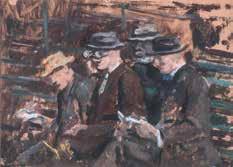


exciting in the sunlight. He saw the beauty in the tack the horsemen cherished—the textures of a red satin cap, shiny little leather boots and saddles, stirrups and whips, fresh white leg bandages, rub cloths, buckets and blankets.
Down through the years, he portrayed faithfully and with love both the reality and the romance of life around the horses in all of its grimness and greed, its gaiety and glamor, and even at times, its nobility. Perhaps most but not all of the nobility is to be found in Townsend’s horses themselves—these beautiful animals used by men for so many varied purposes: to earn a living, to gain fame, to cherish and care for as one would a child, to “improve the breed,” and to win and lose money. There is no end to what Lee Townsend’s pictures can tell us about ways of life if we have eyes to see and a heart to understand.
For a man who was as articulate as Lee Townsend—he could and did hold the attention of a roomful of people for hours with his stories—he was uncommunicative about his art. He talked about projected pictures—ideas, visions. He discussed various mediums and would copy and mix formulas from former painters’ notebooks. He worried about colors, particularly, for
73 | Lee Townsend (American, 1895–1965)
(e) JOCKEY AND VALET
Oil on board, 8” x 10”
Signed
(f) PUNTERS
Oil on paper, 10” x 13 ½”
(g) STUDY OF “CLEAR TRACK”
Oil on board, 8 ½” x 11 ½”
Provenance: The Racing Scene Gallery, New York. Exhibited: The Art of Lee Townsend, National Museum of Racing and Hall of Fame, Saratoga Springs, NY: July 10–Sept. 6, 1999.
(h) HATFIELD FAIR
Pen and ink, 10 ½” x 12 ½”
Signed, inscribed
Provenance: Beresford Gallery
$7,000. – 10,000.
(e)
(f)
(g)
(h)
74 | Lee Townsend (American, 1895–1965)
(i) TWO JOCKEYS UP
Pastel, 15” x 22”
Initialed
Provenance: Beresford Gallery
(j) GOING OUT
Oil on canvas, 12” x 16”
Signed
Provenance: Mrs. Lee Townsend
(k) DROPPED THE WHIP
Ink, watercolor, 9 ¾” x 14 ½”
Signed
Provenance: Mrs. Lee Townsend
(l) TACTICS
Charcoal, 14” x 16 ½”
Provenance: Beresford Gallery
$7,000. – 10,000.
example, how to get sunlight into a Townsend sky which, no matter how hard he tried, always ended by being overcast. He worked and puttered over frames, but there was one thing he seldom did—he did not discuss art with an esoteric capital A. He was a doer, not a theorist. He loved people and animals, not ideas; he was so irrevocably an individual—Lee Townsend (without even being aware of this)—that there was absolutely no distinction between the man and the artist: they were one and the same at all times, in all places.
In the truest sense, Lee Townsend embraced all of the essential goodness in life—the parts of life that he knew, understood, and loved were simple, unsophisticated, sincere like himself. His paintings are simple, unsophisticated, sincere, and, above all, honest like himself. They had to be; they were Lee Townsend. That is why Lee Townsend seldom did “horse portraits.” He would have had to make the animals look the way the owner wanted to see them, or make them look like a Munnings, a Stubbs, or a Marshall. Lee Townsend did not know how to compromise; his horses, his people, his barns, his tracks, his jockeys were Townsend horses, people, barns, tracks, and
(i)
(k)
(l)
(j)
jockeys. Money, recognition, acclaim, these might come after the fact of the completed painting; they were not considered before nor were they ever the chief reasons for his paintings.
Lee Townsend always went along in his own quiet way doing his own work. When he changed his style and palette, he did so because he was seeing brighter colors and greater depths. When he broadened his subjects from harness to flat racing, or from county fairs to the big tracks, he did so because the course of his life had taken him from one to the other. When Andy Warhol became successful with his soup cans, it would never have occurred to Lee Townsend to start painting oversized bottles of horse liniment, yet we all know artists who in one way or another did just this. It is a truism that time takes care of both the bandwagoners and those who doggedly go along at their own pace saying what they have to say in their own way. If what these artists have to say is original and if it has substance, they will eventually receive widespread recognition and find their place in the great mainstream of American painting.
— HELEN WILLIAMS TOWNSEND
75 | Lee Townsend (American, 1895–1965)
(m) TWO JOCKEYS STUDY
Pastel, 15 ½” x 19 ½”
Initialed
Provenance: Beresford Gallery
(n) PADDOCK CROWD
Pastel, 11” x 14”
(o) SURPROMENE
Ink, watercolor, 9” x 5 ½”
Inscribed
(p) STUDY FOR ‘BIG MOE’S SLATE’
Charcoal, 17” x 12 ½”
Signed
$7,000. – 10,000.
76 | André Moufflet (French, 20th Century) AT THE CHAMP DE COURSE
Oil on canvas, 25 ½” x 33”
Signed, inscribed verso
$4,000. – 6,000.
Depicting several well-known personalities of racing, this is a scene from the Saint-Cloud Racecourse depicting from left to right: Prince Aly Khan, Jockey Johnson, the Aga Khan, Marcel Boussac, and Baron Guy de Rothschild.
77 | Harold Wood (British, 1918–2014)
STUDY — ABBUL AZIZ IBN SAUD
Charcoal on paper, 18” x 18”
Signed, inscribed, dated ’97
$1,000. – 2,000.
Harold Wood began painting full-time in 1953, but his connection to the Arab world started in 1947, when he was commissioned to illustrate the life of King Abdul Aziz. Over the course of three decades, Wood created a remarkable series of 58 watercolor paintings capturing key moments and portraits from the king’s life, completing the series in 1977.
Wood lived and worked extensively in the Middle East, earning the title “Painter of the Arab World.” He was later commissioned by the Sultan of Oman, for whom he painted more than 280 works, many depicting Arabian horses with exquisite detail and reverence.
King Abdul Aziz, also known as Ibn Saud, is remembered not only for the three decades of conquests that made him the ruler of nearly all of central and north Arabia, but also for his immense personal legacy. He had 22 consorts and fathered
nearly 100 children, including 45 sons—many of whom would go on to shape the future of the kingdom.
Wood’s portrayal reflects not just the likeness of the king, but also the regal presence and historic weight of a leader who defined a nation.
78 | Wilhelm Kuhnert (German, 1865–1926)
STUDIES (GULLS, DONKEY, DONKEY AND CAMEL, AT THE TROUGH) (set of four)
Pencil
8 ½” x 12”
9” x 13”
9” x 11 ½”
9 ¼” x 11 ¾”
Donkey Initialed, At the Trough signed, dated ’85
$4,000. – 6,000.
Provenance: The artist’s estate, thence by family descent.
These works appear in the artist’s catalogue raisonné under numbers: 243, 264, 272, and 332.
79 | Lionel Edwards (British, 1878–1966)
GRAND PROCESSION
Gouache on panel, 23 ¾” x 20 ½”
Signed
$6,000. – 8,000.
80 | Mick Cawston (British, 1959–2006)
SLY FOX
Oil on canvas, 20” x 16” (oval)
Signed, dated 1987
$3,000. – 5,000.
81 | John Rotherham (British, b. 1968) THE HOUNDS
Charcoal, wash, 27 ½” x 42 ½”
Initialed.
$5,000. – 7,000.
Scan to hear from the artist.
82 | Larry Wheeler (American, b. 1942) HEADING OUT TO HUNT
Oil on canvas, 18” x 24”
$3,000. – 5,000.
83 | Charles Church (British, b. 1970) TWO EXMOOR HOUNDS
Oil on Canvas, 12” x 14” Signed $5,000. – 7,000.
Scan to hear from the artist.
Scan to hear from the artist.
84 | Charles Church (British, b. 1970)
IDLE GOSSIP
Oil on board, 12” x 11”
Signed, dated ’03
$5,000. – 7,000.
85 | Ricardo Arenys Galdón (Spanish, 1914–1977) GOING OUT
Oil on canvas, 29” x 39”
Signed $4,000. – 6,000.
Scan to hear from the artist.
“I wish your honor could have seen our pack goin’ back to Kennels. Mr. Vaughan and me, bein’ the field walked behind.”
86 | Paul Brown (American, 1893–1958) THE YOUNG ENTRY
Ink, wash
Frontispiece: 9 ½” x 15 ½”
Facing page 8: 13” x 9”
Facing page 102: 11 ½” x 8”
Facing page 134: 8” x 13”
Together with 16 pen & ink individual page vignettes, approximately 8 ½” x 11” each.
Signed, dated ’35
$6,000. – 9,000.
“Showin’ just what Master John done”
“Me and the children be goin’ to do some rat huntin’.”
“The whole business be the turrabilist ever I seen”
This lot includes a copy of the book Colonel Weatherford’s Young Entry by Gordon Grand and illustrated by Paul Brown. The story follows a group of young boys known as the South Dorcester Rattlers and their diversions such as hunting, fishing, and horseback riding. The leader of the club is Colonel Weatherford, a wealthy and respected
member of the community who takes the boys under his wing and teaches them the ways of the gentlemanly pursuits.
Also included is the portfolio case from The Derrydale Press containing the 16 vignettes by Brown used on pages throughout the book.
87 | Graham Smith (British, 1907–1951)
THE BEAUFORT HUNT — ABOVE SODBURY VALE
Oil on canvas, 24” x 36”
Signed, dated ’47
$5,000. – 7,000.
Provenance: Frost and Reed. Roberts Art Gallery, Toronto. Christie’s, November 28, 1995, lot 176.
Graham Smith’s dynamic painting captures the historic Beaufort Hunt in full flight across the rolling hills of Sodbury Vale in South Gloucestershire, an area long renowned for its ideal foxhunting country.
The Beaufort Hunt, one of the oldest and most distinguished in England, has kenneled its hounds at Badminton since 1640. Since the creation of the dukedom in 1682, successive dukes of Beaufort have played active roles in the hunt—either hunting the hounds themselves or serving as masters. Among
them, the 10th Duke, who held the mastership from 1924 to 1984, earned the nickname “The Master” for his lifelong dedication to and immense influence on the sport.
Although now financed by subscription, the Beaufort Hunt remains one of the few private packs still in operation. The hunt’s unique dress is also distinctive: The huntsman and whippers-in wear green while subscribers don a blue coat with buff facings—collectively known as the Beaufort Liveries.
Smith’s artwork not only portrays the thrill and tradition of the chase, but also pays tribute to the enduring legacy of one of Britain’s most iconic hunts.
88 | Mary Viola Paterson (Irish, 1899–1981)
RACING STABLES
Oil on canvas, 24” x 30”
Signed $6,000. – 9,000.
Provenance: Panter & Hall, London
89 | Michael Lyne (British, 1912–1989)
MENDIP HUNT — FIRST DRAW
Watercolor, gouache, 17” x 23 ½”
Signed
$5,000. – 7,000.
This painting by Michael Lyne captures the rich tradition of foxhunting in the Mendip Hills of Somerset, England, a landscape long favored by riders and hounds for its open, rolling terrain.
The Mendip Hunt was established in 1914 by the Tiarks brothers, who gathered a pack of foxhounds to pursue the sport across this dramatic countryside. Their efforts were soon halted by the outbreak of the World War I, but the tradition was revived in 1920 when the Wells and Stanton Drew Harriers resumed the chase under Captain E.H. RouseBoughton at Ston Easton.
A turning point came in 1921, with the appointment of C. Hilton Green—regarded as the most influential of the Mendip Masters. Within a year, he had restored the hunt to its former stature as the Mendip Foxhounds, relocating the kennels to Priddy and solidifying its place in the region’s cultural identity.
Lyne’s brushwork pays homage not only to the thrill of the hunt, but also to a storied legacy that continues to echo through the hills of Somerset.
90 | Michael Lyne (British, 1912–1989)
THE BEAUFORT - TOGG HILL
Watercolor, gouache, 13 ½” x 20”
Signed
$4,000. – 6,000.
Provenance: The Sportsman’s Gallery
Togg Hill offers scenic views and the perfect landscape for the historic sport of fox hunting. The Beaufort Hunt is one of the oldest and largest fox-hunting packs in England, with hunting in the area dating back to 1640. The hunt covers more than
700 square miles between Bath, Cirencester, Malmesbury, and Nailsworth. The 10th Duke of Beaufort was the greatest contributor to the hunt, acting as master from 1924 to 1984, universally becoming known just as “Master.”
91 | Michael Lyne (British, 1912–1989) THE MEYNELL HUNT — IN THE ORANGE Watercolor, gouache, 16 ¾” x 23 ¾”
Signed $5,000. – 7,000.
Provenance: Frost and Reed
This painting by Michael Lyne captures the legacy of the Meynell and South Staffordshire Hunt, one of Britain’s most historic and celebrated packs.
Tracing its origins to 1793, the hunt began under the Vernon family of Sudbury, Derbyshire. Following the death of Lord Vernon in 1813, the Meynell family assumed leadership, renaming the pack the Hoar Cross Hunt. Over time, it would become known as the Meynell Hunt, with the construction of dedicated kennels at Sudbury in 1872 marking its evolution into a subscription-based pack.
Renowned for its distinguished history and strong hunting country, the Meynell and South Staffordshire Hunt was described by “Horse & Hound” in 2021 as “one of the most famous packs of hounds in the country,” and was a favorite of King Charles. After nearly 230 years of continuous tradition, the hunt rode out for the final time in 2023.
Lyne’s work preserves the spirit of this historic institution, capturing not just a moment in the field, but the heritage and pageantry of a countryside tradition now consigned to history.
92 | Ayerst Young (British, 1895–1952)
A CHECK AT TAMBORO
Oil on canvas, 16” x 22”
Signed, inscribed verso
$4,000. – 6,000.
93
| Martin Stainforth
(British, 1866–1957)
FILANTE WITH FLYING GAL
Watercolor, gouache 9 ½” x 12”
Signed, inscribed
$2,000. – 3,000.
Owned and bred by Belair Stud, Flying Gal, daughter of the legendary sire Sir Galahad and dam Filante, pictured here, was among Sir Galahad’s most influential broodmare daughters, contributing to his distinction as the leading broodmare sire in the United States an impressive 12 times.
94 | Harold Septimus Power (Australian, 1877–1951)
MARE AND FOAL
Oil on canvas, 13” x 19”
Signed $4,000. – 6,000.
95 | Lucy Kemp-Welch (British, 1869–1958)
HORSES IN A LANDSCAPE
Watercolor, 13 ½” x 15 ¾”
Signed $4,000. – 6,000.
96 | Richard M. Firth (British, b. 1954) AMERICAN YACHT VIGILANT RACING
HMY BRITANNIA ON THE CLYDE, 1894
Oil on canvas, 24” x 36” Signed, inscribed verso $20,000. – 30,000.
In the summer of 1894, the American yacht Vigilant and the British royal yacht Britannia engaged in a series of exciting races on the Clyde. The races, part of the Clyde Fortnight, drew large crowds and intense public interest, particularly because Vigilant had previously won the America’s Cup and was now competing against Britannia, a highly successful and famous racing cutter.
Britannia, built for King Edward VII when Prince of Wales in 1893, was undoubtedly the most famous racing cutter of them all. Hugely successful during her long life, she won 33 firsts out of 39 starts in her maiden season and competed against all the fastest yachts of the day. Sold in 1897—although bought back for cruising in 1901 by which time the Prince of Wales had succeeded to the throne—her second racing career really came into its own when King George V had her refitted for big class competitions in 1921. Under the king’s enthusiastic ownership, Britannia went from success to success. Despite being re-rigged seven times in all, her hull shape was so
efficient that she remained competitive almost to the end and was only finally outclassed by the big J-class boats introduced in the mid-1930s. King George V died in 1936 and under the terms of his will, Britannia was stripped of her salvageable gear and scuttled off the southern tip of the Isle of Wight.
Vigilant, 96 tons, was designed and built by the great Nat Herreshoff for a wealthy American syndicate headed by C. Oliver Iselin. Ordered in response to Lord Dunraven’s 1892 challenge for the America’s Cup, Vigilant won all three of the Cup races in October 1893 to retain the trophy in one of the closest finishes in the race’s history. After this triumph, she crossed the Atlantic for the 1894 season and there encountered Britannia against which she would sail so often in that golden summer. Many yachtsmen of the day considered her to be Britannia’s most worthy adversary and their duels were still being talked of long after the Prince of Wales had sold his yacht in response to the Kaiser’s obsessive jealousy.
97 | Rodney Hilton Brown (American, Contemporary) FIST OF MUHAMMAD ALI
Bronze, 4 ½” x 5”
$5,000. – 7,000.
Provenance: The War Museum, Fairhaven, MA.
Edition of 6.
Brown was a personal friend of Ali’s, and eventually authored the book Muhammad Ali – The Untold Story: Painter, Poet & Prophet. Brown personally cast Ali’s right “knockout” fist in the boxer’s room at the Plaza Hotel in 1979. At the time, Ali was extremely averse to putting his hand into a mold, and not even the Boxing Hall of Fame had been able to persuade
him. Brown ended up getting the cast using a gel typically used for dental implants in order to get the example quickly.
The plate on the front makes reference to the fact this cast was done after Ali’s third World Heavyweight Championship, the first and only boxer to achieve the feat.
98 | LeRoy Neiman (American, 1921–2012)
RACING SUITE (set of three)
Bronze, 16 ¼” x 23 ½” and 12” x 5” (two)
Signed, edition 81/100
$6,000. – 8,000.
Provenance: The estate of Alex Campbell
99 | LeRoy Neiman (American, 1921–2012)
Oil/mixed media on canvas, 60” x 48”
Signed, dated ’85
$150,000. – 200,000.
Provenance: Timothy Yarger Fine Art, Beverly Hills
LADY LIBERTY
100 | LeRoy Neiman (American, 1921–2012)
THE GRAND NATIONAL STEEPLECHASE
Mixed media, 20” x 30”
Signed, inscribed
$15,000. – 20,000.
Provenance: The Playboy Archives.
Illustrated: Playboy Magazine, March 1962, pages 94-95. A copy of that issue will be included in the lot.
This work illustrated the series “Man at His Leisure: Neiman Sketches England’s Grand Grand National,” with the caption “Vividly hued jockey silks highlight the gray English scene at Aintree as fashionably garbed gentlemen and their ladies observe the Grand National’s prepost Parade.”
Neiman included the biplane with an advertising banner for “Dick Seymour – Bookmaker.”
101 | LeRoy Neiman (American, 1921–2012) NATIONAL HORSE SHOW, OPENING NIGHT
Acrylic on paper, 20” x 26”
Signed
$25,000. – 35,000.
Provenance: Playboy Enterprises, Inc.
Exhibited: Museum of Fine Arts, Springfield, MA.
Illustrated: Playboy, November 1967.
A copy of the November 1967 issue of Playboy Magazine will accompany the lot.
Neiman portrays Madison Square Garden on the opening night of the National Horse Show, the grandest event on the prestigious indoor horse show circuit. Featuring an international jumping competition, the show drew a who’s who of high society bedecked in gowns and tails, who turned out to experience the suspense that arises as horse and rider tackled the course. The setting allowed the artist to express his longtime interest in high fashion complemented by the brilliant range of colors represented in the flags of the
competing nations. All the color—the black curtain cast across the crowd, courtesy of the gentlemen’s suits, and fine detail, all juxtaposed against the brilliant red clay of the footing and the jumps interspersed throughout—accentuated the pageantry of the event.
When this work was done, Madison Square Garden was the home of the National Horse Show. The event has subsequently been moved to the Kentucky Horse Park.
102 | LeRoy Neiman (American, 1921–2012) GREENTREE FARMS
Mixed media, 17” x 22”
Signed, Dated “4-8-’78”
$7,000. – 10,000.
Provenance: The estate of Alex Campbell
Illustrated: LeRoy Neiman, Horses, New York: Abrams Incorporated, 1979, page 309.
Depicting Stage Door Johnny and Indian Queen on April 8, 1978, the day they were together for a breeding session. Attached is a breeding card from the farm noting the schedule and that Dancer’s Pet was also to meet with Foolish Pleasure at the same time. Neiman visited Greentree and noted Stage Door Johnny covered 45 mares in 135 days.
“At Greentree Stud in Lexington, Kentucky, the ‘lovemaking’ is carried out in a breeding shed that has a large door at each end (one for mares, one for stallions). The floor is covered
with dampened tanbark shavings to ensure good footing and prevent dust. The walls of the shed are painted a soothing, pale aqua-green and the four corners are padded because from time to time things can get a little out of hand. On beautiful days at Greentree, the mating is sometimes carried on outside the breeding shed, in the shade of the sycamore trees.”
LeRoy Nieman, Horses, page 311.
103 | Andre Pater (Polish/American, b. 1953) GUARDIANS OF THE BAG Pastel, 32” x 39 ¼”
Signed $50,000. – 60,000.
Illustrated: A Matter of Light: The Art of Andre Pater. Lexington, Ky.: Fincastle Publishing, 2019, pages 224-225.
A HUNTER’S GERMAN SHORTHAIR WITH PHEASANT Pastel on board, 24” x 18”
Signed $30,000. – 40,000.
104 | Andre Pater (Polish/American, b. 1953)
105 | Larry Wheeler (American, b. 1942) SURF CASTING
Oil on canvas, 18” x 24”
Signed $3,000. – 5,000.
106 | Brett James Smith (American, b. 1958) ROCK CREEK
Oil on canvas, 11” x 14”
Signed $3,000. – 5,000.
Scan to hear from the artist.
107 | Sandra Oppegard (American, b. 1941) FISHING IN BITTERROOT VALLEY
Watercolor, 10” x 15”
Signed
$1,000. – 2,000.
This work is the finished version of a study that appeared in the chapter titled “Ghost Birds” in the book Tranquility Revisited. In Colonel Harold P. Sheldon’s book, the
108 | Aiden Lassell Ripley
(American, 1896–1969) GHOST BIRDS
Watercolor, 17” x 23”
Signed
$15,000. – 20,000.
legendary sportsman recounts a Vermont autumn when the grouse shooting was particularly great.
Scan to hear from the artist.
109 | Emma Faull (British, b. 1956) KINGFISHER, SNIPE, AND DAMSELFIES
Watercolor, Pen and Ink, 28” x 22”
Signed, dated 2025
$4,000. – 6,000.
110 | Emma Faull (British, b. 1956) EVENING SWALLOWS
Watercolor, Pen and Ink, 28” x 22”
Signed, dated 2025
$4,000. – 6,000.
Scan to hear from the artist.
111 | Heinrich Von Michaelis (South African, 1912–1990)
‘THE FAMILY OF FISCAL SHRIKES’ AND ‘FEEDING TIME’ (a pair) Oil on board, 14” x 17” (each)
Signed $1,000. – 2,000. (pair)
Provenance: Tryon Gallery. Jim Fowler. The estate of Alex Campbell.
Jim Fowler was an American zoologist best known for being the host of the television show Wild Kingdom for which he won four Emmy Awards. In 1988 he became the official wildlife correspondent for NBC’s The Today Show and in 1997 he joined Animal Planet as a wildlife expert as well.
112
|
Rikki Morley-Saunders
(American, b. 1951) PEACOCK
Bronze, 10 ¼” x 18”
Signed $3,000. – 5,000.
Scan to hear from the artist.
113 | Jo Taylor (British, b. 1969) ELK
Mixed Media, 35” x 59”
Signed
$9,000. – 11,000.
Scan to hear from the artist.
114 | Jo Taylor (British, b. 1969) BARN OWL
Mixed Media, 35” x 59”
Signed
$9,000. – 11,000.
Scan to hear from the artist.
Oil on canvas, 48”
Signed, inscribed verso
$8,000. – 10,000.
115 | Andrew Bolam (British, b. 1971)
Jessamyn Parker (American, b. 1980)
BACCHANAL
x 36”
Scan to hear from the artist.
116 | Sophie Brouillet (Canadian, b. 1966) JUST A BUFFALO
Acrylic on canvas, 30” x 30”
Signed, inscribed verso
$3,000. – 5,000.
117 | Leslie Peck (American, b. 1965) CHICKENS
Oil on canvas, 24” x 36”
Signed
$6,000. – 9,000.
Scan to hear from the artist.
Scan to hear from the artist.
118 | Kelly Brewer (American, b. 1970) HEREFORD HARMONY Oil on canvas, 30”
Signed $9,000. – 12,000.
x 40”
Scan to hear from the artist.
Oil on canvas, 48” x 48”
Signed, inscribed, dated 2025 verso
$9,000. – 12,000.
119 | Diana Tremaine (American, b. 1964) FLIGHT
Scan to hear from the artist.
120 | Andre Pater (Polish/American, b. 1953) WATERMELON JOCKEY
Pastel, 36” x 24”
Signed, dated ’04
$60,000. – 90,000.
Exhibited: “The Bluegrass Palette of Andre Pater,” University of Kentucky Art Museum, June 27 – October 10, 2010. Illustrated in the accompanying catalogue on page 45.
Illustrated: A Matter of Light: The Art of Andre Pater, Lexington, Ky.: Fincastle Publishing, 2019, page 147.
121 | Pierre Bellocq (a.k.a. Peb) (French, b. 1926)
THE COACH
Pen and ink, watercolor
Signed
$5,000. – 8,000. (set of 4)
TIMBER, 11 ½” x 16”
CHEZ LUKAS, 8 ½” x 11 ½”
AFFIRMATIVE ACTION, 9” x 13”
1995 PREAKNESS, 13” x 12”
Provenance:
The collection of Bob and Beverly Lewis
Proceeds from this lot to benefit the Race Track Chaplaincy of America.
CHEZ LUKAS
This scene, reminiscent of a French cafe, portrays trainer D. Wayne Lukas as the chef and his then-newest Kentucky Derby sensation Thunder Gulch as the wealthy patron, and the Preakness Stakes as their next target along the 1995 Triple Crown trail. Thunder Gulch, sent off at 24-1 in the Derby, proved best over the colt’s more heralded Bob and Beverly Lewis-owned stablemates and race co-favorites—Timber Country and the filly Serena’s Song—who finished third and 16th respectively, and are depicted as unimpressed wait staff.
Originally published in the May 14, 1995 edition of the Daily Racing Form, the piece features three horses who all found great success that year. Timber Country would turn the tables on his barn rival and win the Preakness, with Thunder Gulch
finishing third. Thunder Gulch bounced back to win the Belmont Stakes, providing Lukas with a sweep of all three classic races in that year’s Triple Crown. And it would be Serena’s Song who would win eight graded stakes that season, and be named 3-Year-Old Filly Champion.
MIGHTY LUKAS IN THE 1995 PREAKNESS
This watercolor likens trainer D. Wayne Lukas to a mythological Zeus-like figure in the thunderclouds hovering over the entries for the 120th Preakness Stakes. Heading into the race, the legendary trainer had already won the middle jewel in the Triple Crown three times. For the 1995 running, Lukas had two formidable contenders in Thunder Gulch and Timber Country, who two weeks earlier had finished first and third, respectively, in the Kentucky Derby.
While the rest of the race contenders fearfully look above, Maryland Jockey Club CEO Joe De Francis is shown preparing to paint the winner’s colors on the historic Pimlico Clubhouse cupola weathervane.
In the end, Timber Country won the prestigious race, providing Lukas with his fourth Preakness Stakes victory. This image was featured as the cover art for the May 20, 1995 edition of the Daily Racing Form.
TIMBER — 1995 SANTA ANITA DERBY
This watercolor depicts several of the connections for the entrants running in the 1995 Santa Anita Derby, including the Breeders’ Cup Juvenile champion Timber Country, owned in partnership by Bob and Beverly Lewis and Overbook Farm. Depicted as lumberjacks in this piece are Bob Lewis and Overbrook’s W.T. Young along with his Hall of Fame trainer D. Wayne Lukas and jockey Pat Day, who is portrayed in caricature birdlike form. Also represented are the race’s key contenders shown adorned in the plumage of their respective stable colors.
Timber Country finished fourth but would go on to classic success, finishing a fastclosing third in his next start
in the Kentucky Derby, following up that effort with a victory in the Preakness Stakes in his final career start. This piece was featured as the cover art for the April 8, 1995 edition of the Daily Racing Form
AFFIRMATIVE ACTION FOR SERENA’S SONG
This sketch represents the decision facing trainer D. Wayne Lukas regarding the talented filly Serena’s Song leading up to the 1995 Kentucky Derby. In early April, Serena’s Song had taken on the boys and defeated them convincingly in a front-running victory in the Jim Beam Stakes at Turfway. The difficult decision for Lukas centered upon whether to let Serena’s Song face a field of fillies only in the Kentucky Oaks, or try to emulate the 1988 Derby success of his champion filly Winning Colors, and once again race Serena’s Song against the colts in the more prestigious Kentucky Derby. In the humorous sketch, a sulking Serena’s Song is depicted bedecked in a Derby bowler cap, striped dress representing the silks design of the Lewis stable, and an affirmative action button pleading her case to run. In the background, the smiling portrait of Winning Colors is portrayed in contrast to trainer Lukas wearing his distinctive leather fringed chaps, nervously pacing in the background.
Ultimately Lukas selected the Derby for the front-running Serena, who led the field into the stretch before fading badly to finish 16th. Following the Derby, Serena’s Song would bounce back in a big way, winning the Grade 1 Black-Eyed Susan, Mother Goose, Haskell (against colts), Gazelle, and Beldame Stakes, after which she was named 1995 champion 3-year-old filly.
122 | Peter Smith (British, 1949–2025) FINAL BEND — SAN MORITZ
Oil on canvas, 22” x 30”
Signed
$4,000. – 6,000.
Set against the breathtaking backdrop of the Swiss Alps, this prestigious event features exhilarating races and exceptional equestrian skill—staged on the frozen surface of Lake St. Moritz.
123 | Thomas Coates (British,1941–2023) & Andre Pater (Polish/American, b. 1953)
GYPSY ENCAMPMENT, HAMPSHIRE
Oil on canvas, 20” x 24”
Signed
$30,000. – 40,000.
This unique piece was created as a collaboration between two renowned artists, Thomas Coates and Andre Pater. The landscape featuring the English countryside was painted by Tom Coates in his typical painterly style. The gypsy scene inspired by Sir Alfred J. Munnings was painted by Andre Pater and the work was signed by both artists.
124 | Diana Tremaine (American, b. 1964) DEVOTED
Oil on canvas, 36” x 60”
Signed, inscribed, dated 2025 verso
$10,000. – 15,000.
Scan to hear from the artist.
Oil on board, 24” x 30”
Signed $4,000. – 6,000.
125 | Bill Fletcher (American, b. 1958) KEENELAND SYCAMORE
Scan to hear from the artist.
Signed $9,000. – 12,000.
126 | Jaime Corum (American, b. 1973) WINTER Oil on canvas, 36” x 24”
Scan to hear from the artist.
127 | Weatherly Stroh (American, b. 1974)
Oil on canvas, 36” x 36”
Signed $6,000. – 9,000.
AQUAMARINE
Scan to hear from the artist.
Oil on canvas, 24” x 36”
Signed, inscribed $6,000. – 9,000.
128 | Marcus Hodge (British, b. 1966) EL ROCIO
Scan to hear from the artist.
Signed $4,000. –
Signed $4,000. – 6,000.
129 | Marcus Hodge (British, b. 1966) THE PINK SHIRT
Oil on Panel, 14” x 20”
6,000.
130 | Peter Curling (Irish, b. 1955) IN THE STRETCH
Oil on canvas, 16” x 24”
Scan to hear from the artist.
131 | Jill Soukup (American, b. 1969) ON THE EDGE OF GO Oil on board, 18 ¼” x 36” Signed $7,000. – 10,000.
Scan to hear from the artist.
132 | Janet Hammond (American, Contemporary) BEFORE THE RACE Oil on
Signed $4,000. – 6,000.
canvas, 22” x 28”
133 | Quang Ho (Vietnamese / American, b. 1963) AFTER BATH
Oil on board, 18” x 23”
Signed $6,000. – 9,000.
134 | Quang Ho (Vietnamese / American, b. 1963) DOWN THE STRETCH
Oil on board, 18” x 33 ¼”
Signed, inscribed, dated 2025 verso $9,000. – 12,000.
135 | Quang Ho (Vietnamese / American, b. 1963)
HEADING TO POST
Oil on board, 16” x 24”
Signed $6,000. – 9,000.
136 | Larry Wheeler (American, b. 1942)
KEENELAND SPRING
Oil on canvas, 20” x 24”
Signed $4,000. – 6,000.
Scan to hear from the artist.
137 | Alan Brassington (Irish, b. 1959)
MOTIVATOR
Oil on canvas, 56” x 32”
Signed verso
$9,000. – 12,000.
Motivator had a relatively short yet highly successful racing career, winning four of his seven starts. In 2005, racing in the colors of the Royal Ascot Racing Club, Motivator captured the Epsom Derby, one of England’s most coveted classic races. Motivator is one of many top-class middle-distance horses and stayers sired by Montjeu and is out of the American-bred mare Out West, making him a half-brother of the Hardwicke Stakes winner Macarthur. Motivator was named England’s Horse of the Year and champion 3-year-old colt of 2005.
Alan Brassington, who is widely regarded as one of the top artists in his field, serves as the artist in residence for the Royal Ascot Racing Club. Throughout his residency, Brassington has brought many of the club’s greatest horses to life on canvas in his truly unique hyperrealist compositions.
138 | Peter Smith (British, 1949–2025) SHARP WORK
Oil on canvas, 26” x 36”
Signed $6,000. – 9,000.
139 | Sandra Oppegard (American, b. 1941) SPRING
Watercolor, 19” x 24”
Signed $3,000. – 5,000.
This work appeared on the cover of the Spring 2025 issue of Keeneland Magazine A copy of that issue will accompany the lot.
Scan to hear from the artist.
140 | Sandra Oppegard (American, b. 1941) FIVE RIDERS, CLOUDY DAY
Watercolor, 18 ½” x 14”
Signed $2,000. – 3,000.
141 | Weatherly Stroh (American, b. 1974) BOWING
Oil on board, 24” x 12”
Signed $2,000. – 3,000.
Scan to hear from the artist.
Scan to hear from the artist.
142 | Sandra Oppegard (American, b. 1941) SIERRA LEONE WINNING THE WHITNEY
Watercolor, 22” x 30” Signed, inscribed verso $4,000. – 6,000.
Sierra Leone continued his remarkable run with a decisive victory in the grade 1 Whitney Stakes at Saratoga. The win for the 2024 champion 3-year-old male marked a milestone for trainer and New York native Chad Brown, who earned his first-ever Whitney triumph.
True to form, Sierra Leone settled at the back of the pack early in the race before finding his way through and closing on the leaders with plenty of run left, finishing a length ahead of favored Fierceness.
Scan to hear from the artist.
Porcelain,
Signed $4,000. – 6,000.
143 | Carl Dahl (American, b. 1952) ON HIS TOES
18 ½” x 16”
Scan to hear from the artist.
Bred by Dr. Elisha Warfield near Lexington, Kentucky, Lexington was by Boston, out of Alice Carneal. The winner of six of his seven starts on the track, he had even greater influence at stud. He was the most successful sire of the second half the 19th century and was the leading North American sire 16 times. A member of the inaugural class of the National Museum of Racing and Hall of Fame, his bloodline still lives on today through his daughters. Spendthrift, Hanover, Himyar, Holy Bull, Mucho Macho Man, and Tiznow are just some of his descendants.
144 | Gwen Reardon (American, 1932–2024) LEXINGTON
Bronze, 17” x 27”
Signed, edition 10/20
$3,000. – 5,000.
Provenance: The estate of Alex Campbell
145 | Liza Todd-Tivey (American, b. 1957) NORTHERN DANCER
Bronze, 16” x 20”
Signed, edition 15/55
$3,000. – 5,000.
An example appears on page 193 of Great Racehorses in Art by John Fairley.
Reardon is perhaps best known for her life-size equine sculptures that adorn Thoroughbred Park in downtown Lexington, Kentucky. She was also the sculptor of the life-size horse and groom sculptures at Blue Grass Airport, Lexington.
“I believe Gwen Reardon to be the best equine sculptor in America today. What makes her work so unique and outstanding is not only her great talent but also her background as a horsewoman and trainer.” — Alex Campbell
146 | Jan Woods (American, b. 1944) BUCK
Signed
$5,000. – 7,000.
AT THE SALE
Bronze, 15 ½” x 16 ½”
147 | Paul Guiramand (French, 1926–2008) HORSE & RIDER
Bronze, 23” x 32 ½”
Signed, edition 2/8
$12,000. – 15,000.
Presented by Yves Naquin on behalf of Monaco Artists Group to Mr. Michel Russo in gratitude for services rendered and support of the Monaco Artists Group. Monaco, November 15, 2006
148 | Nicola Lazzari (Italian, b. 1961) BOLGHERI
Bronze, 11” x 17”
Signed
$9,000. – 12,000.
149 | Max Tannahill (Irish, b. 1959) SOLE
Bronze, 19” x 9”
Signed, dated 2021, edition 5/10
$8,000. – 10,000.
Scan to hear from the artist.
Wood, 18” x 22”
Signed, dated 2025
$3,000. – 5,000.
150 | Max Tannahill (Irish, b. 1959) BOAR
Scan to hear from the artist.
151 | Nick Bibby (British, b. 1960)
WILD BOAR
Bronze, 12 ¼” x 16”
Signed
$14,000. – 16,000.
“The European Wild Boar. The ancient ancestor of so many pig breeds, the wild boar is an incredibly impressive animal, with its powerful build, thick, bristly coat and razor-sharp tusks.” —Nick Bibby
152 | Nick Bibby (British, b. 1960)
INDIAN RHINO
Bronze, 11 ½” x 17 ½”
Signed, edition 9/12
$15,000. – 20,000.
“The Indian Rhino has to be one of the most impressive animals on earth and a gift to any artist – so sculptural! I simply had to revisit the subject, so that I could have even more fun with the amazing textures, skin folds, and character of these almost prehistoric beasts.” —Nick Bibby
153 | Rikki Morley Saunders (American, b. 1951) BELLA
Bronze, 18” x 39 ¾”
Signed, dated 2015, edition 2/28 and 4/28 $25,000. – 35,000.
Scan to hear from the artist.
154 | Hubert de Watrigant (French, b. 1954)
PONYING
Oil on paper, 19” x 22”
Signed $4,000. – 6,000.
155 | Neil Cawthorne (British, 1936–2022) SADDLING PADDOCK
Oil on canvas, 24” x 36”
Signed, dated ’67
$4,000. – 6,000.
Scan to hear from the artist.
CLYDESDALE
Oil on canvas, 30” x 40” Signed
$5,000. – 7,000.
156 | Malcolm Coward (British, b. 1948)
157 | Frank Eber (American, b. 1966) FARRIER WORKING
Oil on board, 16” x 20”
Incised signature
$3,000. – 5,000.
158 | Frank Eber (American, b. 1966) STABLES AT YOSEMITE VALLEY
Watercolor, 15 ½” x 19 ¼”
Signed, dated ’23
$2,000. – 3,000.
Scan to hear from the artist.
Scan to hear from the artist.
159 | Melinda Brewer (Canadian, b. 1957)
SEABISCUIT
Oil on board, 24” x 30” Signed $5,000. – 7,000.
Seabiscuit was a small, unassuming Thoroughbred who defied all odds to become one of the most celebrated racehorses in American history. Standing just 15.2 hands, with knobby knees and a quiet demeanor, he had a rocky start—losing his first 17 races and largely being overlooked by early trainers and owners. However, after showing promise in minor races, he caught the attention of trainer Tom Smith and new owner Charles S. Howard in 1936. With jockey Red Pollard, Seabiscuit began to thrive, gaining a loyal fan base, especially in California.
In 1937, he won 11 of 15 races and became the nation’s leading money earner, though overshadowed by Triple Crown winner
War Admiral. In 1938, a highly anticipated match race between Seabiscuit and War Admiral took place at Pimlico. Despite being the underdog, Seabiscuit, ridden by George Woolf, won decisively by four lengths in what was dubbed the “Race of the Century,” earning him the title of American Horse of the Year.
After recovering from a serious injury alongside Pollard, Seabiscuit made a triumphant return in 1940, winning the Santa Anita Handicap before retiring to stud at Ridgewood Ranch. His legacy lives on as a true rags-to-riches American sports legend.
Scan to hear from the artist.
160 | Susan Crawford (British, b. 1941) STAGE DOOR JOHNNY AT GREENTREE Oil on board, 12” x 16”
Signed $5,000. – 7,000.
Stage Door Johnny was a striking chestnut colt who upset Triple Crown dreams in 1968. Easily recognized by his chestnut coat and bold white blaze, Stage Door Johnny was bred and raced by the Whitney family’s esteemed Greentree Stable. A son of Prince John and grandson of the influential Princequillo, he carried both speed and stamina in his bloodline. Stage Door Johnny etched his name in racing history with a powerful performance in the Belmont Stakes, the final leg of the U.S. Triple Crown. That year, Forward Pass had already claimed the Kentucky Derby—by disqualification—and the Preakness and was poised to become
the first Triple Crown winner in two decades. But in a dramatic turn, Stage Door Johnny surged past him at Belmont, dashing the hopes of a controversial champion and sealing his own place in racing lore. Retired to stud, Stage Door Johnny became a successful sire, producing multiple stakes winners. His legacy extended further through his daughters, most notably as the dam sire of Go for Gin, the 1994 Kentucky Derby winner. This painting celebrates more than a single victory—it honors a colt who redefined a season and secured a lasting influence on the American Thoroughbred.
161 | John Fitzgerald (Irish, b. 1976) JUSTIFY Oil on board, 16” x 24” Signed $4,000. – 6,000.
Scan to hear from the artist.
162 | Jaime Corum (American, b. 1973) CURLIN
Oil on canvas, 30” x 38”
Signed, inscribed
$5,000. – 7,000.
Scan to hear from the artist.
163 | Sean Michael Chavez (American, b. 1971)
TORRIE HORSE
Oil on board, 40” x 30”
Signed, inscribed, dated 2025 verso
$8,000. – 10,000.
“The Torrie is a fantasy painting. It imagines Giovanni da Bologna’s scupture from 1580 and the Breeders’ Cup Trophy come to life — elegant and ethereal.”
— SM Chavez
Scan to hear from the artist.
164 | Sean Michael Chavez (American, b. 1971) LUCKY SEVENS
Oil on board, 40” x 30”
Signed, inscribed, dated 2025 verso
$8,000. – 10,000.
This Breeders’ Cup commission continues Chavez’s focus on the American West with the thoughtful approach that has made his work highly sought after. Known for his portraits of the vaquero, Chavez blends tradition with contemporary elements, offering a balanced and enduring perspective on Western art.
“Lucky Sevens depicts upon a podium the jockey and his horse standing tall and proud in the royal purple of the Breeders’ Cup. In the background, a rendering of the historic Del Mar race track — creating a sense of place.”
— SM Chavez
Scan to hear from the artist.
165 | Andre Pater (Polish/American, b. 1953) BREEDERS’ CUP, 1999 Oil on canvas, 34” x 48”
Signed $90,000. – 120,000.
Illustrated: A Matter of Light: The Art of Andre Pater, Lexington, Ky.: Fincastle Publishing, 2019, pages 102-103.
Andre Pater was the official artist for the 1999 Breeders’ Cup, held at Gulfstream Park.
166 | Tony Thielen (American, b. 1973) PEARL’S SISTER
Oil on canvas, 20” x 20”
Signed, inscribed verso
$2,000. – 3,000.
167 | Hubert de Watrigant
(French, b. 1954)
TRIUMPHANT RETURN
Oil on canvas, 23 ½” x 23 ½”
Signed
$6,000. – 9,000.
Scan to hear from the artist.
Scan to hear from the artist.
168 | Suzy Smith (American, b. 1951) CROW SCOUT, CURLY Charcoal, pastel, 19” x 16” Signed $2,000. – 3,000.
Curley, or “Curly,” was a Crow Indian scout assigned to Lt. Col. George Armstrong Custer’s regiment during the Battle of the Little Bighorn—also known as the Battle of the Greasy Grass—fought on June 25, 1876, in Montana. This conflict pitted the U.S. Army against a vastly superior force of Sioux, Northern Cheyenne, and Arapaho warriors.
Shortly before the battle began, Curley departed from Custer’s camp, making him a distant yet significant witness to the events. He is widely recognized as the first person to report the loss of Custer and all five companies of the Seventh Cavalry under his command.
Scan to hear from the artist.
169 | Connor Liljestrom (American, b. 1995) THOUSAND 174
Oil on paper, 28” x 22 ½”
Signed, inscribed verso
$3,000. – 5,000.
Scan to hear from the artist.
Oil on linen, 46” x 38”
Signed, inscribed verso
$8,000. – 10,000.
170 | Connor Liljestrom (American, b. 1995)
WARM WIND VALLEY
Scan to hear from the artist.
171 | David Kammerzell (American, b. 1953) ROUGH RIDER
Oil on canvas, 24” x 18”
Signed $4,000. – 6,000.
Rough Rider is a portrait of Theodore Roosevelt. Teddy, as he was sometimes known, was an American for the ages. He possessed an indomitable spirit that inspired those around him to seek greater success than they otherwise might have had they not known him. He wrote dozens of inspirational quotes that are as relevant and powerful today as they were over 100 years ago.
He is pictured here in his Rough Rider uniform. Roosevelt created a volunteer calvary unit in 1989, which fought in the Spanish American War. The regiment became known as “Roosevelt’s Rough Riders,” a term borrowed from Buffalo Bill, who called his traveling Western show “Buffalo Bill’s Wild West and Congress of Rough Riders of the World.”
Scan to hear from the artist.
Horse racing was one of the most popular sporting events in Texas during the 1930s until the state outlawed pari-mutuel betting in 1937. This painting is a stylized depiction of Arlington Downs, once located in Arlington, Texas, which became a top racing destination during that period. The track’s marque event was the Texas Derby, considered a prep
172 | Alexandre Hogue (American, 1898–1994)
ARLINGTON DOWNS RACE TRACK
Watercolor, 15 ¼” x 18 ¾”
Signed $10,000. – 15,000.
Exhibited: Dallas Museum of Fine Art, 1935
race for the Kentucky Derby. A Texas and Oklahoma artist in the precisionist style, Hogue is recognized for his pivotal role in American regionalism and for using his art to raise awareness about environmental issues. Although known for his paintings of the Dust Bowl era, Hogue painted many other subjects, including horses and horse racing.
173 | Camille Hilaire (French, 1916–2004) PESAGE
Oil on canvas, 18” x 21 ½”
Signed, inscribed verso
$3,000. – 5,000.
174 | Paul Guiramand (French, 1926–2008) CIRCUS HORSES
Oil on canvas, 18 ½” x 26”
Signed
$6,000. – 9,000.
175 | Tyler Robertson (American, b. 1981) THUNDERING HOME
Oil on board, 18” x 24”
Signed
$3,000. – 5,000.
176 | Frank Ashley (American, 1920–2007) BREAKING FROM THE GATE
Oil on board, 16” x 24”
Signed, dated 1963
$3,000. – 5,000.
Scan to hear from the artist.
177 | Frank Ashley (American, 1920–2007) THEY’RE OFF Oil on canvas, 54” x 49”
Signed $9,000. – 12,000.
CHANTILLY
Oil on canvas, 36” x 29”
Signed, inscribed verso
$5,000. – 7,000.
178 | Paul Ambille (French, 1930–2010)
179 | Paul Ambille (French, 1930–2010)
LES DEUX JOCKEYS
Oil on canvas, 29” x 36”
Signed, inscribed verso
$5,000. – 7,000.
180 | Claude Grosperrin (French, 1936–1977)
AU CREUX DU VALLON
Oil on canvas, 24” x 20”
Signed, inscribed verso
$6,000. – 8,000.
181 | Claude Grosperrin (French, 1936–1977)
MOULIN ET CHEVAUX
Oil on canvas, 11” x 14”
Signed, inscribed verso
$3,000. – 5,000.
182 | Claude Grosperrin (French, 1936–1977)
APRÈS-MIDI AUX COURSES
Oil on canvas, 24” x 29”
Signed, inscribed verso
$10,000. – 12,000.
183 | Claude Grosperrin (French, 1936–1977)
LA CHAUSSEE D’IVRY
Oil on canvas, 24” x 29”
Signed, inscribed verso
$10,000. – 12,000.
184 | Claude Grosperrin (French,
1936–1977)
AVANT LE COURSE
Oil on canvas, 32” x 26”
Signed $8,000. – 10,000.
This work will appear on the cover of the Winter 2025 issue of Keeneland Magazine.
TWENTY-TWO HORSES
Acrylic, charcoal and wax crayon on canvas, 80 ¼” x 51 ¼”
Signed $6,000. – 8,000.
185 | Rachael Van Dyke (American, b. 1972)
Scan to hear from the artist.
186 | Philippe Bezard (French, b. 1947) ON THE TURF
Oil on panel, 19 ¾” x 19 ¾
Signed
$3,000. – 5,000.
187 | Serhiy Hai (Ukrainian, b. 1959) RIDING ON THE WIND
Oil on canvas, 39” x 47”
Signed
$7,000. – 10,000.
artist.
188 | Serihy Hai (Ukrainian, b. 1959)
MARCHING
Oil on canvas, 58 ¾” x 78 ½”
Signed
$25,000. – 30,000.
Scan to hear from the artist.
CHARGING
Signed
$3,000. – 5,000.
189 | Jeaneen Barnhart (American, b. 1967)
Pastel, 39” x 26”
190 | Jeaneen Barnhart (American, b. 1967)
JUMPING TRIO (set of three)
Charcoal, pastel, 8” x 10 ½” (each)
Signed $2,000. – 3,000.
191 | Jean-Bernard Lalanne (French, b. 1952)
LA GRENOUILLE QUI VOUT SE FAIME
AUSSI GROSSE QUE LA BOUEF
Oil on canvas, 39 ¼” x 47”
Signed, inscribed verso
$9,000. – 12,000.
A Frog saw an Ox
Which seemed to him to be of a good size. He, who was not as big as an egg, Enviously, he stretched out, swelled, and worked To match the animal in size, Saying: Look carefully, my brother; Is it enough? Tell me; am I not there yet?
—No. —So I am there? —Not at all. —I am there?
—You are not even close. The puny frog
Swelled up so much that he burst.
The world is full of people who are no wiser: Every Bourgeois wants to build like the great Lords, Every little Prince has Ambassadors, Every Marquis wants to have Pages.
Based on Aesop’s Fable The Frog Who Wished to Be as Big as the Ox, this piece tells the tale of a frog who, envious of the cow’s size, tries to puff himself up to match it—only to burst in the end. The story serves as a cautionary lesson: Striving to imitate those we perceive as greater can lead to our own downfall if we lose sight of our limitations.
192 | Jean-Bernard Lalanne (French, b. 1952) POULET A VENDRE
Oil on canvas, 15” x 18”
Signed, inscribed verso
$3,000. – 5,000.
Oil on canvas, 31 ¼” x 39 ¼”
Signed
$9,000. – 12,000.
193 | Jean-Bernard Lalanne (French, b. 1952)
DEN OF THIEVES
194 | Jean-Bernard Lalanne (French, b. 1952)
LE RENARD, LE LOUP, ET LE CHEVAL
Oil on canvas, 18” x 13”
Signed, inscribed verso
$3,000. – 5,000.
A fox seeing a horse for the first time, grazing in a field, at once ran to a wolf of his acquaintance, and described the animal that he had found. “It is, perhaps,” said the fox, “some delicious prey that fortune has put in our path. Come with me, and judge for yourself.” Off they ran, and soon came to the horse, who, scarcely lifting his head, seemed little anxious to be on speaking terms with such suspicious-looking characters. “Sir,” said the fox, “your humble servants here would with pleasure learn the name by which you are known to your illustrious friends.” The horse, who was not without a ready wit, said his name was there curiously written upon his hoofs for the information of those who cared to read it. “Gladly would I,” replied the sly fox, suspecting in an instant something wrong, “but my parents were poor, and
could not pay for my education; hence, I never learned to read. The friends of my companion here, on the contrary, are great folk, and he can both read and write, and has a thousand other accomplishments.” The wolf, pleased with the flattery, at once went up, with a knowing air, to examine one of the hoofs which the horse raised for his convenience; and when he had come near enough, the horse gave a sudden and vigorous kick, and back to earth fell the wolf. “Well, cousin,” cried the fox, with a grin, “you need never ask for the name a second time, now that you have it written so plainly just below your eyes.”
Based on Aesop’s fable “The Fox, the Wolf, and the Horse,” the story serves as a cautionary tale that friends may turn on you.
195 | Henry Faulkner (American, 1924–1981) STREET SCENES AND EPHEMERA (a pair)
Ink, typed material, 13 ½” x 16 ½” (each) Signed, dated Oct. 13, ’79 (drawings)
$2,000. – 3,000.
This lot to include:
Two 25” x 19” posters from a November 1, 1977 exhibition and poetry reading by Faulkner at the Lexington Opera House.
A 6” x 4.5” version of the above.
A 22” x 17.5” poster of cherubs and banners by Faulkner.
A pamphlet containing a biographical sketch, a list of one-man exhibitions, and a list of his prominent collectors.
A card containing a list of paintings exhibited at the November 1 exhibition at the Lexington Opera House.
A list of paintings for an exhibition at the Hyatt Regency, Lexington.
Card for another exhibition at the Lexington Opera House running from November 8 – November 30, unknown year.
List of paintings for an exhibition at Spindletop, Lexington, November 17, 1974.
Obituary notice from the Lexington Herald-Leader for his brother, Wilson Faulkner, of Georgetown, KY.
Two sketches by a Robert Griffin, believed to have been a student of Faulkner’s.
An issue of Life magazine containing a photograph titled “Sailors, Key West, 1966” in which a Faulkner floral painting appears in the background.
A paperback copy of The Outrageous Life of Henry Faulkner by Charles House.
A catalogue of the works of famed photographer and friend of Faulkner, Marie Cosindas. This item contains numerous photographs by her, including one of Henry. This is possibly from an exhibition of her work that was held at the Museum of Modern Art, New York; Museum of Fine Arts, Boston; and the Art Institute of Chicago, spanning 1966 and 1967.
196 | Henry Faulkner (American, 1924–1981) BLUE SPRING HOVERING OVER THE TOWN Oil on board, 11 ⅝” x 18”
Signed $8,000. – 10,000.
Title is referred to by Faulkner in a letter to the consignor, which is included.
197 | Henry Faulkner (American, 1924–1981) THE CHURCHES OF CINCINNATI
Watercolor, gouache 13 ½” x 18”
Signed, inscribed verso
$8,000. – 10,000.
198 | Henry Faulkner (American, 1924–1981) LOS ANGELES
Gouache, 13 ½” x 20”
Signed $6,000. – 8,000.
Exhibited: “Henry Faulkner Centennial Celebration,” Headley-Whitney Museum, Lexington, KY, 2003. Illustrated on page 45 of the catalogue for the exhibition.
This work was done while Faulkner was a student at the Otis Art Institute in Los Angeles.
199 | Henry Faulkner (American, 1924–1981) THROUGH THE LOOKING GLASS Oil on canvas, 27 ½” x 19 ½”
Signed, inscribed verso, dated Sept. 1981
$20,000. – 25,000.
200 | Henry Faulkner (American, 1924–1981)
Oil on canvas laid on board 16” x 11 ½”
Signed
$8,000. – 10,000.
ANGELS HANGING OUT THE WASH OF SPRING
201 | Henry Faulkner (American, 1924–1981) TAORMINA CAPRINE
Oil on board, 13” x 17”
Signed
$12,000. – 15,000.
202 | Henry Faulkner (American, 1924–1981) STAIRWAY TO HEAVEN Oil on board, 17 ½” x 24 ½” Signed $20,000. – 25,000.
Provenance: Clossons Cincinnati
204 | Ralph Cahoon (American, 1910–1982) RIVER FISHING
Oil on board, 13 ½” x 20”
Signed $7,000. – 9,000.
Provenance: Palm Beach Galleries. The estate of Alex Campbell.
203 | Paul Riba (American, 1912–1977) FISH DECOY
Oil on board, 19” x 12 ½”
Signed $800. – 1,200.
Provenance: Palm Beach Galleries. The estate of Alex Campbell.
Cahoon, originally a furniture painter, was pushed to create frameable art by his customer Joan Whitney Payson. The wellknown art collector and Thoroughbred owner was opening a new gallery on Long Island and immediately sold out Cahoon’s work
in their inaugural exhibition. Mermaids were a recurring theme for the artist, culminating in a retrospective for the centennial of his birth called Chasing Mermaids at the Cahoon Museum of American Art.
Mixed media, fabric, 71” x 56”
Signed $5,000. – 7,000.
205 | Claudette Lecae (French, 1928–2024)
DIOMEDE
Signed
$20,000. - 25,000.
206 | Stephen Rolfe Powell (American, 1951–2019)
TORRID ALOOF GLANCE
Blown glass, 35” x 24 ½”
ARTIST BIOGRAPHIES
Alken, Henry Thomas, Sr. (aka Ben Tally Ho)
British, 1785–1851
The finest artist of the Alken family of painters, Henry Sr., also known as Ben Tally Ho or Old Henry, handled oil or watercolor with ease. He also was a superior engraver. His subjects were active foxhunting or racing scenes, sometimes depicting humorous occurrences. He was a prolific artist, producing thousands of works.
Ambille, Paul
French, 1930–2010
Ambille studied at the Ecole National des Beaux-Arts in Paris and exhibited in France, Italy, the United States, Germany, Japan, China, and Australia. He won numerous prizes, including the 1955 Gold Medal at the Grand Prix de Rome. Ambille captured equestrian scenes, still lifes, seascapes, and marine themes in his unique impressionistic style.
Arenys Galdon, Ricardo
Spanish, 1914–1977
A native of Barcelona, Arenys Galdon began specializing in equine art in the late 1940s. Arenys had his works exhibited in Barcelona, Madrid, Lisbon, Paris, London, and other major cities. He earned medals for top placings in the 1945 National Exhibition in Madrid and the 1955 National Exhibition of Fine Art in Madrid.
Ashley, Frank Nelson
American, 1920–2007
A native of the American Midwest, Ashley was born in Lincoln, Nebraska, raised in St. Paul, Minnesota, and studied art at the American Academy of Art in Chicago and the Minneapolis Art Institute. While stationed in London, England, he attended St. Martin’s School of Art. Ashley portrayed equine subjects primarily from 1960 to the early 1980s before his subject matter changed to pop culture.
Barnhart, Jeaneen
American, born 1967
Barnhart’s progression to art was a natural one. With professional musicians, songwriters, and a comic book illustrator as grandparents and parents devoted to all aspects of artistic education, Barnhart and her twin sister, Doreen, started painting at an early age. With works primarily in charcoal and pastel, Barnhart has been commissioned to produce Kentucky Derby Festival posters, a PGA Golf Experience poster, and special artwork for the Woodford Reserve Bourbon Kentucky Derby bottle.
Bellocq, Pierre (aka Peb)
French, born 1926
American racing fans have been entertained, amused, and delighted for more than 50 years by the vividly colorful characters created by the fertile mind of Peb. Born into a family of French horsemen, Peb came to America in the mid 1950s, eventually landing at publisher Walter Annenberg’s DailyRacingForm and PhiladelphiaInquirer , where he did both political
and racing cartoons. The exhibit titled “Peb: The Art of Humor” ran 18 months at the National Museum of Racing.
Bezard, Philippe
French, born 1947
Bezard is a French contemporary artist who has been known to paint sporting scenes.
Bibby, Nick
British, born 1960
Largely self-taught, Bibby has become acknowledged as one of England finest animalier sculptors. Selling his first sculpture at age 16, Bibby has carved a professional career that has ranged from director for a leading miniature figurine company to sculptor and model maker for television and still advertising. His deep appreciation and knowledge of his subjects transform the bronze metal into fluid flesh and sinew.
Biegel, Peter
British, 1913–1989
Born to a heritage of both art and horses, Biegel studied with Lucy KempWelch and, after being wounded in Normandy during World War II, at Bournemouth School of Art. An accidental meeting with Lionel Edwards led to his being Edwards’ pupil. His paintings are full of accurate action and life.
Bolam, Andrew British, born 1971
Born in Northern England in 1971, Bolam studied graphic design at the Newcastle College of Art. In 1991 he moved to Southern California, worked as a freelance illustrator, and then moved in 1996 to Lake Tahoe to pursue his interest in painting full time. His work, which is mostly about the West, is shown across the western United States and in several galleries.
Bonheur, Isidore Jules
French, 1827–1901
Studying painting at first with his father, Raymond, Bonheur then attended L’Ecole Nationale des Beaux-Arts de Paris, switching to sculpture. Exhibiting in both media at his first Paris Salon in 1848, he was a regular from then on. He routinely won medals and prizes, and his small groups of animals showed keen understanding of his subjects.
Brassington, Alan
Irish, born 1959
Born in Rhodesia, Brassington grew up in his family’s native Ireland. He studied at the Northwich School of Art, Cheshire, and Stockport School of Art. Brassington’s acclaimed imagery of horse and rider led him to be the official artist at Ascot racecourse, where his works hang in the Racing Club rooms. As he has said, “I love painting horses and people. The racetrack is irresistible; it is an entire world of its own. If you see a special horse in the parade ring, it is easy to understand why one would
be so inspired by this animal with its grace, its beauty, its intelligence, and its strength.”
Breach, Edward Breach
British, fl. 1868–1886
Specializing in sporting scenes and working in oils, Breach is known for his paintings of cattle and landscapes. He has exhibited at the Royal Academy, the British Institution, and Suffolk Street.
Brewer, Kelly Robertson
American, born 1970
Brewer’s love of art formed her focus on the past, helping her to graduate from the University of North Carolina with an art history degree. Brewer has become an acclaimed Lexington, Kentucky, artist with a growing national reputation. Master painters Joaquin Sorolla, John Singer Sargent, and Nicolai Fechin greatly influence her impressionistic approach.
Brewer, Melinda
Canadian, contemporary
Brewer began her professional career after graduating from Concordia University with a fine arts degree in 1982. Working primarily in watercolor, she concentrated exclusively on wildlife. One of her favorite subjects has always been foxes and hounds. Now, in the tradition of country-life pursuits, she has begun building a reputation as an artist in the sporting genre. Her work has been featured in many exhibitions throughout North America with the World Wildlife Fund and the Canadian Nature Federation.
Broadhead, William Smithson
British, 1888–1960
World travel and work in magazine illustration dominated the life of this talented British painter. However, horses were a primary love, and he worked in England, Canada, New York, and Los Angeles, where he painted equestrian portraits along with magazine work. Living for a time in Cleveland, Ohio, and Middleburg, Virginia, Broadhead was regarded as one of the most esteemed equestrian painters in America.
Brouillet, Sophie
Canadian, contemporary
Brouillet has had a passion for art since she was young and has made a career of it. She is also the owner of her own interior design company, a business she started right out of college. She continues to paint and draws inspiration from the outdoors and spending time with animals.
Brown, Paul Desmond
American, 1893-1958
Brown was perhaps the most prolific American illustrator of equestrian sports and country life. He wrote and illustrated 32 books in his career while illustrating approximately 100 more for other authors. His work also appeared in many periodicals, including BetterHomesandGardens , while he did hundreds of drawings for Brooks Brothers for advertising.
Brown, Rodney Hilton
American, contemporary
A published author in the field of military history and memorabilia,
Brown’s most notable work is MuhammadAli,theUntoldStory:Painter, Poet,andProphet , which tells the story of how Ali was not only a boxer but also a poet and an artist. Brown eventually became Ali’s art dealer and partner.
Cahoon, Ralph
American, 1910–1982
A Massachusetts native, Cahoon is recognized for his whimsical images of sailors and mermaids cavorting in imaginary nautical scenes, but he also created artwork that depicts real people and locations around the Cape Cod area. Cahoon is also known for his paintings of hot air balloons.
Cawston, Mick
British, 1959–2006
Cawston is known for his paintings of dogs as well as foxes, deer, and horses. He has taken inspiration from such painters as John Emms and Maude Earl. He exhibited with the picture dealer Sally Mitchell and became one of the better wildlife painters of the 20th century.
Cawthorne, Neil British, 1936–2022
Co-founder of the Society of Equestrian Artists, Cawthorne did not begin painting seriously until his late 20s. Most of his inspiration came from racecourses, training grounds, and hunting fields. He spent a great deal of time in stables, which helped him observe and “feel” the horses’ way of life.
Chavez, Sean Michael American, born 1971
Born in the high desert of New Mexico, Chavez works mainly in oil and paints contemporary Western scenes. He lives in Albuquerque, New Mexico, and is honoring his heritage through his paintings. He is mainly recognized by his paintings of vaqueros, hollyhocks, and Western landscapes. He is a graduate of the ArtCenter College of Design and is also an award-winning graphic artist.
Chemin, Victor French, 1825–1901
Little is known of Chemin beyond the fact that he studied under the animalier master Antoine-Louis Barye. Chemin first exhibited at the Salon in 1851, and he was a regular exhibitor from 1857 to 1894. He specialized in sporting and dog sculpture.
Church, Charles
British, born 1970
Church is an internationally renowned painter of horses, landscapes, and country life. Within the racing sphere, he has been commissioned to paint the portraits of more than 90 Grade 1 winners, including Flightline and Enable. King Charles III has described Church as having “a profound understanding of his subject matter.” In 2023, Queen Camilla unveiled a large-scale hunting portrait by Church for the British Sporting Art Trust. That work and his painting of the Royal Ascot Procession are now on permanent display at the National Horseracing Museum in Newmarket.
Coates, Thomas J.
British, born 1941
At an early age, Coates won his first scholarship to study at the Birmingham College of Art. His work was again rewarded when he was invited to study at the Royal Academy Schools on scholarship. Now acclaimed and widely respected in the art world, he has been president of the Royal Society of British Artists, the Royal Pastel Society, the Royal Society of Watercolor Painters, and the Society of Equestrian Artists. Coates exhibits widely and keeps busy with commissions.
Corum, Jaime Claire
American, born 1973
A Kentucky native, Corum grew up steeped in the horse culture of the Bluegrass State. She began drawing the horse at age 7 and riding at age 11, pursuing the equestrian disciplines of eventing and dressage. She received her undergraduate degree from Bellarmine University and her master of fine art in painting from the University of Kentucky. Time and work in the studio helped develop her realist painting technique, but she credits her years of hands-on experience with horses with refining her eye for equine conformation, movement, and character. Corum’s equine art and portraiture are collected widely in the United States, and her work can also be found in collections in Canada and the United Kingdom.
Couldrey, Horatio Henry
British, 1832–1886
Born in London, Couldrey was originally trained as a cabinet maker before he abandoned that trade to study art at the Royal Academy of Arts, where he exhibited his first work in 1861. He worked as a professional artist, illustrating children’s books and greeting cards as well as producing commissioned works. He is known for his animal paintings of domesticated cats and kittens in humorous situations that captured the essence of beloved pets.
Coward, Malcolm
British, born 1948
Born in Malton, North Yorkshire, Coward has been one of the more prominent members of the Society of Equestrian Artists, being the only member to win the President’s Medal three times. His work has also been accepted by the Royal Institute of Oil Painters, Royal Society of Marine Artists, and the Royal Birmingham Society.
Crawford, Susan British, born 1941
Crawford was born in Scotland in 1941 and brought up on a farm and racing stable. She studied classical drawing in Florence, Italy, for two years and learned to paint by practice. Her commissions include 23 Epsom Derby winners and five members of the Royal Family, including Queen Elizabeth II, who has eight of her paintings in her private collection. Crawford now lives in the Scottish borders and works full time in her studio there.
Cullin, Isaac
British, 1859–1942
Cullin started his professional career as a portrait painter. However, his interest in horses and the adaptability of his skill led him to become one
of the top equestrian artists. Cullin flourished as an artist between 1881 and 1920, producing racehorse portraits and watercolors of races, and equestrian events. In 1883 he and J. A. Wheeler collaborated to paint the year’s Grand National winner. He later produced sporting illustrations for TheIllustratedLondonNews
Curling, Peter Irish, born 1955
Impressive early talent led this Irishman to fine schools and teachers, including a stint at Millfield, and one in Florence studying with Signorina Nera Simi. It was a brief period of study under John Skeaping, however, that most influenced Curling’s work. He learned a boldness and economy of stroke that are still apparent in his work. Curling lives in the quiet countryside of Ireland.
Dahl, Carl American, born 1952
An American sculptor, Dahl holds multiple degrees from Arizona State University, including an MBA and a master’s degree in fine arts. Even though his upper-level corporate positions allowed him to travel, experience, and learn about great things, art was his passion. With more than 20 years dedicated to art, Dahl has been exhibited in America, France, and Japan. Dahl states “In horses, I find beauty, power, and freedom; their legs, that seemed overly long to me as a child, rise to complete the perfect form. They remain one of life’s great joys.”
Dalby, John British, 1810–1865
Dalby, also known as Dalby of York, was a painter of horses and sporting scenes. His father, David Dalby (British, 1794–1836), was also a notable sporting artist. Like his father, John worked for private patrons rather than exhibiting in London.
de Claviere, Count Bernard French, 1934–2016
The Wall Street Journal called Count de Claviere “one of the leading animaliers of this century.” His range is vast, as seen in his paintings of both provincial and cosmopolitan landscapes, Thoroughbred champions, Borzois and other dogs, cats, and other animals. The Count is perhaps best known for his portraits of domestic and wild animals, earning exalted international acclaim when the French government commissioned him to paint Her Majesty Queen Elizabeth II’s favorite royal steed, Burmese.
DeLattre, Henri French, 1801–1876
This little-known Frenchman made several trips to the United States, where he painted portraits of noted Thoroughbreds of the day, including the great Boston. He was a friend of the French-speaking Edward Troye, who offered him hospitality and helped him gain commissions. In 1850 DeLattre is known to have done a portrait of the sitting President Zachary Taylor.
de Prades, Alfred F. British, 1840–1895
Little is known about this fine painter except that he showed his work at
the major exhibitions. His subjects ranged from sporting, coaching, and military scenes to still lifes and portraits. Because he painted a number of Spanish and Russian subjects, it is thought he might have traveled abroad.
de Ruille, Henri (Comte) Geoffroy
French, 1842–1922
Little is known about de Ruille, but he is known to have exhibited at the Salon between 1884 and 1921. He was a sculptor who worked predominantly in bronze, and his main subject was equine scenes, though he also produced bronzes of dogs and other animals.
de Watrigant, Hubert
French, born 1954
De Watrigant has worked for Hermes regularly since 1989 as one of the fashion brand’s most prolific designers. The son of a racehorse trainer, de Watrigant had several artist ancestors. A self-taught artist, he began sketching at his father’s stables and later won first prize at the Les Sept Collines de Rome exhibition. His work is in the private collections of Queen Elizabeth II, the king of Morocco, Baron Guy de Rothschild, Stavros Niarchos, and Daniel Wildenstein.
Dubucand, Alfred
French, 1828–1894
With subjects ranging from deer to dogs and horses, Dubuchand was a French animalier sculptor who worked in the mid- to late 19th century. His works were often showcased in the annual Salon in Paris, where he contributed works throughout his career. His work is recognized for its realism and for his ability to display contrapposto (i.e., a relaxed stance) in his sculptures.
Eber, Frank
American, born 1966
Eber is a professional illustrator and a portrait artist by commission. He is a member of the American Watercolor Society, the National Watercolor Society, and the Transparent Watercolor Society. Eber also conducts workshops and demonstrations focusing on watercolors.
Edwards, Lionel D.R. British, 1878–1966
Edwards combined his love of the hunt with drawing to create exhilarating paintings full of life. He became the youngest member of the London Sketch Club and was committed to earning a living from his art. He enjoyed a close working relationship with CountryLifemagazine and The Graphic and then progressed to traditional painting in watercolor and in oils. He ranks just below Alfred J. Munnings as an important 20thcentury painter of the hunting field.
Eilerts, Willem Theodorus
Dutch/American, 1847–circa 1908
Eilerts was an elusive artist, and his work rarely becomes available at public auction. He was part of a group of artists who would travel to fairs and shows to sketch horses and livestock. Eilerts was also known to be a student of the acclaimed painter Edward Troye. For more than 30 years, Eilerts painted throughout central Kentucky and surrounding areas, spending his life on the road and always chasing the next commission.
Emms, John British, 1841–1912
Son of an artist, Emms took up the life and focused on painting the horses and hounds of his foxhunting friends in Lyndhurst. Exuberant by nature, he tended to spend a commission check immediately when it arrived. When he fell ill and could not paint, he and his family became nearly destitute. He died at 71 in Lyndhurst and is buried there. He created many paintings, mostly in oil, brimming with life and authenticity.
Faulkner, Henry Lawrence American, 1924–1981
A Kentucky original, Faulkner was a painter, a poet, and a true Southern character. Born in Eastern Kentucky and orphaned as a toddler, Faulkner spent his early years in an orphanage and foster homes and grew up to travel the world and enjoy many different social circles. His colorful paintings depict a wide range of subject matter, from buildings, still lifes, florals, image collages, and animals…especially his beloved goat, Alice.
Faull, Emma
British, born 1956
Faull began her working life at the British School at Athens as an archaeological draughtsman. As a painter she specializes in watercolors of birds, portraying ornithological detail as well as the immediacy of birds in the wild. Faull has held more than twenty solo shows worldwide and has been exhibiting with the Tryon Gallery for more than twenty years. Her paintings are in many permanent collections, including the Audubon Society in the United States and the National Museum of Athens. Queen Elizabeth II and the Duke of Edinburgh were keen collectors of Faull’s work, possessing more than a dozen of her paintings. Faull is a passionate conservationist and this informs her art, with endangered species being well represented in her work. She lives in Jersey, where she carries out work on endangered species for the Durrell Wildlife Conservation Trust. She also returns to Greece every year to teach and runs workshops on endangered species focusing on Aldabra in the Seychelles.
Ferneley, John E. Sr.
British, 1782–1860
Early talent being recognized, Ferneley was both apprentice and friend to Benjamin Marshall, learning his lessons well. In 1809, he married an Irish woman and moved to Melton Mowbray where he painted successfully for the rest of his life. He was acclaimed by the gentry and provided them with beautiful, elegant pictures of their best hunters and hounds. Prolific until his death at age 78, he left a complete record of his work.
Firth, Richard M.
British, born 1954
Producing only eight or nine paintings per year, Firth is becoming one of the most sought-after marine scene artists currently working. While mainly self-taught, Firth received instruction from well-known marine painter Brian May once he began painting marine subjects such as square riggers. He has exhibited at the prestigious Ferens Museum and Art Gallery in Hull, England.
Fitzgerald, John Irish, born 1976
The artist in residence at the Curragh Racecourse, Fitzgerald studied at the Industrial Design at Letterkenny RTC from 1994 to 1996 and the Industrial Design University of Wales, Swansea, from 1996 to 1997. Fitzgerald’s work has been acquired by Tattersalls Ireland & UK, Tony Smurfit, Eddie O’Leary’s Lynn Lodge Stud, Ger Lyons Racing, Meath County Council’s new head office, the New Curragh Racecourse, Tinakill House Stud, Moyglare Stud, and major corporate companies throughout Ireland, the United Kingdom, and the United States.
Flannery, Vaughn American, 1898–1955
Born in Louisville, Kentucky, Flannery studied at the Art Institute of Chicago, then went into advertising, working his way up to a vice presidency of Young & Rubicam. Retiring in 1941 to devote his time to painting, Flannery received commissions from prestigious owners and breeders, including Greentree Stables and Alfred G. Vanderbilt. In his oneman shows at New York’s Kraushaar Galleries, he documented American Thoroughbred racing with an insider’s eye.
Fletcher, Bill American, born 1958
A native of Lexington, Kentucky, and an outdoorsman, Fletcher was involved in the field of toxicology before he took up painting. Until the mid-1990s painting always took a backseat for Fletcher, but he decided to paint and instruct full time beginning in 1996.
Frémiet, Emmanuel
French, 1824–1910
Jeanne d’Arc, the 1874 equestrian statue of Joan of Arc erected in Place des Pyramides, Paris, may well be Frémiet’s most famous work. By the 1850s Frémiet had established himself as a leader among the French animalier sculptors. During his career he also was a professor of drawing at the Jardin de Plantes (Paris zoological gardens) and director of sculpture at the Louvre. His works are widely exhibited by museums around the world.
Freyberg, Conrad German, 1842–1915
Freyberg studied at the Berlin Art Academy, after which, inspired by the wars of 1866, he began painting military scenes. He later settled in Berlin and began a varied career as a painter of portraits, sports, and hunting scenes. He was later given the title court painter.
Good, John Willis
British, 1845–1879
Born in London, England, Good lived a mere 34 years. In that period he exhibited at the Royal Academy 15 times between 1870 and 1878. Good studied under sculptor Sir Joseph Edgar Boehm and exhibited a collaborative work with painter and sculptor Charles Lutyens titled Prince of Wales, a Celebrated Clydesdale Horse.
Gridnev, Valeriy
Russian, born 1956
After studying at Sverdlovsk Art College, Gridnev enrolled at St. Petersburg Academy of Arts in 1983 and graduated in 1990. His graduation project, TheEarlyYears, won The Gold Medal of the USSR Academy of Arts. He worked for four years from 1990 at the St. Petersburg Academy of Art’s postgraduate “creative” studio. Since 1999 Gridnev has lived and worked in England. He is a member of the Pastel Society, Royal Institute of Oil Painters, and Federation of British Artists and Royal Society of Portrait Painters.
Griggs, Frank Thomas British, 1881–1940
Griggs was a photographer and artist who specialized in sporting and equine themes.
Grosperrin, Claude
French, 1936–1977
A painter and lithographer, Grosperrin trained at the Ecole Nationale Superieure des Beaux-Arts, Paris, the Ecole Nationale Superieure d’Art Plastique, and the Ecole Nationale des Arts Appliqués. Shortly after completing his studies, he exhibited his works in Paris at the Galerie A. Weil and at the Galerie Espace. Later he was exhibited widely in France and abroad, including at Wildenstein, Charpenetier, and Durand-Ruel. Various public galleries in France as well as galleries in Cologne, Los Angeles, and San Francisco contain his works.
Guiramand, Paul French, 1926–2008
Having moved to Paris in the 1930s, Guiramand was witness to wartorn France before entering the L’Ecole des Beaux-Arts in 1943. He was a pupil of the French painter and professor Maurice Brianchon. By the 1960s Guiramand was exhibiting around the world, including Geneva, Chicago, Paris, Tokyo, and Rome. His works are known for their use of vibrant colors on a simple, well-balanced background.
Hai, Serhiy Ukrainian, born 1959
Born in Lviv, Ukraine, Hai studied at the Lviv State Institute of Applied and Decorative Art. He did a solo exhibition at the National Art Club in New York in 2009 and the Ukrainian Institute of America in 2016. His work has appeared in the Ukrainian Embassy in Washington D.C., and is in the collection of the Lviv National Museum. His work is also in several modern art museums across Ukraine.
Hall, Harry
British, 1814–1882
Exceedingly accurate in his portraits of horses, Hall was employed much as a present-day photographer, rendering life-like images. He lived mostly in Newmarket but also did some work in London. Hall was extremely industrious, and much of his work was engraved and published. Turf historians rely on the validity of his work for conformational analysis of historic Thoroughbreds.
Hammond, Janet
American, contemporary
Hammond studied at the Corcoran School of Art and Maryland College of Art and Design. She mostly works in Maryland and the Brandywine River Valley area of Pennsylvania.
Hardy, Heywood
British, 1842–1933
Born into a family of artists, Hardy had two paintings in the Royal Academy Exhibition in 1864 before leaving that same year to study at the Ecole des Beaux-Arts in Paris. Most of his work focused on animals, and he regularly used the animals from the London Zoo as subjects. He also traveled to Egypt in 1873 to paint wildlife.
Henderson, William
British, 1844–1904
Henderson studied at Herkomer’s Art School but started his working life as a sign and house painter in and around Whitby. He would later exhibit his work at the Royal Birmingham Society of Artists, Royal Glasgow Institute of the Fine Arts, Royal Society of British Artists, Royal Scottish Academy, and the Royal Institute of Oil Painters.
Herring, John Frederick Jr.
British, 1820–1907
Known to his contemporaries as “Fred,” the junior Herring painted farm and equestrian scenes similar in subject matter and style to those of his father. His paintings are chiefly distinguished from those of J. F. senior by the intricate detail put into the appearance of straw and grass, such that the overall painting develops a “worrying appearance.”
Herring, John Frederick Sr.
British, 1795–1865
Herring was a coach driver on the Doncaster-London route by trade when he began painting. His paintings so impressed the wealthy Frank Hawkesworth in 1818 that he was offered a year’s worth of work. Soon he was painting hunters and racehorses for many notable gentry. In 1845 he was appointed painter to the Duchess of Kent, and later Queen Victoria became a benefactor.
Hilaire, Camille
French, 1916–2004
Born in Metz, Hilaire moved to Paris to study at L’Ecole des Beaux-Arts and worked in Andre Lhote’s studio. Hilaire was named professor of drawing at Ecole des Beaux-Art in Paris in 1958 after having taught at Ecole des Beaux-Arts in Nancy. His art won many prizes and was exhibited widely in Europe and he had one-man exhibits in New York in 1954 and 1956. His works vary from paintings, murals, tapestries, and stained glasses to mosaics.
Ho, Quang
Vietnamese/American, born 1963
Ho came to America with his family at age 12 in 1975. His interest in art was apparent as early as age 3, and he graduated from the Colorado Institute of Art in 1985 with the Best Portfolio Award. He continues his
interest in art and education as a teacher at the Denver Art Students League. After graduation, Ho was promoted by art dealer Mikkel Saks, and the artist’s clients have included Adolph Coors Company, Upjohn, Safeway, The Colorado Symphony, and the Chicago Symphony.
Hodge, Marcus
British, born 1966
Hodge studied in Spain at the Escuela Libre del Mediterraneo for five years and after finishing became only the third person in the school’s history to be invited to remain as a tutor. By 1997 he had exhibited with the Royal Society of Portrait Painters. Some of his significant portrait commissions include the Scots Guard at Balmoral, the Jockey Club in Newmarket, and the King’s Troop Royal Horse Artillery.
Hogue, Alexandre
American, 1912–1977
Associated with the Dallas Nine, a group that painted, drew, sculpted, and printed pieces influenced by the Southwestern United States, Houge was a realist painter, and most of his works focused on Southwest and South Central U.S. landscapes during the Dust Bowl. In 1931 Houge began teaching art classes at the Texas State College for Women and in 1936 became head of the art department at Hockaday Junior College. In 1945 he was named head of the art department at the University of Tulsa. After his retirement, the university founded the Alexandre Houge Gallery in his honor.
Howell, Peter
British, 1932–2024
Introduced to the world of racing at age 8, the Welsh-born Howell spent his school holidays at Newmarket. He initially pursued a racing career but in the 1960s decided to focus more fully on his painting. His early love of racing informed his art, in which he sought to capture the essence of the sport scene. Howell’s work, influenced by the French Impressionists, is highly regarded and found in many collections.
Kammerzell, David American, born 1953
Kammerzell began his career in the 1990s creating graphic illustrations for television stations CBS in Denver and then Starz. The winner of several regional Emmys and BDA silver awards, he eventually rose to the role of director of on-air design while beginning to paint on the side. After 20 years in television, he left to pursue painting full time. His work has appeared in WesternArtandArchitecture, WesternArtCollector, and on the cover of SouthwestArt
Kemp-Welch, Lucy British, 1869–1958
Born in Bournemouth, Kemp-Welch studied art at Bushey under Herkomer from 1881. Just three years later, she began exhibiting at the Royal Academy. Her medium of choice was usually oils, but she did use watercolors for her animals and landscapes. She lived in Bushey and eventually took over Herkomer’s school. Her paintings are included in numerous public and private collections.
Koehler, Henry American, 1927−2018
Born in Louisville, Kentucky, Koehler graduated from Yale University and worked in advertising in New York. Entering the freelance arena, he received his first commission from Sports Illustrated . At first he documented his favorite sports, foxhunting and sailing, then added the world of horse racing. Koehler has enjoyed more than 60 one-man shows worldwide and has a loyal following of collectors.
Kuhnert, Freidrich Wilhelm German, 1865–1926
Nicknamed “Lion,” Kuhnert studied under animal painter Paul Meyerheim at the Berlin Academy of Arts. He made annual trips to Africa to explore the German and British colonial territories, while also traveling to Europe to paint the native wildlife. Some have estimated he completed more than 5,500 works, but the majority are believed to have been destroyed during World War II.
Lalanne, Jean-Bernard French, born 1952
Born in Madagascar, Lalanne grew up in the southwest of France. He attended the Ecole Supérieure d’Art des Pyrénées de Pau. Lalanne painted while supporting himself as a policeman, the occupation of his father. Lalanne came to Colorado to work with American painter Kim English after winning a painting competition in the Paris suburb of Vincennes. His recent works have focused on life in the Pyrenees, including the racing bulls in Spain and Andalusian horses. He regularly exhibits at shows in Paris and Bayonne, France.
Larsen, Ole
American, 1898–1989
Larsen studied at the Chicago Academy of Fine Arts from 1916 to 1921 and later worked as a freelance artist specializing in animal paintings and portraiture. He also illustrated medical circulars and veterinary medicine pamphlets.
Lazzari, Nicola Italian, born 1961
Lazzari’s artistry is strongly influenced by the Italian tradition of making small bronzes. However, Lazzari’s works are completely modern in concept while exhibiting this connection to works as early as the 16th century. His work is a strange mixture of the magical and natural and is perhaps also influenced by his cosmopolitan upbringing. He avoids the changes in scale when bringing a large sculpture down to tabletop proportions by creating his art as small works from concept on.
Lecae, Claudette French, 1928–2024
Known for her ability to work comfortably in mixed media, Lecae is most recognized for her tapestries, which often focus on mythological subjects.
Leighton, Nicholas Winfield Scott American, 1847–1898
Attracted to trotting horses as a teenager, Leighton saved enough money
from horse trading that at age 17 he moved to Portland, Maine, where he hoped to make a living as an artist. When that plan did not work out, he moved to Boston and opened a studio there. His studio later became a meeting place for the leading horsemen of the day. Leighton gained most of his popularity through prints of his work produced by Currier & Ives and by exhibiting in Portland, Boston, and around the country.
Liljestrom, Connor
American, born 1995
In 2019 Lilestrom graduated from the University of Wyoming with a B.A in fine arts. His works often reference mythology, pop culture, and western-centric art history. He works primarily in oil and mixed media and his manipulation of color engages the viewer to strike up conversations about it. Lilestrom has had several solo showings of his art with New West Fine Art, but has since opened his own studio, where he can serve collectors more directly.
Lyne, Michael
British, 1912–1989
A precocious child, Lyne illustrated and dictated two small books at age 4. Lyne took a few lessons at the Cheltenham Art School, but was mainly a self-taught artist. His skillful portrayal of light ranges from razor-sharp contrast to muted, diaphanous glow. He held many exhibitions in London, New York, and elsewhere in the United States.
Menasco, Milton
American, 1890–1974
Born in California, Menasco had a rich and full career as an artist before he devoted his rare genius to equestrian art. In 1948 he left his position with a large New York advertising agency and moved to Kentucky. His work is characterized by a sound understanding of anatomy. Many prominent names in American horse racing were among his clients.
Mêne, Pierre-Jules French, 1810–1879
Son of a metalsmith, Mêne was a talented artist, especially in animal sculpture. He exhibited at the Paris Salon of 1838 while still in his 20s, and he became one of the most appreciated sculptors of the animalier school. Mêne enjoyed a fulfilling life in Paris, producing bronzes from his own foundry with his son-in-law, Auguste Cain.
Moigniez, Jules French, 1835–1894
The son of a metal gilder and a student of animal sculptor Paul Comolera, Moigniez produced works that were widely popular in France, England, and America. In 1855 he debuted at the Exposition Universelle with his works Pointer and Pheasant and Falcon and Weasel. In 1857 his father opened a foundry for the purpose of casting his son’s work. Moigniez’ works include dogs, horses, farm animals, birds, and numerous decorative pieces with animal motifs.
Munnings, Sir Alfred James British, 1878–1959
One of the two great masters of sporting art along with George Stubbs,
Munnings began as an illustrator after attending art school in Norwich. A keen sportsman, he hunted with both stag hounds and harriers, drawing and painting these events. Although he lost sight in one eye at age 21, his unique artistic vision and interpretation were unimpaired. Working in oils and watercolors and sketching wherever he went, Munnings documented racing and hunting horses, gypsies, and the sporting country life that he himself lived.
Neiman, LeRoy
American, 1921–2012
Born in St. Paul, Minnesota, Neiman studied at the Art Institute of Chicago where he also taught for 10 years before moving to New York in 1962. He gained renown as official artist for ABC Television’s coverage of the Olympic Games of 1972 and 1976, and as CBS artist for the 1978 Super Bowl. In addition, he was an official poster artist for the Kentucky Derby. Neiman’s work is found in many museums and private collections.
Oppegard, Sandra Faye
American, born 1941
A graduate of the Art Center College of Design in Los Angeles, Oppegard worked as a freelance illustrator for 23 years for clients such as Max Factor, Redken, Giorgio, and Mattel Toys. Her knowledge of Thoroughbred racing, gleaned from years spent watching her husband train race horses and traveling with him to tracks around the country, imbues her equine scenes with authenticity. Oppegard has exhibited widely and has won numerous awards.
Parker, Jessamyn
American, Contemporary
Currently based in Reno, Nevada, Parker studied fine art and French literature at the University of Nevada, Reno, and at California State University, Northridge. Her recent work focuses on abstract and contemporary acrylic painting. Her art is influenced by the human experience, personal growth, and the patterns and details found in nature. She approaches each piece with a mix of spontaneity and intention, allowing her emotions to guide the process. Meaning often emerges as the work develops. In the studio, she experiments with different tools and materials to create texture, form, and movement. She works by adding and removing elements, focusing on what feels most meaningful in the final composition.
Pater, Andre
Polish/American, born 1953
Now a resident of Lexington, Kentucky, the Polish-born artist received his master’s degree from the Academy of Fine Arts in Krakow. Arabian horses were his first subjects, and he was quickly one of the most soughtafter painters of this breed. In the late 1980s he developed a love of the Thoroughbred and again has risen to the top of his field with racing scenes as well as portrayals of hunting dogs, cattle, and wildlife.
Paterson, Mary Viola Irish, 1899–1981
Born into an artistic family in Scotland, Paterson studied at the Glasgow School of Art and later continued her studies at the Academie de la Grande Chaumiere in Paris. From there, she maintained a base in
Paris while traveling throughout Europe. During her travels, she began to produce color woodcut prints in limited editions of six or 12. She developed a technique she called “wood types,” where she engraved lines onto a wood block to separate different painted areas of color. Paterson exhibited her artwork at the Royal Academy, Royal Scottish Academy, Royal Glasgow Institute of the Fine Arts, and the Society of Scottish Artists.
Pechaubès, Eugène
French, 1890–1967
Pechaubès was a French painter and printmaker best known for his depictions of racehorses. Initially known for his military scenes, particularly those related to the Second Empire, he later turned almost exclusively to action scenes of horses at celebrated French racecourses. He shared a studio with his daughter, Gena Pechaubes, with whom he often collaborated on commissions.
Peck, Leslie
American, born 1965
Born in Buffalo, Peck received a bachelor’s degree in fine arts at the Fashion Institute of Technology in New York City and then illustrated romance novels for more than 20 years. After marrying and moving to upstate New York, she became a fine art painter of farm scenes, and animal and human portraiture. She paints animals at work and in their element, focusing on their eloquence, nobility, and anatomy.
Powell, Stephen Rolfe
American, 1951–2019
Powell was an American glass artist based at Centre College in Danville, Kentucky, where he taught for more than 30 years. Powell was given several awards throughout his career, including Kentucky’s Teacher of the Year Award, the Acorn Award, and the Distinguished Educator award from the James Renwick Alliance. Powell’s work is displayed in the Smithsonian American Art Museum, Cincinnati Art Museum, Hermitage Museum, and at Maker’s Mark Distillery. His work was also exhibited at the Winter Olympics in Salt Lake City, Utah.
Power, Harold Septimus
Australian, 1877–1951
Power had his first exhibit in 1899 with the Melbourne Art Club, where he won both the animal and landscape sections. After this, he worked as an illustrator for the Observer, the Register, and the Critic. In 1904 Power was commissioned by the trustees of the Art Gallery of South Australia to paint animal pictures. Soon after, he became a member of the Royal Institute of Painters in Oils and the Society of Animal Painters. In 1917 Power was appointed as an official war artist with the Australian Imperial Force. Power’s work has been recognized by and exhibited in the Royal Academy, Royal Scottish Academy, the Royal Institute of Painters in Oils, the Royal Society of Portrait Painters, the Royal Watercolor Association, and the Paris Old Salon.
Reardon, Gwen
American, 1933–2024
The daughter of a horse trainer, Reardon was captivated by horses as a girl and later worked as a farm manager and a trainer for close to 40
years. She took inspiration from her time on the racetrack and used this to fuel her life-size sculptures. Reardon is known for her work that is permanently installed in Thoroughbred Park in Lexington, Kentucky.
Reeves, Richard Stone
American, 1919–2005
Quite simply, Reeves is among the very top of American equine portraiture artists, ranking him with such names as Edward Troye, Henry Stull, and Franklin Voss. A direct descendant of 19th-century portrait painter Thomas Sully, Reeves was trained at the Syracuse University School of Fine Art. His commissions included hundreds of the most famous racehorses from around the world.
Riba, Paul
American, 1912–1977
Born in Ohio, Riba studied first at the Pennsylvania Academy of the Fine Arts and then at the Cleveland Institute of Art, where he graduated with highest honors and then taught for 14 years. As a painter of “magic realism,” he explored the unreal juxtaposition of objects with his own touch of exacting realism. He said that his works were “invitations to pause and enjoy.”
Ripley, Aiden Lassell
American, 1896–1969
After studying at the Fenway School and the Boston Museum of Fine Arts School, Ripley won awards for his watercolors in many Eastern exhibitions before joining the faculty of the Harvard School of Architecture in 1929. The Works Progress Administration sponsored his mural in the U.S. Post Office in his hometown of Lexington, Massachusetts. Another mural of his art is at the Massachusetts Public Library in Boston.
Robertson, Tyler
American, born 1981
Robertson is known for his modern take on otherwise traditional subjects. His use of size, bold compositions, colors, and a palette knife adds life to his paintings. Since becoming an artist, Tyler has moved quickly to form a buzz in the world of sporting art. He finds inspiration in traveling, advertisements, fashion, and the work of young, upcoming artists. He has sold paintings internationally and has been chosen as the official artist of the 2018 Breeders’ Cup.
Rotherham, John
British, born 1968
Working as a portrait artist in Lancashire, Rotherham has successfully exhibited at galleries and shows across the UK and in London as well as at art fairs in New York. He sells his own paintings in his studio and will occasionally exhibit them. He mainly does animal portraits with pastels and charcoal.
Sartorius, Francis
British, 1734–1804
Born into the acclaimed Sartorius family of artists, Francis Sartorius was an English painter of Thoroughbreds, racing scenes, and hunting scenes. He was also known as Francis Sartorius the Elder to distinguish him from his grandson Francis Sartorius Jr. Sartorius is believed to have painted the
famous racehorse Eclipse more times than any other artist in his time. He appeared in two editions of the SportingMagazine during the early 1790s and has had pieces exhibited in galleries across London including at the Royal Academy.
Saunders, Rikki Morley
American, born 1951
Taught by her father to draw, paint, and carve wood, Saunders embraced art as a prominent part of her life. She was raised in upstate New York, where she was immersed in nature, architecture, arts, and the sporting life. She then lived in California, where she was exposed to the Art Nouveau style. Its fluidity and elegant depiction of the natural world resonated with her so much that she began a collection featuring natural beauty in both utilitarian pieces and fine art.
Skeaping, John R. British, 1901–1980
Skeaping began his formal artistic training at age 13 and was successful from an early age. This individualistic artist also served as an intelligence officer, traveled extensively, and taught art, finally settling in the Camargue in France. His work is dynamic and experimental, exploring many media: oil, gouache, pastel, wood, and bronze, with subjects ranging from racing scenes to horse portraits to architectural sculptures. His range and skill made him one of the great artists of the 20th century.
Smith, Brett James American, born 1958
Smith’s early introduction to sporting art came from his father, who worked professionally as an illustrator and moonlighted as a fine artist. Sportsmen nationwide collect Smith’s work because it is not only visually exciting, but also authentic and displays his intimate knowledge of the sporting experience. His preferred media are transparent watercolor and oil.
Smith, Graham British, 1907–1951
Smith is noted for his realistic portrayals of racing, hunting, and outdoor scenes. His works are primarily in watercolor and gouache on paper.
Smith, Peter British, 1949–2025
While British by birth and parentage, Smith feels his artistic talent stems from his grandfather, who hailed from Portugal and painted for most of his life. Since childhood Smith has been passionate about both horses and art. His extensive knowledge of how a horse moves and his wellworn copy of George Stubbs’ Anatomy of the Horse yield the realistic results of his art. From his home five miles from Ayr Racecourse, he portrays the life of Thoroughbreds from training to race day.
Smith, Suzy F.
American, born 1951
Smith, a Kentucky native, grew up riding horses across a Thoroughbred breeding farm. She began to draw and paint as a child with an interest in horses, dogs, and people. Married to a cattleman who is an avid wing shooter, Smith has found inspiration in their cattle herds and hunting
dogs as well as in the splendid horses and talented horsemen of the region. She has sought instruction from other notable national and international sporting artists and considers Alfred Munnings, John Emms, Edgar Degas, Rosa Bonheur, and Maud Earl some of her favorite animal artists. Her work has been juried into The Pastel Society of America’s annual competition in New York City and has been exhibited in venues such as the Birmingham Spring Home and Garden Show in Alabama. Her work can be seen through Cross Gate Gallery and Chisholm Gallery.
Soukup, Jill
American, born 1969
Soukup was born in Buffalo, New York. Shortly thereafter her family moved to Colorado, where she still resides. As a young girl, Soukup had an affinity for horses that resulted in countless drawings and studies of them, which made for a strong drawing foundation. She graduated from Colorado State University in 1991 with a bachelor’s degree in fine art. There, she received awards for illustration and design and worked as an illustrator and a designer for the university. She initially pursued a career in graphic design while continuing to paint part time. After 11 years as a designer, she made the switch to painting full time. A student of Quang Ho, her work continues to gain recognition as she receives awards, appears in national publications, and shows in important juried and solo exhibitions.
Stainforth, Martin Frank British, 1866–1957
Receiving training as an engraver and illustrator in England, Stainforth moved to Australia in his late 40s to become one of the country’s leading horse painters. He made detailed studies of horses and always made numerous sketches to perfect a picture before painting. He hoped to move away from the Herring portraiture of style, and his innovations led to a new style, developed further in England, which created a likeness both detailed and natural.
Stroh, Weatherly American, b. 1974
Stroh specializes in landscapes and animal portraits, and her work stands out for its vibrant colors, layering, and patterns. Her modern style is unique and authentic. She takes inspiration from her subjects and from her travels around the world, and she also hosts creative retreats to seek new subjects to paint and to grow her mind.
Stull, Henry American, 1851–1913
Son of an Ontario coach driver, Stull landed in New York to pursue a career as an actor, got a job with an insurance firm, began to sketch pictures of boats and horses, and found his way to the staff of Leslie’s Illustrated Weekly. There he began to produce commissions for Mr. August Belmont Sr., and his career painting racehorses took off. Primarily an illustrator, his work is exceedingly accurate, especially regarding the color of the horse. He painted for many famous scions of the Turf, including his longtime patrons, Pierre and George Lorillard.
Tannahill, Max
Irish, b. 1959
Born in County Down in Northern Ireland, Tannahill lived in London in the late 1970s and emigrated to Australia in the mid-1980s before returning to the U.K. to live in East Anglia. Aboriginal art was a huge inspiration for him, and his work continues to evolve. Now producing in bronze, he enjoys wagering on horse races and dining on southern Italian food.
Taquoy, Maurice French, 1878–1952
Born in Mareuil-sur-Ay in the Marne region, Taquoy spent most of his life working around Paris. Beginning in 1905, he began exhibiting at the Salon des Independents and Salon d’Automne. He illustrated the book Le Pesage, by Jean Trarieux, illustrated the publication Gazette du BonTon , and designed scarves for Hermès.
Taylor, Jo
British, born 1969
Born in Lancashire, Taylor studied at Leeds Metropolitan University from 1988 until 1991. She has exhibited in numerous one-woman shows throughout England, including The National Horseracing Museum at Newmarket. Her pieces were included in a show at the Royal Academy in London, and she was commissioned for works on several Cheltenham Gold Cup runners. Taylor has exercised racehorses in Newmarket and feels it is necessary always to work from life.
Theilen, Tony
American, born 1973
Born into a military family in New Mexico, Theilen had a nomadic lifestyle and his many experiences abroad have influenced who he is today. Before becoming a full-time artist, he spent 20 years as an award-winning graphic designer. Theilen’s art is a blend of representation, abstraction, and self-expression. His approach is individualistic and it emphasizes the importance of not being afraid to fail.
Todd-Tivey, Liza
American, born 1957
Since childhood Todd-Tivey has been involved with animals, especially horses. At Hornsey College of Art in London and then the Otis Institute in Los Angeles, she honed her skills for creative expression and in 1979 embarked on a professional career as a sculptress. Along with John Skeaping, she is one of only two sculptors included in racing historian John Farley’s authoritative book Great Racehorses in Art. Her works are highly exhibited and equally sought after.
Toulouse-Lautrec, Henri French, 1864–1901
Born into the aristocracy, Toulouse-Lautrec was a French painter, printmaker, draughtsman, caricaturist, and illustrator whose immersion in the colorful and theatrical life of Paris in the late 19th century allowed him to produce a collection of enticing and provocative images of the affairs of those times. During a stay in Nice, France, his progress in painting impressed the portrait painter Léon Bonnat, who later taught Lautrec. After his apprenticeship, Lautrec found himself in Montmarte, the area of Paris known for its bohemian lifestyle and population of artists,
writers, and philosophers. While living there, he spent five years studying at the studio of Fernand Cormon, during which time he established a group of friends that he kept for the rest of his life, including Vincent van Gough and Emile Bernard. When he had finished his studies, he exhibited in Paris with Van Gough and Louis Anquetin. He also exhibited works at the cabaret of Aristide Bruant’s Mirliton. During this period, Lautrec indulged in alcohol and prostitutes, many of whom became subjects for his paintings. While hopping from brothel to brothel, he became an alcoholic and hollowed out his cane to fill with liquor. He later had a cocktail named after him: the “earthquake cocktail,” which was half absinthe and half cognac, served in a wine goblet. In 1901 at the age of 36, Lautrec died of alcoholism.
Townsend, Lee American, 1895–1965
A horse lover from childhood, Townsend was fascinated with racing. After a short stint working in his brother’s livery stable, and two years’ study at the Art Institute of Chicago, he became an illustrator in New York. After a trip to Paris in 1927, he gave up illustrating and devoted himself to horse racing, painting racing scenes at both well-known and obscure tracks.
Tremaine, Diana
American, born 1964
Growing up in New York City, Tremaine was greatly influenced by an aunt and uncle’s well-known contemporary art collection that included works by Andy Warhol, Piet Mondrian, Joan Miro, and Wassily Kandinsky. Tremaine studied at UCLA and later moved to Montana to have more space and quietude.
Valton, Charles French, 1851–1918
Valton grew up in Paris, spending most of his time at the Jardin des Plantes botanical garden. He later studied with two artists who served as directors of the Parisian zoological garden and this is where he found inspiration for his sculptures. He produced many small-scale models of African and Indian animals, and his work was exhibited regularly in the Paris salons between 1869 and 1914.
Van Dyke, Rachael
American, born 1972
Van Dyke is an abstract landscape and figurative artist inspired by purposeful community and a sense of place. She is an avid artist-inresident, with more than 20 national and international residencies, including the U.S. National Park Service. Van Dyke anticipates an 18day Arctic Circle sailing expedition with the nonprofit science and arts research organization The Arctic Circle (April 2025). Corporate work includes the West Michigan Cancer Center, The Steelcase Corporation, Renown Health, Henry Ford Cancer Institute, Trinity Health, Stand Together, Tyndale Publishing, Del Lago Resort, Bank of America, Marriott Hotels, and the Devos Children’s Hospital. Van Dyke has representation with galleries in Kentucky, Michigan, and the Carolinas. She has made public presentations on art and creativity, art and the spiritual, and on how space and place influence a body of work.
Verboeckhoven, Eugene Joseph Belgian, 1798–1881
An engraver, painter, and sculptor, Verboeckhoven is known for his depictions of animals and for his landscape paintings. He was a member of the Royal Academy of Belgium and of the commission of directors of the Royal Museums of Painting and Sculpture in Belgium. He played an important role in the Belgian Revolution of 1830 and was appointed director general of the Brussels Museum of Fine Arts by the temporary government. Like most of his colleagues, Verboeckhoven was a Freemason, even adding the triangle of the three Masonic points to his signature and suggesting the founding of a Freemason Museum.
von Michaelis, Heinrich South African, 1912–1990
Artist, sculptor, ornithologist, pilot, and an expert in gliding, Michaelis was also the author of BirdsoftheGauntlet , which showcases and illustrates the birds of prey that he kept and flew. He has also been known to paint landscapes and sporting scenes.
Voss, Franklin Brooke American, 1880–1953
From a family of sportsmen and artists, Voss studied at the Art Students League in New York, foxhunted and rode races in New York and Maryland, and painted racehorses and hunting horses for his sportsmen friends. Completing more than 500 commissions in a period between 1920 and 1950, Voss died as he would have liked — foxhunting with the ElkridgeHarford Hounds near his Maryland farm.
Ward, James British, 1769–1859
Ward was a painter and engraver known for his Romantic landscapes and animal portraits. Initially influenced by his brother-in-law, George Morland, and later by Rubens, Ward gained recognition for such works as Gordale Scar (1814–15), which is considered his masterpiece. He spent years on the now-lost Allegory ofWaterloo , which was poorly received and marked a difficult personal period. Ward often painted commissioned portraits of horses, dogs, and children for wealthy patrons, cementing his legacy in English art.
Wheeler, Alfred British, 1851–1932
Wheeler was born near Bath in Somerset to John Alfred Wheeler (1821–1903), who retired early from the army to pursue a successful painting career. Wheeler is thought to have studied under his father and to have worked closely with him. He married Catherine Muspratt in 1874 and moved next door to his father at Raglan Villas, Bath. Wheeler then followed his father when he moved to Hanwell. Alfred and Catherine had six children, two of whom became artists: Walter Herbert and John Frederich. The Wheeler family specialized in sporting subjects such as horse racing and foxhunting. They were also commissioned frequently for animal portraits. Alfred Wheeler and his father are often confused due to their extremely similar styles and their signatures. Alfred’s work is thought to be less prolific, even though he contributed to many of his father’s paintings toward the end of the elder Wheeler’s life.
Wheeler, Larry Dodd
American, born 1942
This distinguished painter received his formal training at the Maryland Institute College of Art and the Institute’s Hoffberger School of Painting. Wheeler has served as the painting conservator for both the Corcoran Gallery and the Smithsonian Institution in addition to teaching at the Maryland Institute. His skilled work is in great demand and hangs in the Supreme Court Building and the Federal Building in Washington and in many private collections.
Wood, Harold
British, 1918–2014
Known as the “painter of the Arab world,” Wood had a diverse range of subjects and styles, including social realism and historical scenes. He was commissioned to illustrate the life of Abdul Aziz Ibn Saud, the first King of Saudi Arabia, and he also painted the Sultan of Oman and his horses.
Woodhouse, William British, 1857–1939
Spending most of his life in Lancashire, Woodhouse specialized in paintings of working animals such as horses and dogs. He exhibited paintings at the Royal Academy, British Institution, Royal Scottish Academy, and Royal Society of Artists.
Woods, Jan
American, born 1944
Woods grew up riding and showing hunters and began a career in sculpture after studying art at the University of Oklahoma. She has been on the board of the American Academy of Equine Art and is also a member of Society of Animal Artists and the National Arts Club. Woods has made Eclipse awards, horse of the year awards, and busts of presidents that are now in the National Portrait Gallery.
Wright, George
British, 1860–1942
The Wright family of Leeds, England, is known to have produced three noted artists. Brothers George and Gilbert were respected equestrianthemed artist, and their sister, Louise, was a fashion illustrator for catalogs and magazines. The subject matter for George Wright’s paintings included hunting, racing, and polo scenes; however, coaching scenes are his most appreciated work. George Wright was exhibited at the Royal Academy, as well as other venues, from 1892–1933.
Yates, Frederick
British/American, 1854–1919
A landscape and portrait painter, Yates studied in the Paris ateliers of Leon Bonnat, Gustave Boulanger, and Jules Joseph Lefebvre. He was later invited to America to attend the inauguration of President Woodrow Wilson and to paint his portrait. According to Amrit Library, Yates was given the flag that Wilson rested his hand on while taking his oath of office. Twenty-one of his paintings are housed in public collections in the United Kingdom, including London’s National Portrait Gallery.
Young, Henry Ayerst
British, 1895–1952
Educated at Cheltenham College and the Royal Military Academy Woolwich, Young was commissioned into the Royal Field Artillery in 1914 and served throughout World War I. He rose through the ranks to command the Woolwich Garrison and Royal Academy Depot and served in the British Expeditionary Force during World War II. A lifelong horseman, polo player, and artist, Young retired in 1946.
Zawiski, Edouard
French, 1861–1933
Zawiski was a French post-impressionistic painter who was active during the modern period of the 20th century. He is known for painting sporting scenes and working with oils.
